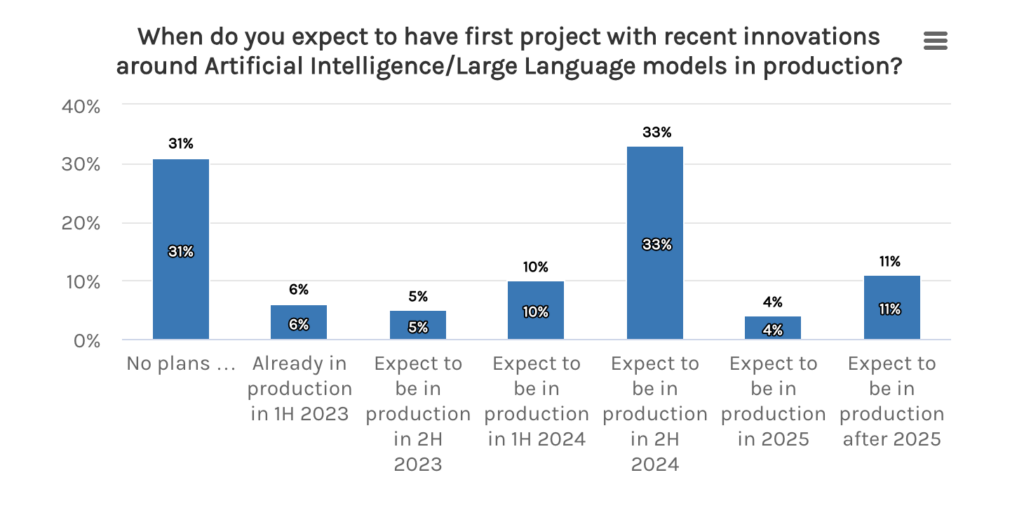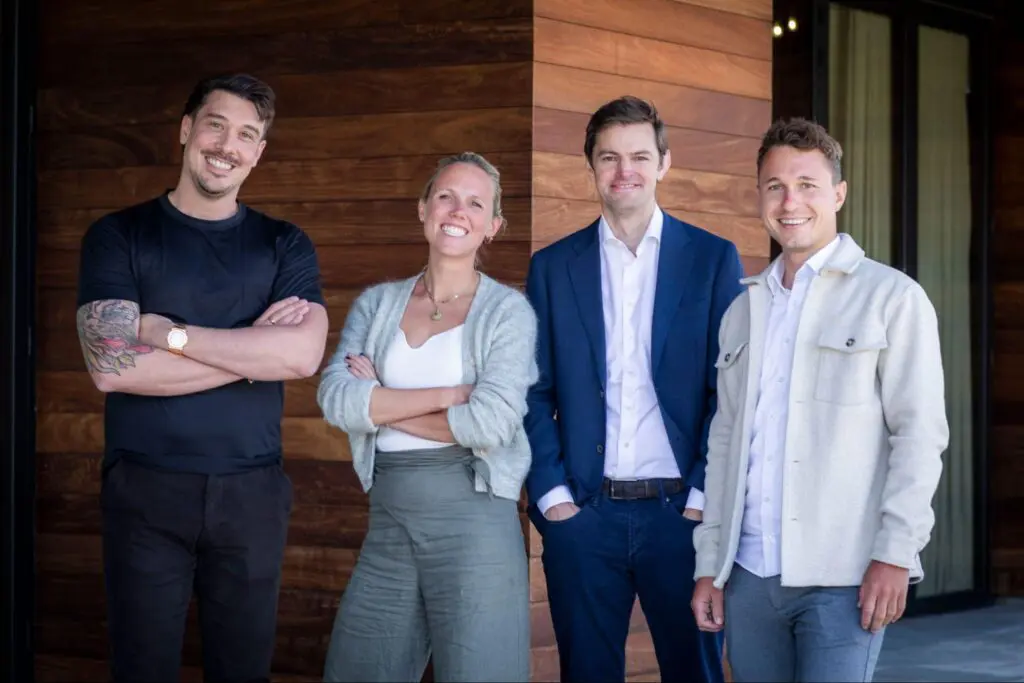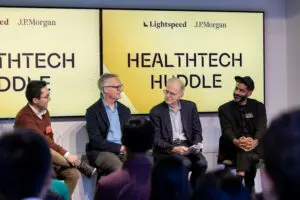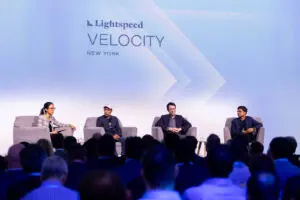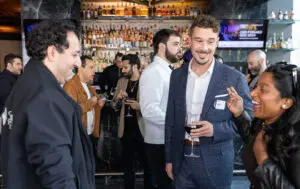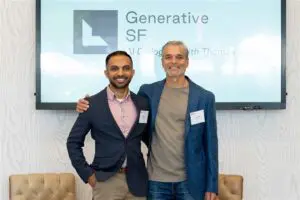Events
EXPLORING THE MINDS
OF VENTURE
Overview
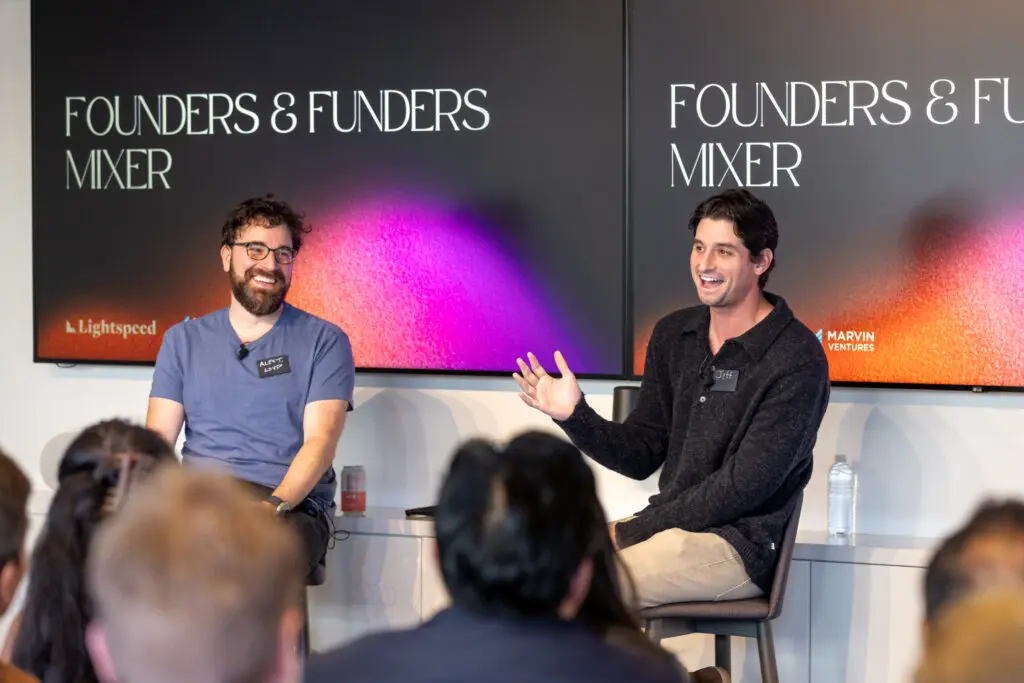
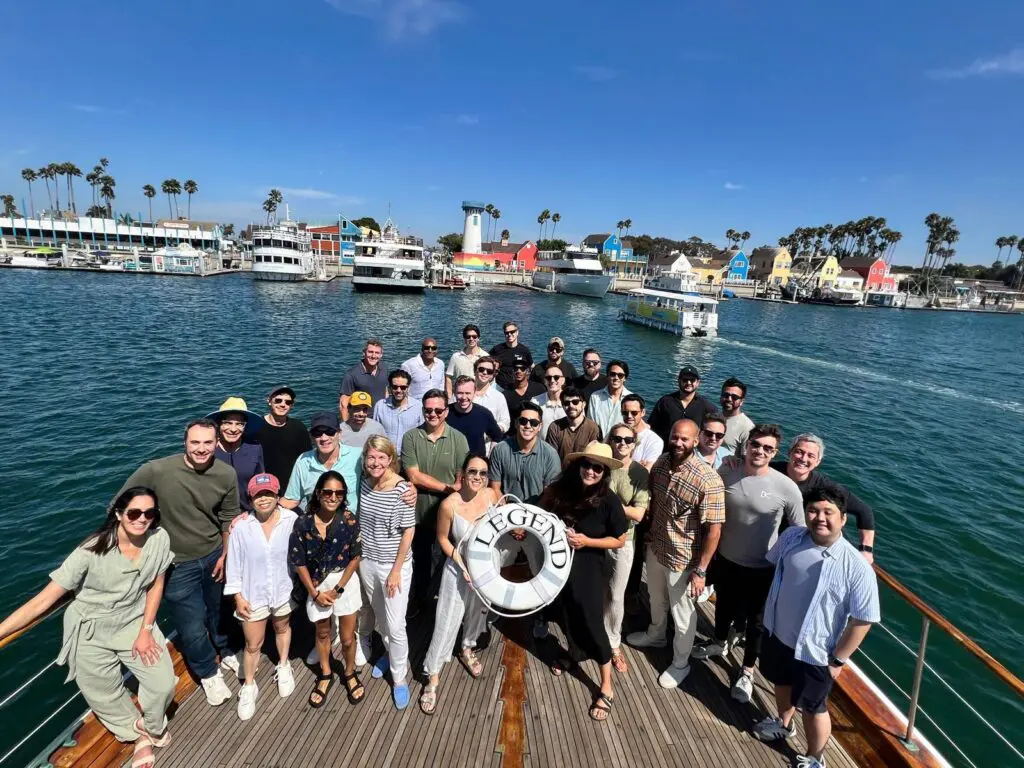
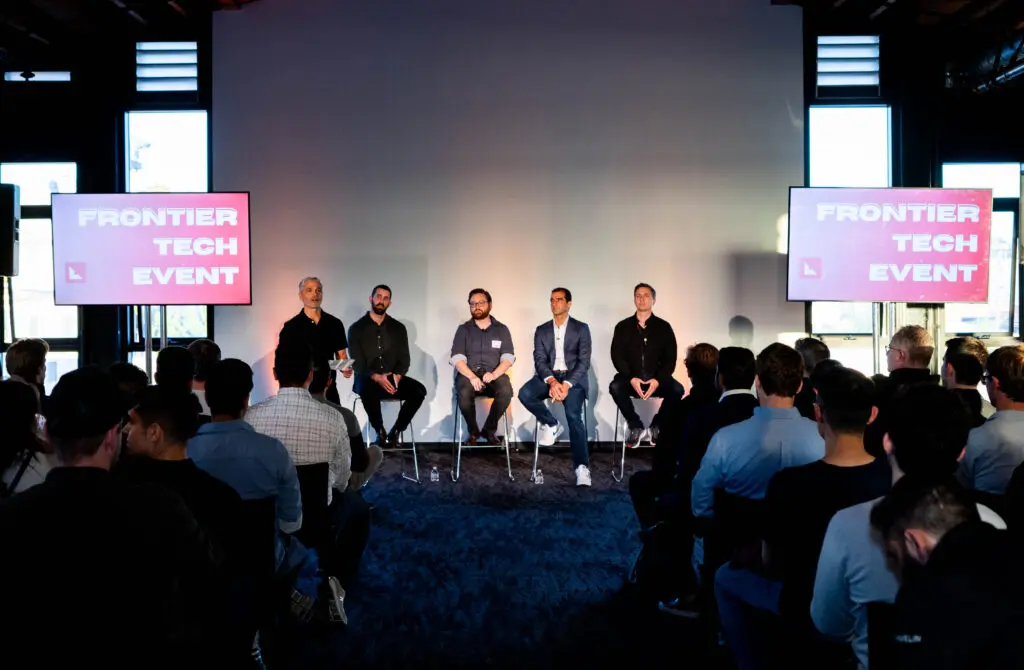
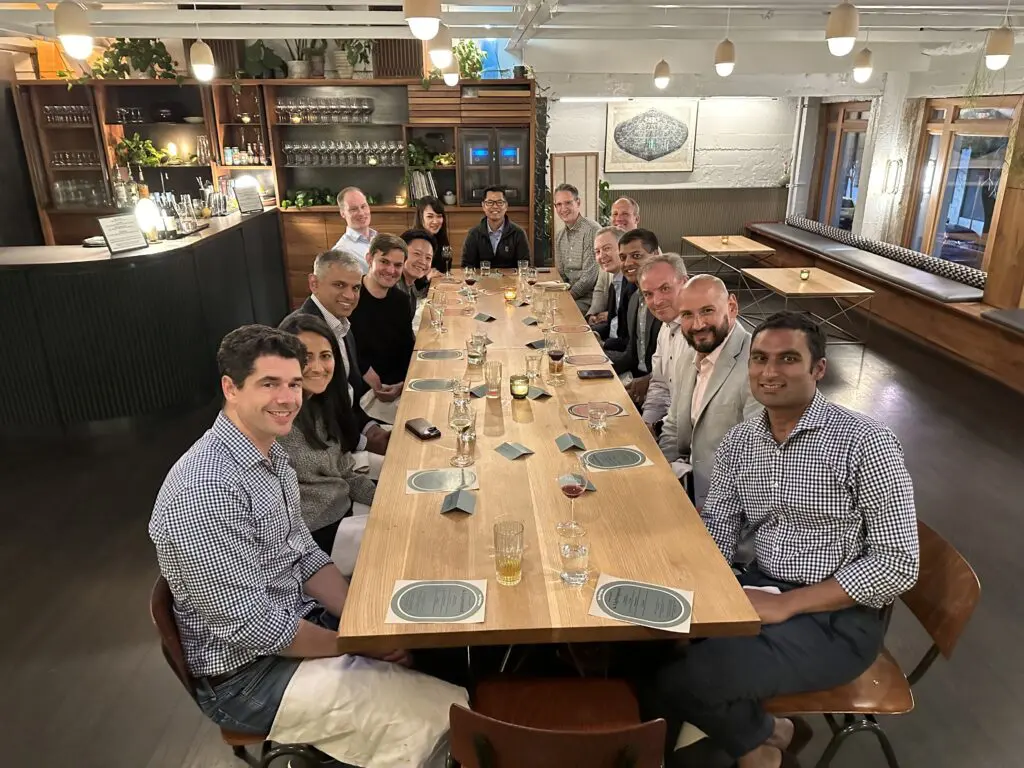
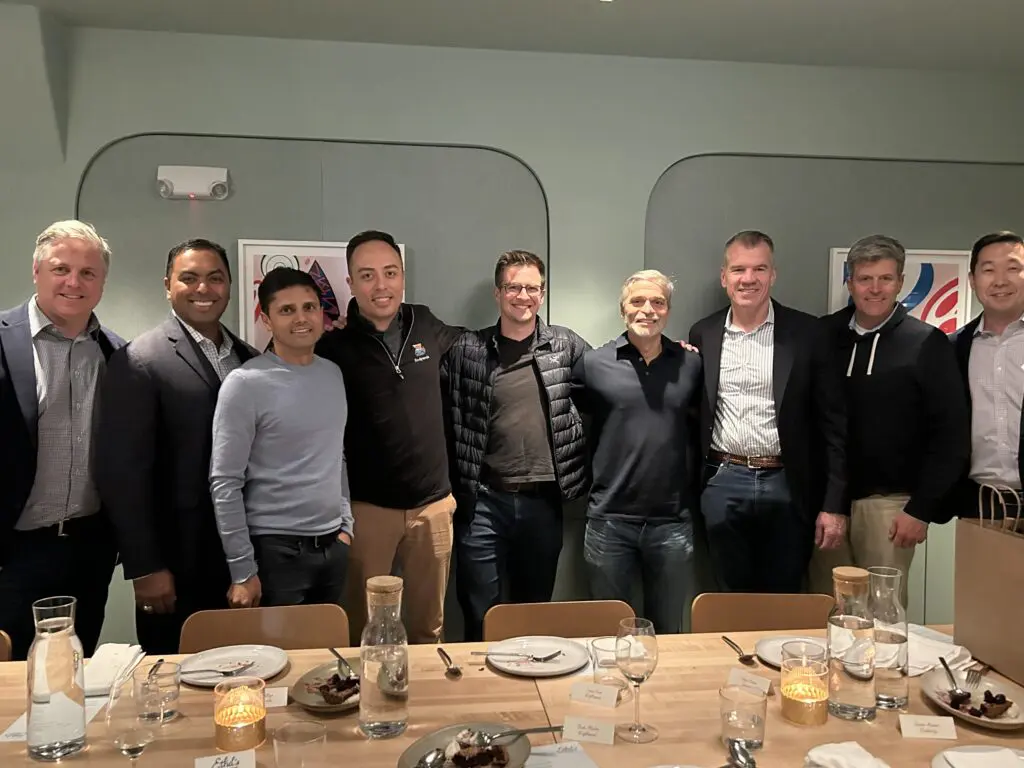
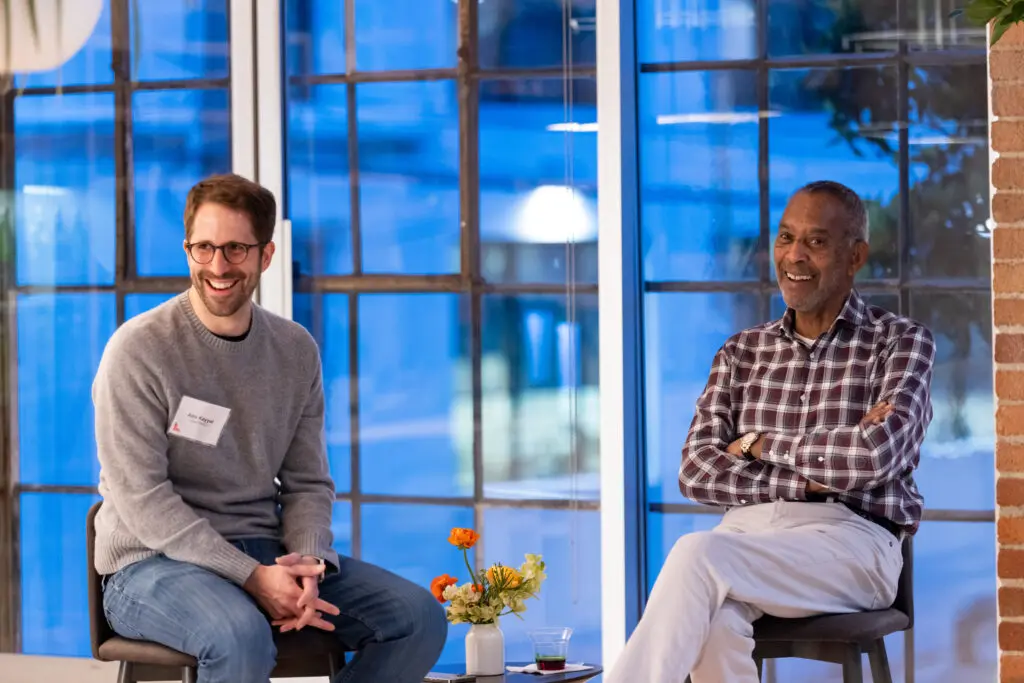

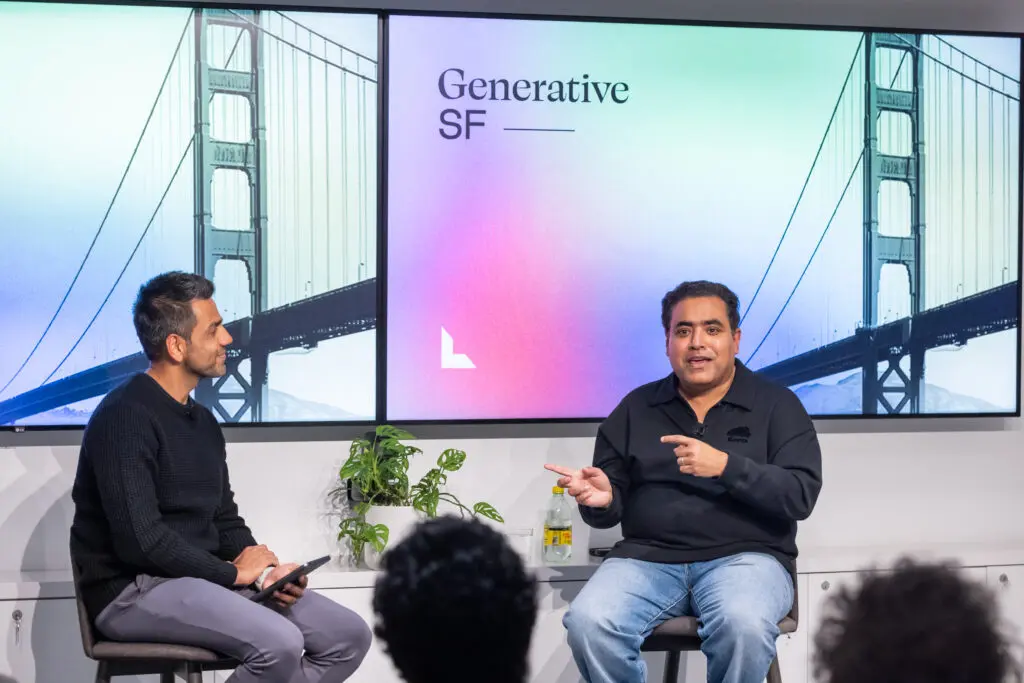
What’s next on the frontiers of crypto, AI, and blockchain
A conversation with Coinbase’s Head of Machine Learning, Rajarshi Gupta, on how AI, crypto, and blockchain are reshaping value exchange, data security, and the future of decentralized tech.
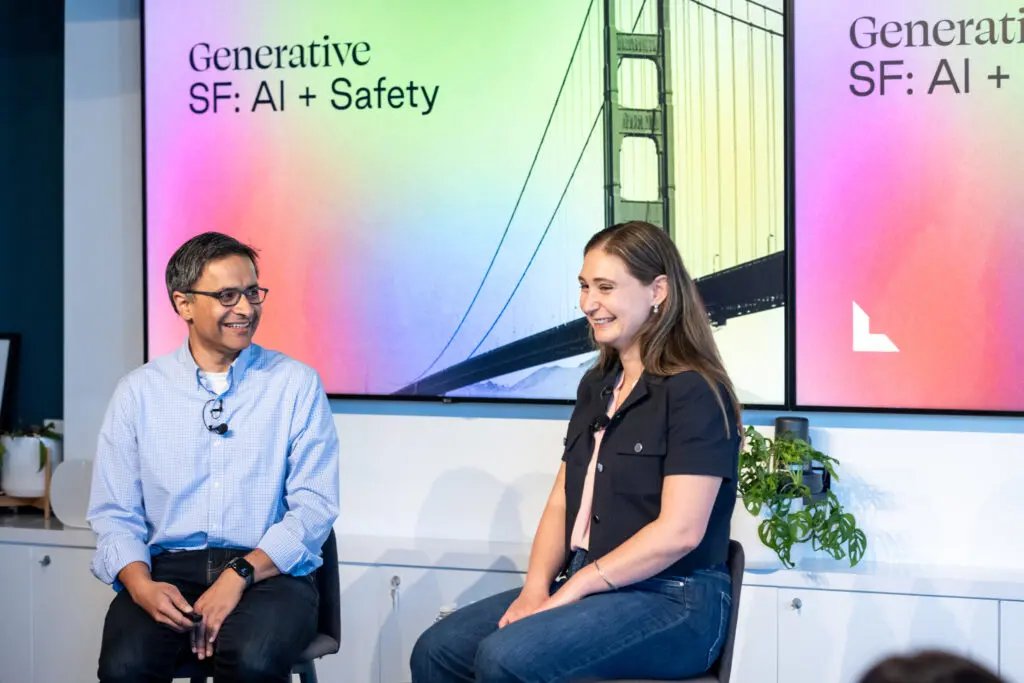
How Anthropic is building better, safer AI models
At our most recent #GenSF event, Anthropic co-founder Daniela Amodei reveals the secrets of her company’s wild success.
The path to AGI
These AI models have become incredibly powerful. How far along are we on the path to artificial general intelligence?
People used to imagine a future where tools are better than humans at everything and ask, ‘What would it be like to live in such a world?’ Well, in many ways, we already do.
Claude is a better coder than me, a better writer, way more empathetic and patient than basically anyone. And while all LLMs hallucinate, Claude’s body of knowledge far surpasses that of any human. So when we think about AGI, we like to ask, what are the practical implications of this? What will that mean for businesses, the economy, and individuals?
Our hopeful vision for the future is that these models will continue to advance, with guardrails in place to make sure no very bad things happen. Assuming we get that right, we continue to create a world where everyone can thrive and where people can do their most creative work without having to do all the boring stuff Claude is much better at.
Interested in attending a Generative Live event? Sign up here to receive notifications about future meetups, and be sure to listen to the Generative Now podcast, where AI builders talk about how they’re creating the future.
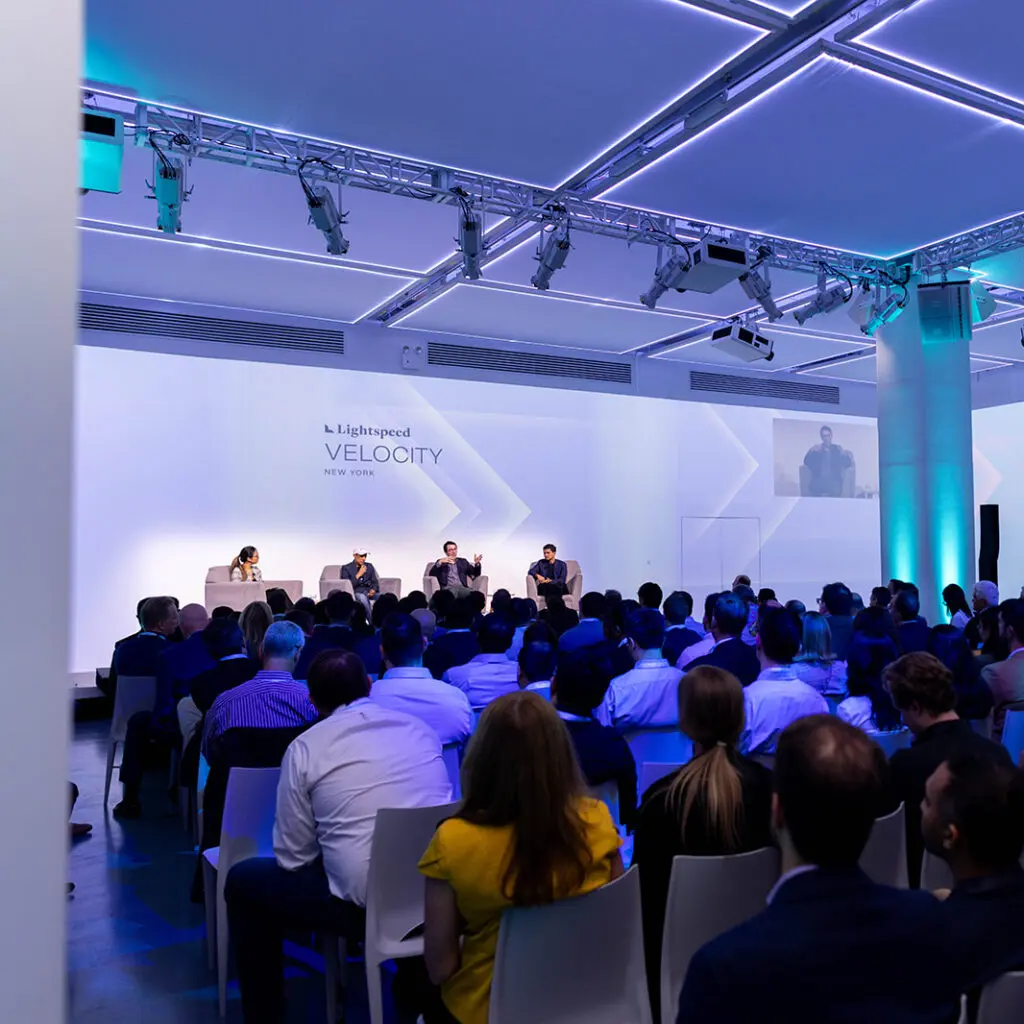
Highlights from Lightspeed Velocity NYC 2024
Insights on Enterprise AI from Moveworks, Snorkel, and Glean.
Last month, over two hundred people gathered at Velocity NYC 2024, Lightspeed’s flagship event for enterprise IT and innovation leaders. On the agenda? Learn about trends and insights driving disruption and shaping the future of enterprise technology, with a focus on enterprise AI.
The evening was anchored by an Innovation Showcase, featuring brief presentations from 12 early-stage enterprise startups that Lightspeed has invested in – including Blink, Descope, Endor Labs, Fiddler, Mistral AI, Patronus AI, P0 Security, Observo.ai, Redpanda, ScaleOps and Tessell – on their products and solutions, as well as a fireside chat on the state and future of AI in the enterprise, featuring repeat founders of emerging enterprise AI solution leaders, Arvind Jain, Co-Founder & CEO of Glean; Alex Ratner, Co-Founder & CEO of Snorkel; and Bhavin Shah, Co-Founder & CEO of Moveworks. The conversation was moderated by Lightspeed Partner Lisa Han, who has deep expertise in early-stage product-oriented startups, and yielded insights for enterprise IT and innovation executives, entrepreneurs, and investors.
Below are key takeaways from the discussion (that have been edited for clarity.)
Experimentation is key.
Asked to describe companies that are successfully integrating AI into their operations, Glean’s Arvin Jain described a “mindset” of “experimentation mode,” and the importance of trying out several approaches at a time.
AI needs to be specialized.
Large companies, Snorkel’s Alex Ratner said, “have to structurally optimize for the mass market flood of interest in big generalist models.” But to get differentiated business value from AI, businesses need to lean into specializing AI on their unique data. “Many of you are only going to succeed if you focus on specialist models that are accurate and efficient and cost effective at your use cases,” he said.
Startups offer independence.
There was extensive discussion over whether there exists an incumbent advantage in AI. But the panelists agreed that the contribution of new players would continue to be critical. “Obviously the hyperscalers will continue to benefit from this wave,” said Bhavin Shah of Moveworks, but “what startups give you is true independence.” While incumbent companies can build AI into their existing systems, making them “a little bit smarter, a little bit faster,” he explained, new enterprises bring the outside perspective to figure out how to optimize it in new ways, “to create these really rich experiences across all these application boundaries. That’s where we’re seeing a lot of innovation, a lot of investment, the kind of thinking around how to create new companies.”
AI’s value can be measured, but most companies aren’t doing that yet.
Ratner lamented that a lot of companies are still basing decisions about AI adoption on “vibes.” “Does this chat bot seem like it’s cool and exciting? And as many of us know, to cross the chasm from that flashy chat bot demo to real production ROI and value, you have to be able to measure that value, right? To convince many of you from finance, where we work with six of the top 10 US banks, you need to be able to actually give more than just a vibes check, right? To deploy something. So evaluation from the startup procurement to actual production deployment is super critical. And it’s not easy.” Ratner emphasized the importance of asking, “What is the actual success measure? How do we score it?” He characterized the prevalent mindset as “make it perfect and shiny, and then we’ll ship it over to the line of business. That’s how projects in AI fail. In my experience.”
One model cannot solve all problems.
Whatever the problem, Bhavin Shah of Moveworks advises using many models to get to the right solution. “Using GPT4 for everything is like taking a rocket ship to the grocery store,” he said. “It just doesn’t make sense.” Indeed, the same could be said for the challenges within enterprise AI itself. As Lisa Han said at the end of the discussion, the only way to solve the problems in enterprise AI is to “have a purview that is agnostic, which really paves the way for new entrants and new companies to own that workflow from end to end.”
In sum.
At every turn, the discussion revealed the crucial role of startups in innovating AI and in allowing the business world to stay flexible and creative in its approach to machine learning. In a post on LinkedIn summarizing the event, Alex Ratner captured the sentiment in the room, writing, “2024 is the year we all have to cross the chasm from flashy chatbot demo to real production demo – excited to cut a path through the hype together!”
Interested in attending the next Velocity event in NYC or SF? We’d love to see you there! Please add your contact information so we can be in touch.

Highlights from #GenNYC: PyTorch Co-Founder on The Evolution of PyTorch, celebrity attention for OpenAI, and the Future of the AI Race
“We haven’t really reached the upper level of intelligence,” says Meta’s Soumith Chintala.
In May of this year, OpenAI started making headlines for an unusual reason: the company held a live demo of its new ChatGPT voice assistant. The voice, named “Sky,” sounded a lot like Scarlett Johansson. The actresses’ lawyers sent letters to OpenAI asking the company to disclose how the voice was developed. Ultimately, OpenAI removed the voice — but not before raising a lot of questions with the general public around what’s fair game for AI.
Soumith’s take: “People in current society have rights based on various aspects: property, rights, copyrights, likeness rights. Some of those rights are being questioned by AI models. Various creative artists have been getting unhappy. I think we need moments like these to understand when AI is not expressing something that works according to current social norms. These moments are going to allow people to understand each other, organize with each other, and question the direction we want to go around preserving or not preserving these rights with generative AI.”
Ultimately, he shared, it’s one of many examples that will test how society responds to technology.
As Michael added, it could take a decade for this to play out in the courts. In the meantime, it will play out in the market.
Will the future be closed source or open source? It’s hard to say.
Given Meta’s focus, you might expect Soumith to be all-in on open source. But even he can’t say for certain what the future holds. Ultimately, each has its advantages and disadvantages.
“Open source AI is probably not going to be as well integrated and smooth as a vertically integrated product that uses OpenAI,” he shared. “But the advantages are that it’s way more democratized. Anyone can build a product around it without having to go through a bunch of agreements with a separate provider and doing things only in a certain way.”
In the open source category, he referenced the earlier example of AI accounting for local sensitivities. An AI provider based in California might have a certain set of biases that don’t work for a large part of the world. Open source AI can apply personalization to various markets much faster than closed source.
Right now AI is a capital game. But it might not be that way forever.
Towards the end of their conversation, Michael asked Soumith: “Can anyone compete with Meta on the open source side?” After all, this is a capital game. To train each model requires hundreds of millions of dollars. And Meta has a lot of capital.
Soumith’s take? “The current hypothesis around AI is that if you want to train a smarter model, you have to throw more data and compute at the model for it to get smarter. It’s not clear when it’s going to over-saturate. But it’s going to happen. I don’t know if it’s going to be a capital game until we capture all the energy in the universe.”
If AI stops being about the capital game and starts being about something else (like human feedback), it’s very possible that other open source companies will start catching up.
Interested in attending a Generative Live event? Sign up here to receive notifications about future meetups, and be sure to listen to the Generative Now podcast, where AI builders talk about how they’re creating the future.
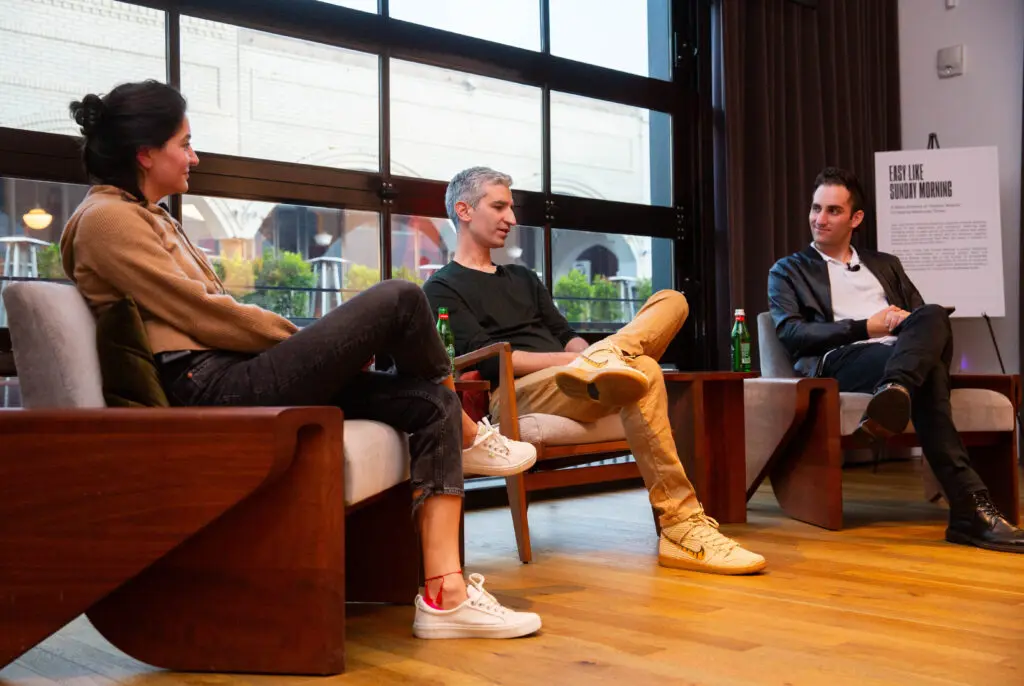
Highlights from #GenLA featuring insights from Discord and Linktree
Last month, Lightspeed hosted the latest in its Generative Live event series in Los Angeles, a fireside chat with Peter Sellis, Senior Vice President of Product at Discord, and Farnaz Azmoodeh, Chief Technology Officer of Linktree. Lightspeed has been investing in AI for over a decade, and launched the meetups to bring together founders, builders, and investors working in the generative AI space to trade ideas and learn from each other.
The panel was moderated by Lightspeed Partner Faraz Fatemi, who focuses on investments in consumer platforms. Below are key takeaways from the discussion (that have been edited for clarity), with a focus on three aspects of AI in particular.
Leveling the playing field.
While reflecting on the challenges of integrating AI into their business workflows, Azmoodeh and Sellis both expressed how much the technology has leveled the playing field. At Discord, the company hasn’t historically been focused on deep machine learning, Sellis said. “And then along comes these last two years of AI,” he continued, “where off-the-shelf stuff is as good as 90% of what’s out there” and allows companies to build capabilities they couldn’t previously have afforded. “Before you had to justify, spin up resources now you can be like, ‘What if we just plug it into this off-the-shelf model?’ And it’s 90% of what we would’ve done on our own, but 10x quicker to a prototype. I think that is really exciting, and we’re soon going to start seeing the results of that soon.”
For her part, Azmoodeh shared a similar perspective related to Linktree: “When I think about how we can lean into AI on Linktree as a product, it really comes down to how we can empower small businesses and creators to take advantage of AI,” she said of how their customers use the service to improve their social media presence. “We don’t have a large army of ML engineers or a team of AI experts, but it has become so much easier to get something impactful out the door with commercially available resources.”
A lesson for early-stage startups.
The first wave of AI was often just “technology in search of a problem,” Sellis said. “Oh my God, this is so cool. Look at what it can do,” he said of many early ideas—such as virtual partners—which, to be honest, many people had at almost exactly the same time. “It’s a cool idea, but it’s literally the first thing on everyone’s mind — we all watched the same movie,” he reiterated. But then people became a little more pragmatic and turned their efforts towards mundane business problems. “And so you had all these people who go from zero to 15 million in ARR purely on the efforts of answering support tickets faster than your existing people. And you’re like, ‘Yeah, that sounds good. Let’s do it.’”
AI’s potential.
Sellis and Azmoodeh, who previously worked together at Snap, were both excited to witness how AI will help people better express themselves—a desire shared by much of humanity. Both fondly remembered when Snap introduced beautification features, controversial as they can sometimes be. “What they did was make a whole crop of people who weren’t comfortable expressing themselves, just a little more comfortable expressing themselves,” Sellis said, pondering the ways AI will hopefully do something similar.
Following that thread, Azmoodeh emphasized that AI, like any tool, has special potential to empower those who use it. Speaking of Snap’s filters and Bitmojis, she shared that they personally helped her better tap her own sense of humor. Then, after teaching her in-laws how to use them, she witnessed how her family became more playful in their communication. “They’ve become funny and goofy on Snapchat and we have different conversations as a result,” she said, appreciating the ways the technology has enriched their relationship. Hopefully AI will have a similar effect.
Interested in attending a Generative Live event? Sign up here to receive notifications about future meetups, and be sure to listen to the Generative Now podcast, where AI builders talk about how they’re creating the future.
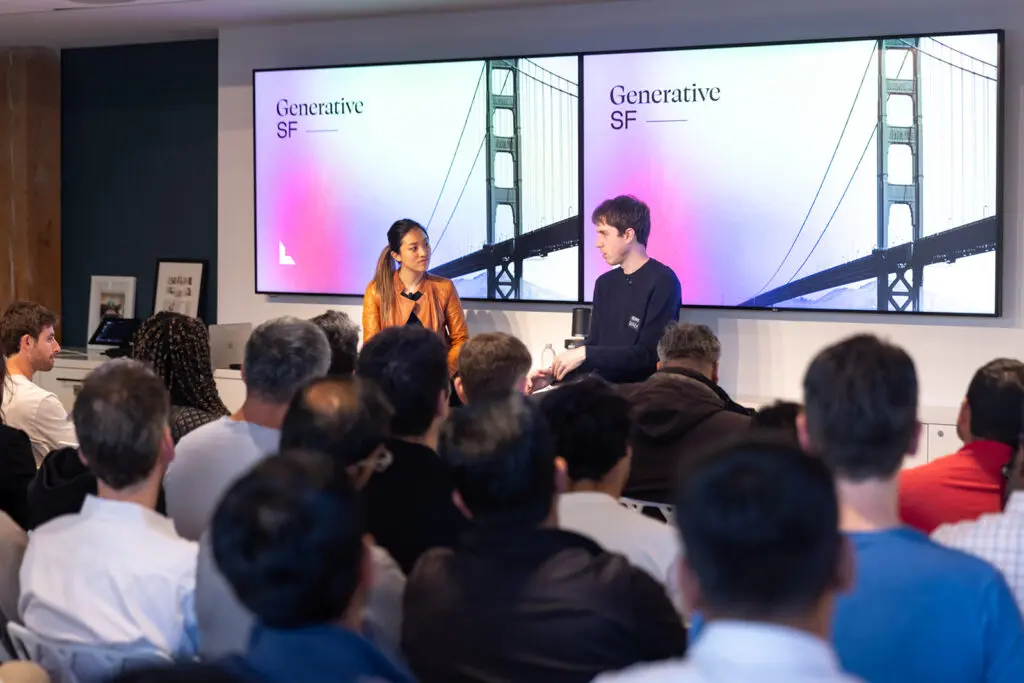
Highlights from #GenSF featuring Adam D’Angelo
We spoke with the CEO and Co-Founder of Quora about his new Poe chatbot platform and the future of the AI market.
In 2008, Adam D’Angelo left his job as Facebook CTO to co-found Quora, which rapidly became one of the most influential sources of information on the Internet. Each month, Quora serves up questions and answers across a diverse range of topics for more than 400 million users.
In December 2022 he launched a new AI platform from within Quora called Poe. This chatbot aggregator enables users to build their own bespoke chatbots based on nearly two dozen foundational large language models (LLMs). And as a board member of both OpenAI and Asana, Adam has a unique perspective on what it will take to succeed within the burgeoning generative AI economy.
Adam graciously agreed to take time from his hectic schedule to be the featured guest at one of our monthly Generative Live meetups in San Francisco and recently sat down with Lightspeed Enterprise Partner Lisa Han to talk about how Poe got its start, the value of experimentation and exploring different market opportunities, and where the AI market is headed.
Below are some highlights from the conversation (edited for clarity and brevity.)
How did Poe get its start?
About two years ago we could see the LLM wave coming and began experimenting by using GPT3 to generate answers to questions on Quora. We learned that the real strength of AI was not in substituting machine-generated answers for human ones, but the ability to instantly generate an answer to any question. It might be at a lower quality than you’d get from a human expert, but it would be valuable in cases where you couldn’t wait for an answer or afford to pay for one.
When we looked at the potential for this technology, we decided that the right form factor should be more like a private messaging app than of a social network or a platform like Quora. Now Poe serves as a recommendations engine for people to find the best models and the best apps built on those models.
What advantages did you gain by launching Poe from within Quora, instead of creating a new company?
The main advantage was speed to market. We actually started out by building Poe within Quora, until we realized it should be its own app. Then we experimented by taking 10 great engineers from Quora and assigning them to work on Poe, which turned out to be a huge advantage. I think if we had tried to recruit an equivalently good team for a new company, it might have taken a year or two, and then the opportunity would have been gone.
The other advantage was distribution. A significant percentage of Poe users found out about it because of Quora, and that was during a time of fierce competition in the AI aggregator space. There were a ton of products entering the market and we were able to pull ahead of them, partly because we’d invested more with better people, but partly because we had this distribution advantage. We might have been able to do something similar with a new company, but it would have been more difficult.
In the past you’ve said that the best consumer companies are built in tandem with a shift in technology. Can you elaborate on this?
A lot of times you look at a successful startup and ask, why didn’t anyone try anything like this earlier? And a lot of the time the answer is, it wasn’t technologically possible. YouTube is an example of a platform that wasn’t possible until broadband Internet adoption and the integration of Flash into web browsers. Social networking was the result of high Internet penetration among kids. Mobile phones made Instagram possible, and the GPS in those phones is what allowed Uber to be built. There are some exceptions to this, but in general you’ll have a much higher success rate if you’re doing something that’s newly become possible. Now LLMs will create new opportunities in the consumer market.
There seem to be two types of AI startups: AI research labs attempting to commercialize their work, and startups building apps off of that research. Which one matters more in today’s market?
I think there are opportunities for both. For example, if you’re creating an image-generation model with an API, it can be used as a building block by dozens of applications like games, image-editing, presentation software, and so on. You can build a very good business off an image-generating model. Right now, my bias would be toward the model companies, in part because it’s unclear what the right applications are going to be. If you build the right model, an entire ecosystem of applications can develop around it. If you focus on apps, you might have to invest in ten of them before you hit on one that actually works.
You’ve been on the board of OpenAI since 2018. What are some best practices you’ve seen there that others can adopt?
One thing that worked very well for OpenAI was placing a lot of bets and doubling down on the ones that worked. If you go back to when I joined the board, they had five different research streams going — fundamental research in robotics, algorithms, machine learning, and language modeling. And when the GPT paradigm took off they sort of focused the whole company on that. I think the lesson is that if you keep trying enough things, you’re more likely to get a hit.
Where do you see the AI market going forward? What’s been overhyped, and what hasn’t received enough attention?
The market is obviously optimistic about a certain category of AI companies, which are benefitting from fierce competition between investors and receiving super high valuations as a result. But I think there’s so much potential in AI that won’t be hard for these companies to become successful enough to turn those into very good investments over the long haul. The bad part of this is that the market seems to be ignoring everything else. No one wants to fund anything that isn’t AI. That’s irrational but understandable. If you’re an entrepreneur, you probably want to pay attention to those market signals.
Interested in attending a Generative Live event? Sign up here to receive notifications about future meetups, and be sure to listen to the Generative Now podcast, where AI builders talk about how they’re creating the future.

Generative NYC: How Etsy uses AI to keep commerce human
Josh Silverman is not only the CEO of Etsy, one of the world’s most beloved companies, he was also a co-founder of Evite and has over two decades of leadership experience growing consumer technology companies and scaling global marketplaces.
At Lightspeed’s most recent #GenNYC event, Partner Michael Mignano and Josh Silverman discussed the future impact of AI on creativity, marketplaces and SMBs, and how companies today have much to learn from the technological shifts of the past.
Below are some of the evening’s main takeaways. Comments have been edited for clarity.
People are always skeptical at first.
Reflecting on his early days building Evite, which he began working on in 1998, Silverman recalled, “there was this thing called the internet that some of us thought was going to change everything and most people thought, ‘That’s just a bunch of hoo-ha from Silicon Valley.’”
Most consumers need time to learn how to use new technologies.
In the beginning, Evite was only used by nerds who didn’t care how their invitations looked, recalled Silverman, laughing, because “that’s who was using the internet” back then.
Moving out of that niche was hard. “So many people you wanted to invite didn’t have email,” Silverman recalled, musing on the challenges of wide adoption for Evite. “Most people didn’t have broadband internet access, which caused the experience to be pretty inferior. And so a lot of people threw up their hands and said, ‘See, I told you this can’t be done.’ Those were obviously very solvable problems, and the world would come around.”
“Where I’m going with this,” Silverman said, acknowledging the technophilic crowd, “is obviously a lot of you probably are very passionate and you meet skeptics everywhere who say, ‘This whole AI thing is a bunch of nonsense that’s going to amount to nothing. And the reason is, I used it yesterday and here’s the reason it failed.’
I do think that [AI] is a massive platform shift. I do think it will change the world in some very powerful ways.” However, he cautioned, such shifts take time, describing “consumer adoption and consumer readiness” as “the laggingest thing.”
“The technology gets there a lot faster than consumers know how to use and adopt the technology. That’s what we’re finding at Etsy with Gen AI. There’s so many wonderful ways to use it, but when we just put a chatbot in front of a customer and say, ‘Here’s a way to search Etsy in a really interactive, really context rich way,’ they’re kind of like, ‘Ah, I don’t know how to do that.’
Silverman noted that, even though Etsy’s experiments with Gen AI chatbots aren’t resonating with shoppers at this very moment, “it’s important that we keep doing it because we’ve got to learn. I know customer adoption is going to get there. Customers are going to learn how to use it and we’re going to learn how to present it to them in the right way and in the right place.”
Machines can help your company be more sensitive to consumers’ individuality.
“So to give some sense of scale, we have about 7 million sellers on Etsy and right now about a hundred million things for sale, serving about 92 million buyers. And every one of these hundred million things for sale on Etsy is a snowflake. It doesn’t map to a catalog. And so we have to understand what is this thing, and then we have to understand you.
What are you looking for? What is your sense of style and taste and that kind of much, much higher-level abstraction of, what is this thing, what style does it represent, what preferences do you have. Literally impossible years ago.
It’s only because of these machines that we can keep commerce human.”
AI and machine learning are revolutionizing search.
“Understanding what you meant, not what you said, has been a very big part of our journey. And so when I write ‘cocktail attire for men,’ our search engine in 2016 and 2017 would’ve looked for listings that include the words ‘cocktail attire’ and ‘men,’ and ‘sport coat’ has none of those, right? So we would’ve done a terrible job.”
AI can help protect creatives.
We want to reward people that were the first innovators. And I think Gen AI is going to help us to, at scale, identify what’s original and what’s just a copycat. It also, I think, can help us to come to a better point of view around quality. Is this actually handcrafted or is it not? Across a hundred million items, there’s no number of humans you could reasonably hire to do that. But with modern machine learning techniques, we’re getting better at it. For example, does this same item exist for sale on Alibaba or Amazon or Temu? And [if so], we can presume it’s probably not handmade, and we take it down automatically. Even three or four years ago, that would’ve been a hard problem. Now it’s not that hard. The world’s getting better.
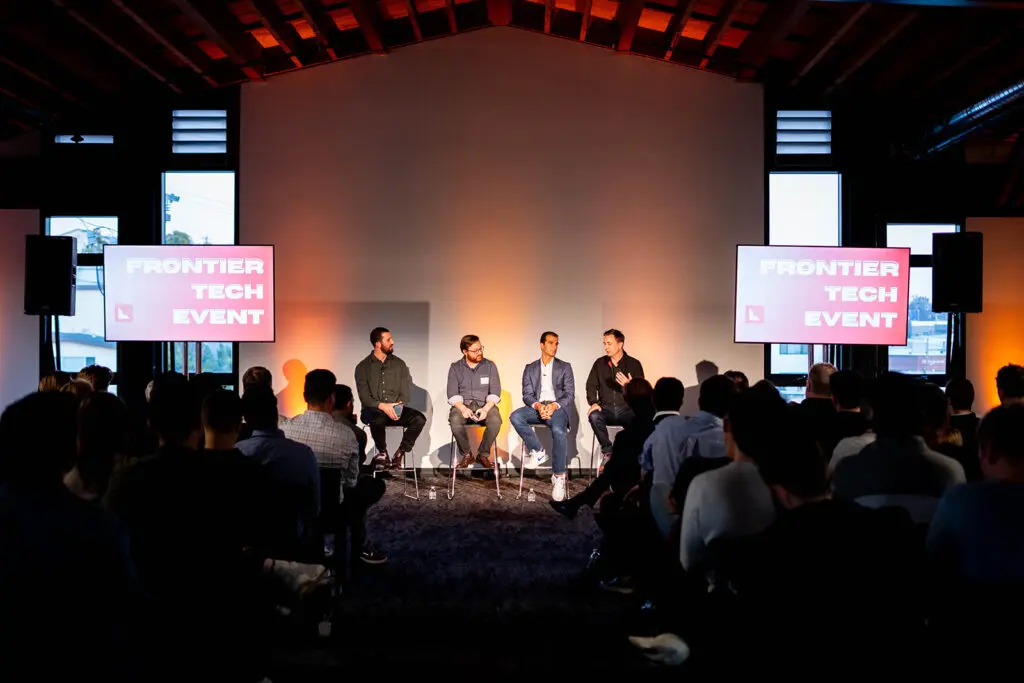
Founder insights on the future of Frontier Tech from Anduril, Saronic, and Astranis
Lightspeed has an extensive history of investing in foundational technologies globally, including Anduril, SpaceX, Saronic, Dexterity, Kodiak, Aurora, Reliable Robotics, Supercritical, and Nest. And we’ve been investing in frontier tech companies for nearly a decade, building a portfolio of close to 50 companies across the sector with over $680 million invested to date.
Earlier this month, Lightspeed hosted its inaugural Frontier Tech event in the heart of El Segundo. Over one hundred of LA’s top frontier tech founders, operators, and investors came together to discuss the future of civilization and technology’s role in shaping it.
Lightspeed Partner Connor Love led the evening’s discussion with Brian Schimpf, CEO of Anduril, Dino Mavrookas, CEO of Saronic, and John Gedmark, CEO of Astranis.
The CEOs shared insights leading their frontier tech companies, including their approaches to AI, complex go-to-market strategies, and the challenges of building highly technical products. Below are three of the evening’s main takeaways. Comments have been edited for clarity.
Smaller is often better—and more nimble.
“When I started doing this, around 2007, it was absurd that any new company could do anything in defense. It was like, obviously, Boeing will solve all of our problems,” Schimpf told the crowd at the start of the discussion. “It’s just really crazy how much the conversation has changed” in favor of smaller, nimbler companies.
So what changed?
“The pace at which Silicon Valley has innovated—particularly on software and IT technology—has completely changed the model of how the DoD operates. For the first time they are buying technology in a free market commercial strategy at scale, compared with the historic approach of measured research and development over a five-to-ten-year period. They’re now saying, what can you do for me in a year? I will buy $100 million worth or $30 million worth. That’s actually a very big deal.”
Mavrookas agreed that the primes aren’t “building capabilities to prove out new operational concepts to the government,” which is a gap he filled with his approach to designing boats for the U.S. Navy.
Gedmark then put things in terms of satellite companies. “The major satellite manufacturers, which are also coincidentally the major defense primes—Boeing, Lockheed, and Northrop—they really don’t make investments in new products anymore on their own dime, right? They wait until there’s a U.S. government program that will pay them a ton of money.” With new attitudes emerging in the defense industry, however, there are openings for smaller companies to take initiative.
Treat the defense industry like a partner—and speak their language.
Mavrookas emphasized that his company treated the U.S. Navy as a design partner from the beginning. “We sat down with the Navy and asked, What mission are you trying to accomplish? What do you actually want to do with these boats? What are the constraints and restraints that you have? How far do you need them to go? How much power do you need to provide? Help us understand the mission setting, then we’ll go build a boat around the mission, not the other way around. And so, bringing the Navy in as a design partner, and working with the end users was by far the most valuable thing for us.”
But speak your customer’s language, Gedmark advised before recalling a story of an industry conference he attended early in his career, when he and his co-founder were still working out of their apartment. It was a smaller conference attended mostly by senior executives at major defense companies who, as it turned out, were eager to hear about the smaller, more nimble satellites he was designing. “Many of those executives,” Gedmark remembered, “were highly technical. And as soon as we sort of got into the meeting, they wanted to riff on the technical specs most interesting to them: frequency bands, coverage areas, EIRP levels. It’s really important to be able to talk at that level with your customers.”
In order to maintain defense superiority, we need to build more.
“In modern history global power has been determined by naval power, and naval power has been determined by who has the most ships,” Mavrookas recalled once being told by a four-star Navy admiral. “During World War II we were the most powerful navy because we had the most powerful shipbuilding industry.” The solution is restoring sophisticated industrial capacity in the U.S.— which could be fertile territory for new startups. “Next generation manufacturing, especially for aerospace and defense, is extremely ripe,” Schimpf said. “How do you actually design, build, and produce systems at scale in a modern way? That area is completely underserved.”
At Lightspeed, we believe advancements in technology are fundamentally transforming the world. Artificial intelligence innovation has accelerated this change, but other core technological developments like advanced robotics, alternative energy sources, and cheaper sensors are fueling a revolution in how civilization will function. As we continue to invest in transformative technology, we believe this frontier tech will only attract more exceptional founders like Brian, Dino, and John.

Generative AI and The Future of Interactive Media
Key insights from Disney Accelerator’s Bonnie Rosen and Garden’s Stephen Bell at Lightspeed’s latest #GenLA meetup
Lightspeed recently hosted our latest Generative AI meetup in Los Angeles, featuring a fireside chat with Bonnie Rosen, the General Manager of Disney Accelerator, and Stephen Bell, the Co-founder and CCO of the gaming studio Gardens. Lightspeed has been investing in AI for over a decade, and launched the meetups to bring together founders, builders, and investors working in the generative AI space to share ideas and learn from each other.
The fireside chat was moderated by LA-based Lightspeed Partner Moritz Baier-Lentz and the group discussed three main areas where AI presents unique challenges and opportunities. Below is a slightly edited transcript highlighting key takeaways from the conversation.
Recently there has been heightened concern about AI taking over creative jobs. Going forward, what does the coexistence of AI and human creativity look like?
AI’s greatest potential will come as an enabler of human creativity, not as a replacement for it. According to Rosen, this is Disney Accelerator’s mindset when selecting companies for the program. “Every single company we selected was chosen because it was a tool that could be wielded by the incredible creative minds at Disney.” She then recalled a lengthy conversation she once had with a group of creatives and executives about “how you can’t just use AI to create a voice,” because, simple as it might seem, there are so many different ways a character might say any given phrase. For example, something as seemingly unassuming as “Let’s go,” depends so much on the specific emotion called for from that character, in that specific moment of a particular the story—subtle human expression and unpatterned context that AI struggles to match. For that reason, AI is best used as a tool to expand our creativity, not replace it.
Bell, for his part, was skeptical of recent predictions that AI will replace creative workers. The technology is impressive but still prone to flaws such as hallucinations (a phenomenon in which a large language model’s perception of nonexistent patterns creates a nonsensical output). “[AI] lacks intention and desire,” he said, “which is the foundation of art and craftsmanship. I think you need real skilled operators and developers to be able to edit and refine the results that you get out of generative systems.” His highest hope for AI is that it will free humans from the most boring parts of their work, allowing them more time to focus on the creative parts.
With AI, what advantages do incumbents have over startups, and vice versa?
It should surprise nobody that big incumbents have significant advantages obtaining and processing data; often they’re the service providers in cloud computing and other functions needed for these tasks. In terms of gaming, incumbents like Epic or Roblox have the financial resources to acquire other companies that will help them grow and improve. However, incumbents are often “playing not to lose” while “startups are playing to win and can [therefore] afford to go all in,” according to Baier-Lentz. Or, as Bell described it, incumbents are “less incentivized to take risk” and sometimes stuck in a rut of only making incremental improvements. This creates an opening for startups that are laser-focused on solving problems in very specific, niche areas. This is the best way for them to capture market segment and perhaps become that next unicorn.
How can companies navigate the line between generative AI’s potential threats versus its opportunities?
This is a particularly important question for companies like Disney, which have vast catalogs of valuable IP vulnerable to theft by non-licensed users who use that material in ways that hurt the value of the original IP. Rosen pointed out the important service that copyright laws provide: “To protect human ideas and originality…it’s just mind-bogglingly beautiful, just that concept of how important it is to protect, honor, and value that.” According to both Rosen and Bell, it’s crucial to get ahead of new AI technologies and use them to expand access and exposure to IP while preventing it from being stolen and illegally profited from. Rosen said, “We are very much on the side of making sure that IP is honored, that every child, whether they’re from this generation or ten generations from now,” encounters the company’s IP in the ways that its creators originally intended.
Interested in attending a Generative Live event? Sign up here to receive notifications about future meetups, and be sure to listen to the Generative Now podcast, where AI builders talk about how they’re creating the future.
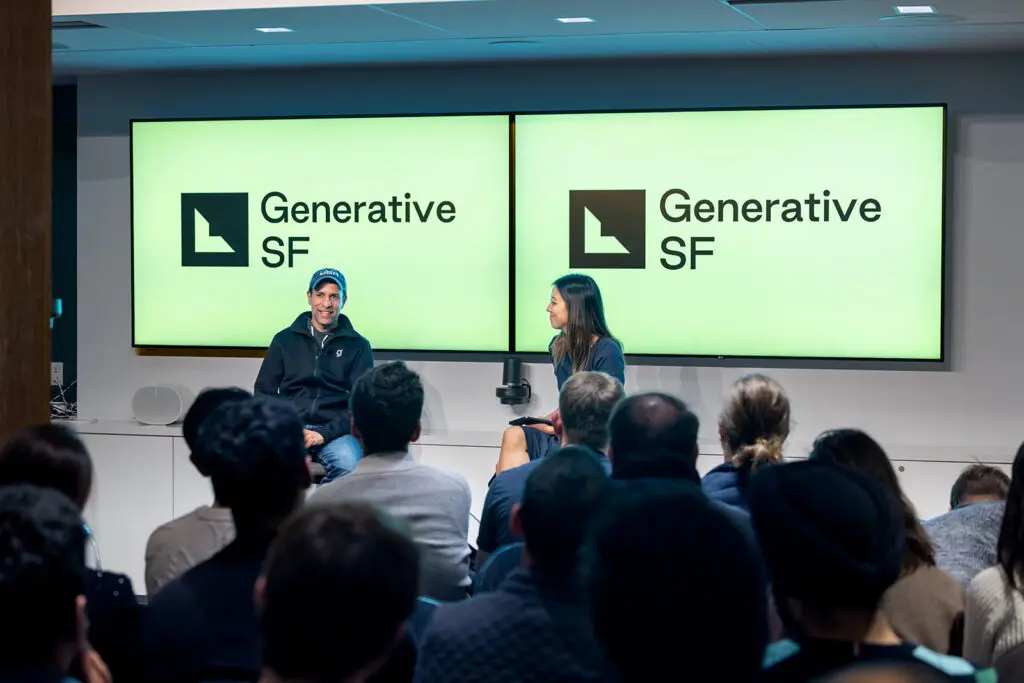
Generative SF: How to thrive in a crowded enterprise AI market
How can you gain a foothold in the enterprise AI market? Focus on value, says Glean's Arvind Jain.
Over the last year, Lightspeed has hosted a series of meetups around the country to talk about the impact of Generative AI. We recently had the pleasure of hosting Arvind Jain, Co-Founder and CEO of Glean, in our San Francisco office.
Lightspeed’s history with Arvind goes back two decades. He was a founding engineer of Lightspeed portfolio company Riverbed, and subsequently we had the pleasure of working alongside him as Co-Founder of Lightspeed portfolio company, Rubrik. In between Riverbed and Rubrik, Arvind spent 11 years as a Distinguished Engineer at Google, where he worked on early versions of the company’s large language models (LLMs) as part of its effort to improve the accuracy of Google search.
It was that early work at Google that led to Arvind founding Glean, an AI-powered work assistant that connects and understands all of an enterprise’s knowledge, to bring people the answers they need. Glean’s ultimate goal is to be the enterprise AI platform with a ready-to-use AI work assistant, as well as the tools to build custom generative AI experiences grounded in company knowledge.
In front of a packed house on a rainy Thursday night, Arvind talked with Lightspeed’s Lisa Han about some of the challenges inherent in launching a new enterprise AI startup, the secrets of hiring in an intensely competitive labor market, and how the quest for quality has to be every startup’s north star.
Here are some of the highlights of their conversation.
We are still in the very early stages of enterprise AI
Enterprises are excited by the benefits AI can bring to internal knowledge discovery, Arvind says. But they’re also wary of the security risks. As a result, adoption of gen AI tools within the office of the CIO has been much slower than it has among the general public.
“When people first saw ChatGPT, they thought ‘Hey if I have something like this inside my company, that can unlock levels of productivity we’ve never seen before,’” he says. “But it’s proven to be harder to deploy in the enterprise, because most of the data inside a company is private. You can’t just take all your company knowledge and use it to train a large neural-net-based model. Delivering safe and responsible AI is one of the most difficult things to do right now.”
Successful enterprise AI companies will deliver true business value
Companies that exist solely as a layer on top of an LLM like GPT4 aren’t likely to survive over the long term, says Arvind. They may initially help improve a company’s ability to quickly retrieve information, but successful gen AI startups will need to become more deeply embedded within an organization’s workflows and solve specific problems.
“We’re going to see a lot of platform-type solutions that enable internal teams that build products, as well as ready-to-use products for different functions within a company,” he adds. “Our customers see Glean as both an application that works like ChatGPT within a company, but also as a core platform that allows people to build new AI applications to improve their business processes.”
Hiring is hard, but perseverance pays
Hiring in a tight labor market is always a challenge; the explosion of AI startups, coupled with the shortage of experienced data scientists and machine learning engineers, makes it a nearly Herculean task. But hiring the right team at the start is essential to successful recruiting, and perseverance will eventually pay off, says Arvind.
“Recruiting for a startup is incredibly hard,” he says. “But my number one piece of advice is, never give up. Keep going after the people who say no to you at first. Keep in touch, build that relationship. Eventually you’ll have a core team of people who are celebrated in their field, and they’ll attract others.”
The opportunity to have a real impact on a company’s success is often the determining factor, says Arvind. It comes down to the role itself; whether someone wants to be a highly paid cog in an enormous machine, or a vital component in a small startup who can really make a difference.
Quality is your north star
When you’re building a company from scratch it’s often difficult to know where to focus your energy. It’s a classic business conundrum: You can build something that’s fast, good, or inexpensive, but you can’t do all three at the same time. So what do you prioritize? For Arvind, the answer is easy.
“When you’re in the initial stages of development for your product, you should focus on only one thing, which is quality,” he says. “It doesn’t matter how costly your system is right now, or whether it’s fast enough. The question is, does it do something useful? When we started building Glean, that was our first priority. The second thing we focused on was latency, and cost after that. That’s especially true if you’re relying on third-party LLMs, where you hope that costs will get reduced over time. That’s why ignoring cost and performance and getting the quality right is your best strategy.”
The future of Glean is ubiquity
Glean started out with the aim of becoming a ‘Google for your work life,’ says Arvind. Since that time, his vision for the company has expanded.
“We want to fundamentally change how people work,” he says. “We want Glean to be the personal AI assistant for every person within every company that offers help when you need it, but also anticipates what you need before you ask. All of us will have these really smart, AI-powered systems that will do a lot of the heavy lifting for us. That’s where Glean is headed.”
Interested in attending a Generative event Sign up here to receive notifications about future meetups, and be sure to listen to the Generative Now podcast, where AI builders talk about how they’re creating the future.

Four Areas of AI Opportunity, From Zefa Hakim of Yelp
Lightspeed recently hosted the latest in its Generative AI series in Los Angeles, a fireside chat with Zefa Hakim, Head of Products, AI, ML, and Data Monetization at Yelp. Lightspeed has been investing in AI for over a decade, and launched the meetups to bring together founders, builders, and investors working in the generative AI space to trade ideas and learn from each other. The panel was organized and moderated by the Lightspeed partners Faraz Fatemi, who focuses on investments in consumer platforms, and Moritz Baier-Lentz, who heads the firm’s gaming initiatives.
During the discussion, Zefa highlighted four areas of AI where he sees opportunities for entrepreneurs:
Companies with large or unique datasets can use AI to convert that data into entirely new revenue streams
Using Yelp as an example, Zefa highlighted the company’s vast datasets, including hundreds of millions of business reviews, user-generated photos and videos, and billions of consumer searches. Using AI, this data can be analyzed to identify new opportunities or risks, including changing consumer trends, a business, or location’s changing popularity, or identifying vulnerabilities to uncover insurance risks, or uncovering popular food or beverages for food and alcohol distributors. These insights are valuable to other businesses wanting to streamline their operations or pursue new opportunities. As a result, companies should always ask themselves how their data is reusable and how AI can help unlock its additional potential.
An area of AI innovation that’s still largely untapped is analytical capability
So far—and it’s still very early days—AI’s most visible impact has come in the form of summarizing or generating content, including images and video. However, as AI advances and becomes cheaper and more democratized, we’ll likely witness it becoming more analytically capable. Ripe for growth are AI-powered applications that help people make decisions, including shopping choices, social interactions, and other scenarios that involve context-specific coordination between multiple people and places (e.g. choosing what restaurant to visit for a particular type of experience). Other similar potential opportunities include the development of AI-powered tutors, coaches, mentor, and possibly therapists—among other services.
Established companies and startups can collaborate around AI
When asked how an established company like Yelp determines whether to build a new capability in-house or partner with a startup that’s developing that capability, Zefa highlighted the benefits of partnership—especially when the startup displays a novel approach. “More often than not,” Zefa said about past conversations with possible collaborators, “new AI companies are coming up with ideas that we haven’t even thought about. But, using our data and insights, they can build different kinds of solutions that can power bigger insurance companies, bigger banking companies, and things like that. So, we keep an open mind. If you have an idea, and you can use our insights and use our data to go build something new, we’ll listen and we’ll partner.”
Trust and Safety is one of the most important factors AI companies must consider
According to Zefa, it’s imperative that AI companies convince their customers that AI-related information isn’t being used inappropriately. This means having robust Trust and Safety programs, which he divided into multiple areas. First, companies must prevent fraud and abuse such as hackers stealing valuable data. Second, they should consider how to prevent misuse such as jailbreaking, in which users bypass restrictions or ethical safeguards placed around large language models, thus using them for purposes the owners of those models might wish to prevent. The third consideration is legal, ensuring that AI applications aren’t violating copyright laws and are sufficiently informing users that they are, in fact, using AI. Finally, companies must protect their brands. If companies create comprehensive safeguards and mechanisms addressing all four of these factors, their chances at success will increase exponentially.
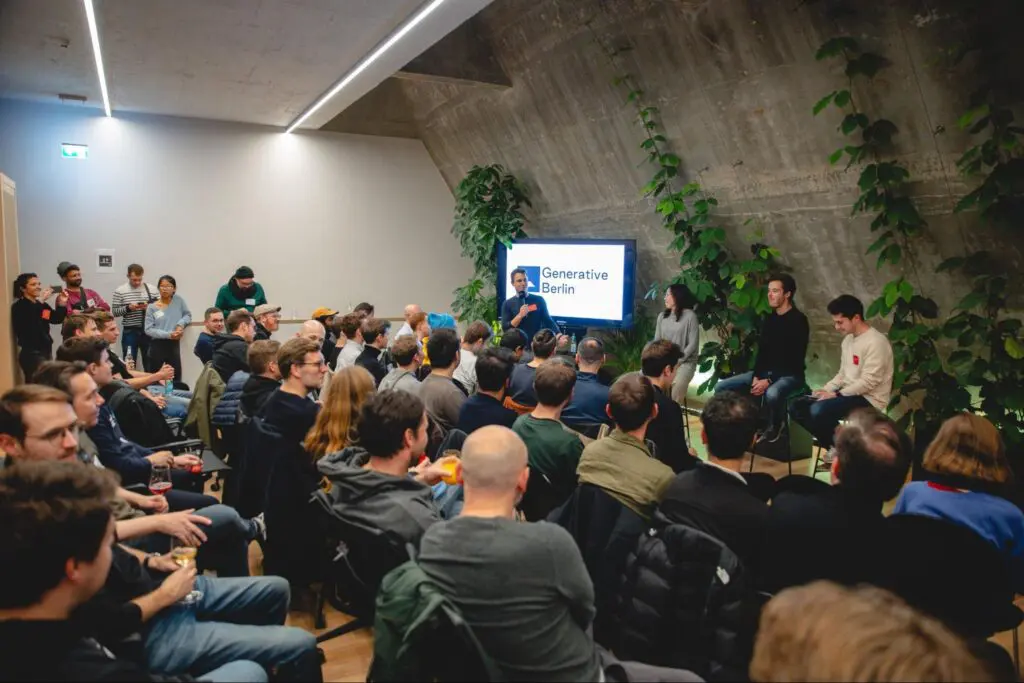
Taking LLMs From Proof-of-Concept to Production
The Generative Europe event series came to Berlin, where Lightspeed took the opportunity to officially open our new office there. At our Paris Generative meetup, we focused on the core infrastructure of building LLMs – so this time we moved up the ladder to discuss the challenges application developers face when bringing LLMs into their applications.
We were fortunate to be joined on stage by Ting Wang, Director of ML & AI at Wayfair, and Marc Klingen, Co-Founder of Langfuse.
Note: If you enjoy going down the rabbit hole like we do, sign up to be notified about our next Generative meetup, here.
Here are four takeaways from our conversation:
1. Experimenting with quick, iterative PoCs with nimble teams
When it comes to experimenting with LLM use cases, taking an exploratory approach is crucial. This is because the field is still in its early stages and there are numerous potential use cases. Ting emphasized the importance of being iterative, explorative, and comfortable with uncertainty.
As a result, the line between a Proof of Concept (PoC) and a Minimum Viable Product (MVP) becomes flexible, and involving early end-user feedback becomes inherent to the early stages of experimentation. This requires from incumbents much more flexibility in how they prototype and design their user experiences. The panelists unanimously agreed that teams experimenting with LLMs need to be interdisciplinary. Given the nascent nature of the field, engineers and scientists must closely collaborate in order to maximize productivity and unlock the full potential of LLMs. In this early stage, rigidly defined scopes can actually hinder progress rather than enhance it.
2. Choosing what to bring into production
The panel highlighted that for productizing LLMs, more traditional approaches can be leveraged. Having a clear understanding of the potential ROI is crucial for making informed decisions, particularly considering the high runtime costs associated with productized LLMs in large organizations. Ting shared her learnings from multiple years at the intersection of data and AI teams. She emphasized the significance of establishing decision-making committees that include not only business and product owners but also scientists. This inclusive approach is necessary to keep up with the rapid pace of development in this field.
The panel discussed that quality control in LLMs ultimately is still an unsolved problem. Consequently, bringing LLMs into production requires a greater willingness to take risks. Especially established enterprises with a high bar for customer quality need to be willing to take sometimes sub-par experience into account.
3. First use cases
Marc, who given his position with Langfuse in the value chain, sees a broad roster of startups as well as enterprises experimenting with LLMs, shared the most common use cases he sees close-to- or in-production. He emphasized that these are mostly use cases that allow for human-in-the-loop feedback with failure-tolerant users. Often they are centered around summarization, recommendation or entity extraction. These use cases have the advantage that model performance can be more objectively evaluated in contrast to more creative tasks where quality is often still perceived subjectively. In contrast, use cases that are directly user-facing are moving to production at a much slower pace due to the high-risk and low oversight. These observations are in line with the recent survey of CIOs from Morgan Stanely (1), where most AI applications are expected to be in production by H2 2024.
Ting shared that good starting points for first use cases are internal processes, where RoI is easier to be defined as well as a closer loop between end-users and development teams can be ensured. Naturally, workflows with high manual involvement but strong repeatability lend themselves as first in line. Concretely these can be use cases in service departments. In e-commerce Ting sees many organizations experimenting with recommendations, extending existing productized traditional ML applications.
The panel highlighted that for wider adoption of end-customer-facing applications, challenges around how to objectize subjective quality evaluation as well as defining a clear RoI and ensuring safety and security remained.
4. The importance of transparency through monitoring
On top of the highlighted stochastic nature of generative models, the panel discussed the importance of creating as much transparency as possible early in the development process. Ting highlighted that as teams are often in the early stages of understanding model behavior and having detailed logging and tracing helps in jointly developing a thesis for use cases. Marc shared how across the application developers he is working with it has become much more important to take an active role in engaging with models. Historically, observability solutions like Datadog have played a passive role in monitoring applications. Hence a new paradigm for application developers emerges: They use monitoring solutions like Langfuse to establish metrics to track across the application lifecycle and continuously monitor while rolling out in production. Observability becomes an enabler to iterate faster for new versions of deployed LLMs. Patterns observed from edge cases in production alter the data sets that the next version of applications is tested on.
We also took this as an opportunity to announce our latest investment into Langfuse. Marc and the team are supporting application developers in this journey of bringing LLMs into production. They are currently hiring their founding engineers.

Generative Europe Comes To London
Generative Europe has made its way to London. We’ve got a stellar lineup: two luminaries discussing the top trends we are seeing in AI.
We’ll be joined by Gemma Garriga, Director of Applied AI at Google and Meryem Arik, Co-Founder of TitanML. The panel will be moderated by Antoine Moyroud, a Partner at Lightspeed. Antoine, based in Paris, spends most of his time on data/ML topics. Prior to working in venture capital, Antoine worked at Dataiku and at Flixbus working in data science and marketing teams. He holds a Masters degree in data science from IE University.
Hosting the evening will be Lightspeed partner Julie Kainz. Join us on 13th November at 18:30, for our inaugural event at our London home. Sign up here.
Dr. Gemma Garriga, Director of Applied AI, Google
Gemma Garriga is a Director of Applied AI at Google, where she helps global businesses and startups to thrive in the world of AI and cloud computing. Gemma’s experience expands a variety of areas, from leading AI engineering teams in the financial and insurance sector, to growing tech businesses as an entrepreneur in the consumer space, to being in the weeds of machine learning as a hands-on researcher. Gemma is a passionate speaker for diversity, machine learning operations and enabling equitable societal models with technology. She enjoys championing early businesses that can have impact in the world, and serves as a venture and startup advisor of tech-driven funds and accelerators
Meryem Arik, Co-Founder, TitanML
Meryem co-founded TitanML with the vision of creating a seamless and secure infrastructure for enterprise LLM deployments. Meryem’s training was in Theoretical Physics and Philosophy at the University of Oxford. Beyond her contributions to TitanML, Meryem is dedicated to sharing her insights on the practical and ethical adoption of AI in enterprise.
You can apply for a seat at the London meet up here.
Both our Berlin and Paris events were oversubscribed, so be quick to get your spot! If you missed it, you can read more about the discussion that took place in Paris. We look forward to seeing you in London!
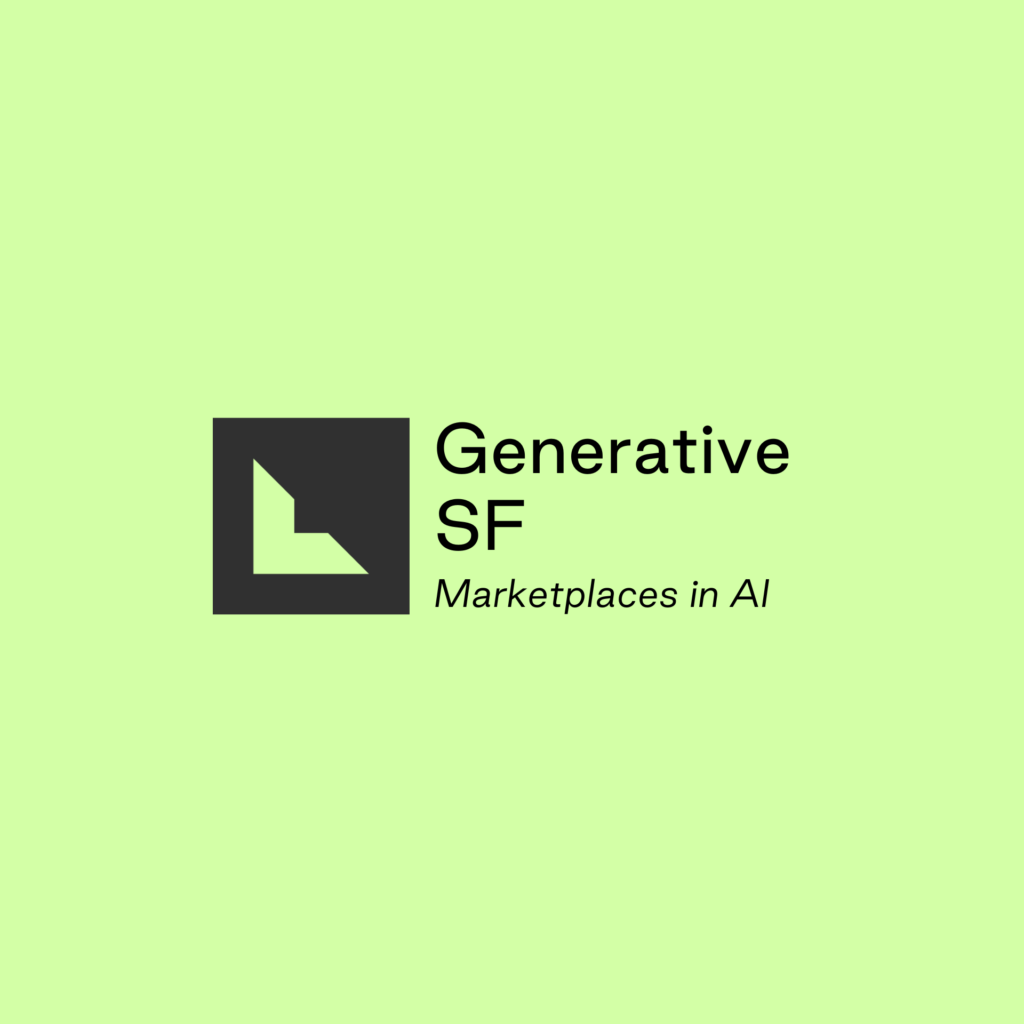
Announcing Generative SF: Marketplaces in AI
We are thrilled to announce the latest installment in our Generative series, where we will dive into the potential of AI in marketplaces. Our upcoming event, Generative San Francisco: Marketplaces in AI, is set to take place on Thursday, November 30th from 5:30-9:00pm at our San Francisco office. If you’re eager to join this conversation, we invite you to apply to attend.
This event promises to be an illuminating exploration of how generative AI is shaping the future of marketplaces. Our distinguished panel, moderated by Sydney Sykes, partner in Lightpseed’s consumer practice, will feature two prominent voices in the industry: Brandon Leonardo, Co-Founder of Instacart, and Chen Peng, Head of Data at Faire. The session will be introduced by Alex Taussig, co-head of Lightspeed’s consumer practice. These experts will offer unique perspectives on how scaling marketplaces are harnessing generative AI technology as a transformative opportunity.
The panel discussion will explore a range of intriguing topics, including the role of AI in personalizing the marketplace experience, enhancing recommendation systems, and optimizing supply chain management. We’ll also dive into understanding how growth-stage and public companies are using emerging technologies to continue to drive growth.
At Lightspeed, we have been committed to fostering innovation and knowledge sharing within the dynamic community of founders, product builders, and technologists who are shaping the future of generative AI technology. From NYC to LA to SF, Generative series events have been an opportunity to bring together thought leaders and innovators.
If you’re eager to be part of this transformative conversation and explore the vast potential of generative AI in marketplaces, make sure to sign up for Generative San Francisco: AI in Marketplaces on November 30th. Stay tuned for more updates, and we look forward to welcoming you to this inspiring event that is sure to shape the future of generative technology in marketplaces.

Generative Europe Comes To Our New Berlin Home
We are thrilled to bring Generative Europe to Berlin on November 7th: apply to attend here. The discussion will focus on embedding LLMs in your application. While we have seen the first successful demos and standalone products, the playbook for how to embed LLMs in your SaaS is still to be written.
During Generative Berlin, we will outline a first draft of the playbook:
- How do you choose the best model?
- How do you optimize the triangle of cost, quality, and latency?
- And how do you measure customer impact?
We are very fortunate to be joined by Ting Wang, Director of ML & AI at Wayfair, and Marc Klingen, Co-Founder of Langfuse.
Ting Wang is the Director of ML and AI at Wayfair, leading a global team based in Europe and US. Her mission is to turn ML/AI into the biggest advantage to improve efficiency across Wayfair’s supply chain and service operations. Currently, her team is actively building Convo AI applications for their service use cases.
Marc Klingen, is the co-founder and CEO of Langfuse. Being part of YCombinator and iterating on applications to build with Generative AI, Marc and his team quickly realized that a bridge between LLM infrastructure and applications is missing, leading them to launch Langfuse, which rocketed to Product #1 on Product Hunt. Marc brings a background in Computer Science & Innovation from Technical University Munich.
You can apply for a seat at the Berlin meet up here (and get a sneak peek at our exciting new Berlin home too!) Our Paris event was overscribed, so be quick to get your spot! If you missed it, you can read more about the discussion that took place in Paris.
Our new home in Berlin
We believe category-defining companies are built all across Europe — and ultimately require a pan-European approach to succeed. Hence we decided to set up where our founders are, and go hyper-local. So, we have added to Lightspeed’s Europe presence with a permanent home in Berlin Mitte. Come by!
We aren’t new to Berlin either. Alex Schmitt was born and raised in Germany. We have made many investments in Europe, and we count ourselves lucky to work with more than 30 companies based here, many of which are rooted in Germany, but with global operations. These include Personio, Plan A, Lemon Markets, Candis, Polar Signals, Mayd, Soba, Xentral, and more.
Some of our investment themes are geographically informed; for example, Germany is Europe’s engine for SMBs. That is reflected in the strong suite of vertical SaaS companies for SMBs in Germany. Hanno Renner, founder of Personio – the leading HR solution for SMBs, says ”Lightspeed — one of the few global funds — has been instrumental for how we shape our global presence at Personio. Having a local team on the ground helps us even more in our journey from a European to an international champion.”We always strive to build global champions, but along the way, there are local nuances and operational hurdles to overcome. Max Linden, Founder and CEO of lemon.markets adds, “We wanted to work with Lightspeed given the team’s expertise and their longstanding commitment to Europe. By combining a global platform with local roots, our partnership with Lightspeed allows us to simultaneously spar on a topic like leveling from someone that built Pinterest while receiving a deep reference on a candidate we are hiring in Berlin.”
“To build a category-leading solution, we need a strong local presence in all of our markets,” says Lubomila Jordanova, CEO of Plan A. “Lightspeed goes the extra mile with boots on the ground that can open doors in the most important markets for us — in Berlin, London, and Paris.”
As pictured above, there are several more Germans in the Lightspeed family: Moritz, who leads our gaming practice, and Sebastian, who is a partner in our growth team, grew up in Hannover. And Julie lived the first 10 years of her life in Munich! Alex is on the right.
To apply to attend Generative Europe in Berlin on November 7th sign up here.
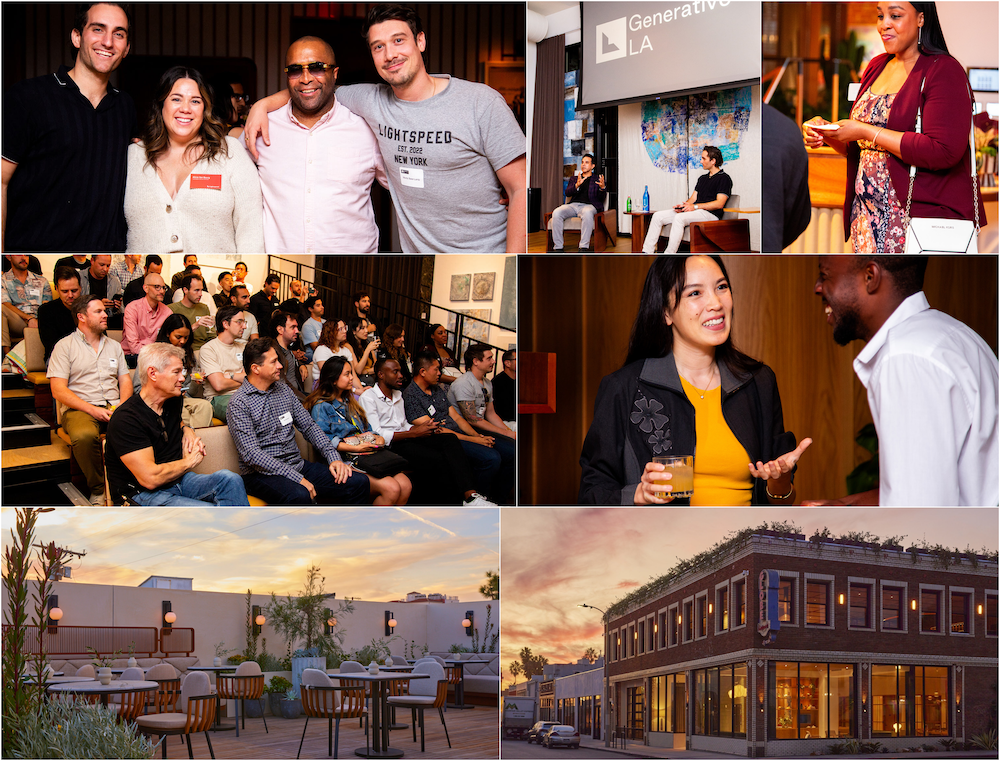
Five Areas of AI Opportunity, According to Snowflake’s Ahmad Khan
Lightspeed recently hosted the latest in its Generative AI series in Los Angeles, a fireside chat with Ahmad Khan, Head of AI/ML Strategy at Snowflake, the cloud-computing based data cloud company. Lightspeed has been investing in AI for over a decade, and launched the Generative series of meetups to bring together founders, builders, and investors working in the generative AI space to trade ideas and learn from each other.
Get notified here about future Generative events in the US and Europe, and listen to our new Generative Now podcast.
Khan spoke with Lightspeed partner Faraz Fatemi, who focuses on investments in consumer platforms, and co-hosted the gathering with Moritz Baier-Lentz, who heads the firm’s gaming initiatives.
During the discussion, Khan highlighted five areas in AI where he sees opportunities for entrepreneurs:
Capitalize on leveraging “unstructured” data
Khan estimated that more than 80 percent of most companies’ data is “unstructured,” including material such as word documents, images, and audio/video files. However, most companies are doing very little with this information, meaning that they’re leveraging less than 20 percent of their available data when making business decisions. Placing this unstructured data next to a large language model—effectively creating a chatbot—can help users interpret and analyze vast amounts of information that’s currently being underutilized. There’s a lot of potential in creating models tailored to the specific industries these companies are part of.
Privacy and security
Khan emphasized a growing concern among companies that their data will be used to train models that can be used by other companies, including competitors. As a result, companies often settle on inferior products that offer better security—creating a market for more secure products. For instance, even though Llama 2 is not the highest-performing large language model available, customers still choose it in lieu of models they have less control over, such as Chat GPT. Many companies’ advantages are in the uniqueness of their data, so they’re keen to avoid a situation where that data somehow ends up on the public Internet.
Gain an advantage by creating a superior user experience
How can startups compete against bigger competitors’ scale? Khan suggested focusing on creating pleasant user experiences—for example, by creating appealing User Interfaces. This is the approach Snowflake has taken. Since the company can’t really compete with cloud providers like Amazon Web Services—especially since much of their own services are built on top of it—they’ve focused on creating a superior user experience that justifies their higher price tag.
Focus on verticals
Khan suggested that another way for Davids to best Goliaths is by focusing less on general purpose applications and more on specific verticals such as manufacturing, finance, health care, or entertainment. “Learn what enterprises in your vertical are looking for,” he advised, and then service those needs. For example, even though Google will likely develop a medical large language model, it likely won’t go particularly in-depth—providing smaller companies an opportunity to build a model that does.
There’s a growing need for data attribution.
At one point in the evening, the conversation turned to the possibility of new models that track copyrighted material and allow the original creators of the material to be compensated, thus creating an incentive for those creators to develop more material for models. Khan cited several cases where companies can’t use open-source models for various legal reasons, including a movie studio that didn’t want to use open-source models for image generation. Instead, the studio used a model trained on data from Getty Images that was licensed and paid for. Going forward, there will be a growing market for similar models using attributable datasets.

Introducing Generative Europe — Starting in Paris
Introducing the Generative Europe event series: a response to the overwhelming demand from founders, builders, and operators in the machine learning and artificial intelligence community who expressed their need for a dedicated event to explore and engage in the latest advancements in the field. This initiative by Lightspeed aims to cultivate a space where industry professionals can come together to discover and exchange insights on cutting-edge developments.
Join us for Generative Paris on September 26: Learn more and apply to attend here.
Our ambition is to build Generative Europe into the community, the third place, where European builders and thinkers congregate to discuss the exciting advancements in machine learning and artificial intelligence.
At Lightspeed, we hold the firm belief that depth is our center of gravity and that when it comes to discussing AI, there is value in going beyond the surface (or the wrapper). We’ve spent over twenty years building deep ecosystems to support our founders on their entrepreneurial journey and are committed to bringing this expertise to the AI builders in Europe.
Whether you are a researcher, an applied AI engineer, a founder, technical product manager or enthusiast who enjoys digging deep into technology, we’re setting up Generative Europe for you. You can expect informative talks from experts, product demos and networking opportunities with peers who are on the same journey as you are.
Join us as we delve into the world of machine learning, artificial intelligence, and the limitless possibilities they present. Together, let’s shape the future of AI in Europe (and beyond) and create a community that continues to push the boundaries of innovation.
We’ve lined up the first three dates along the Paris-Berlin-London connection and are looking forward to meeting you in person.
- Paris – September 26: Learn more and apply to attend here.
- Berlin – November 7: More details to follow
- London – November 13: More details to follow
To be notified about future Generative Europe events, sign up here.
Generative Paris
Large Language Models have been the talk of the town for a while and progress in the field is moving at a fast clip with open source playing an ever increasing role in the democratization of this technology. As investors in Stability.ai and Mistral, we are witnessing first-hand the power of putting powerful technologies into the hands of builders. This is why we’ve invited for our inaugural event two of the brightest minds in the space to talk about all-things-LLMs: Guillaume Lample and Thomas Scialom will be joining us for an evening of technical discussions about the latest advancements.
Guillaume Lample is the co-founder and Chief Science Officer at Mistral.ai. Prior to building Mistral.ai, Guillaume played a key role at Meta in the release of Llama 1 and the advancement of research in the field of machine learning and deep reinforcement learning. Guillaume holds a PhD from the Université Pierre et Marie Curie, graduated from Carnegie Mellon University and Ecole Polytechnique.
Thomas Scialom is a Research Scientist at Meta AI leading the Large Language Models team. He contributed to Llama 2, CodeLlama, Galactica and Toolformer. Prior to joining Meta, Thomas did a Ph.D. from Sorbonne University. Along with his research activities, he is also an active investor in Generative AI companies.
The event will be moderated by Antoine Moyroud, partner at Lightspeed focusing on data and machine learning topics.
Whether you’re building a product that’s already found product market fit or hacking away on your first prototype, please join us at the inaugural Generative Europe event in Paris on September 26th.
If you have more questions about Generative Europe, or just want to get in touch, email Antoine Moyroud or find him on Twitter.
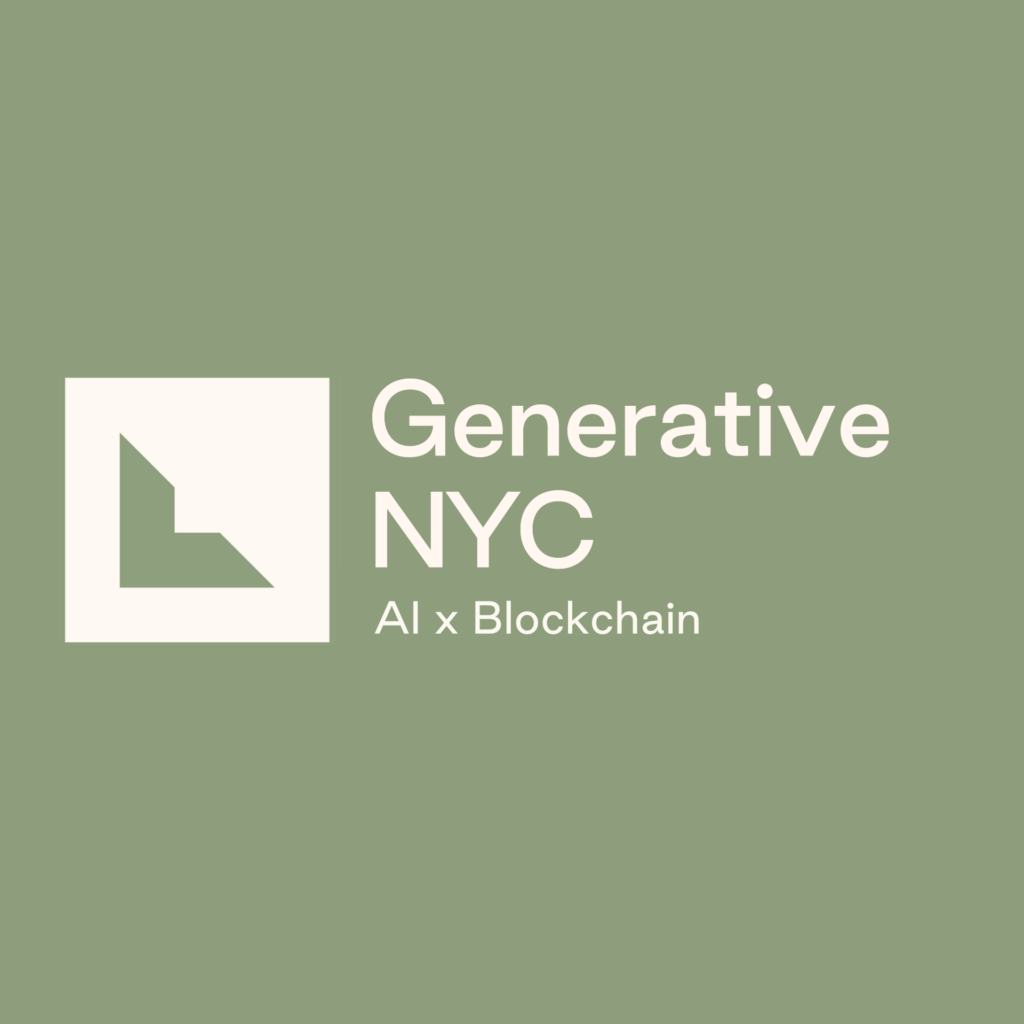
The Promise and Potential of AI x Blockchain
We are excited to announce Generative NY: AI x Blockchain on September 21 in New York, a special event exploring the intersection of artificial intelligence and blockchain technology. In recent years, both AI and blockchain have transformed entire industries. Now, as these two powerful innovations converge, the possibilities are endless. That’s why we knew it was time to bring together the builders and thinkers at this thrilling inflection point.
If you’re ready to glimpse the future of AI x blockchain, request an invite here.
We’re honored to be joined by two exceptional speakers:
Illia Polosukhin, co-founder of NEAR Protocol. Illia has more than 10 years of industry experience, including 3 years at Google where he was a major TensorFlow contributor and manager of the team building question-answering capabilities for the core Google search, as well as an author of several notable research papers. Illia will share his unique perspective on the potential of AI to revolutionize blockchain.
Alex Atallah co-founded OpenSea, the first NFT marketplace, serving as CTO during its meteoric rise. He helped grow OpenSea to over $4B in monthly volume before leaving to pursue new ventures. Alex brings invaluable perspective on blockchain applications and possibilities.
Illia and Alex will speak about how AI can enhance security, efficiency, and usability for blockchain platforms, and address crucial topics including how generative AI models could open new frontiers for DeFi, NFTs, identity, reputation systems, and overall utility of the blockchain. Our wide-ranging conversation will uncover real-world use cases, technical hurdles, and the startup opportunities this fusion enables.
At the same time, blockchains offer AI solutions trust, transparency, and immutability. Blockchain data provenance builds confidence in AI training sets. Decentralized models aligned with user incentives may mitigate harms. And running models on-chain with crypto incentives creates autonomous AI agents safely aligned with human values.
Our goal is for attendees to leave inspired, with a clearer vision of the immense potential of AI x blockchain. This event is for builders and innovators eager to be part of creating the next paradigm shift in tech. If you’re a founder, developer, designer, or product leader exploring the intersection of AI and blockchain, join us for this compelling conversation.
Beyond the main discussion, Generative NY: AI x Blockchain will offer invaluable networking with like-minded peers. Plus we’ll provide drinks, pizza, and time to connect over your experience of the AI x blockchain revolution.Ready to get a glimpse of the future? Request your invite and be part of the frontier. If you’re working at the cutting edge of AI, blockchain, or the fusion of these technologies, we hope to see you there!
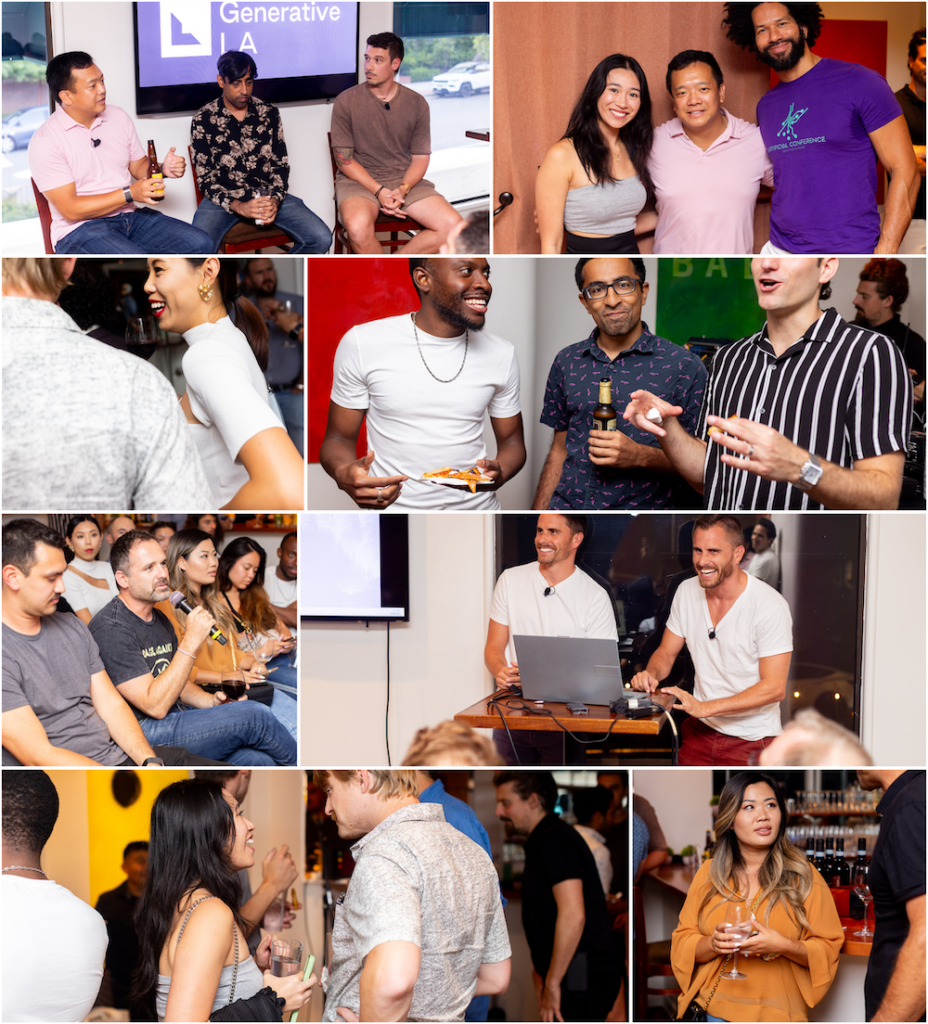
Four Ways Generative AI Will Transform Gaming
Lightspeed recently hosted the latest in its Generative AI series, “AI in Gaming,” in Los Angeles. Lightspeed has been investing in AI for over a decade, and launched the meetups to bring together founders, builders, and investors working in the generative AI space to trade ideas and learn from each other.
The panel was organized and moderated by Lightspeed partners Moritz Baier-Lentz, who heads the firm’s gaming practice, and Faraz Fatemi, who focuses on investments in consumer platforms. The two were joined by panelists Ken Wee, Chief Strategy Officer of Activision Blizzard, and Ankur Bulsara, Co-Founder and Chief Technology Officer of Scopely. They brought predictions and deep expertise to the topic.
Four insights from the discussion:
1. Generative AI will revolutionize game development
Game development has historically demanded vast resources in terms of time, talent, and financing. AI promises to reduce those barriers in the same way that music production software has allowed resource-strapped musicians to produce high-quality material in their homes instead of expensive studios. AI is “the most accessible computing platform we’ve ever had in the world. And that means everyone in this room can be a coder, artist, screenwriter, game designer, or anything else they desire,” according to Bulsara.
With lower production costs and technical barriers, more people will try their hand at developing games. Even though Activision Blizzard employs north of 11,000 people, according to Wee, “We [still] don’t have the people or the resources to give consumers enough content, so AI is an incredible opportunity for us to deliver even more content to players. And beyond productivity gains and development speed, AI will also unlock new game genres and design possibilities, so consumers can expect a windfall of new choices.”
Of course, with so much new output, consumers could find themselves overwhelmed with choices and upstart companies might struggle to break through all the noise.
2. Incumbents will benefit, but gaming startups have a true opportunity with emergent AI
When platforms shift, opportunities are typically created for nimble startups that don’t have to deal with issues that established companies often face, such as established development processes and approvals, and tech debt. This is the newer companies’ path to becoming the next behemoths – and why Lightspeed is investing in startups like Inworld AI. However, AI does offer incumbents some significant advantages. According to Wee, AI promises to help established franchises such as Call of Duty increase its content offerings to its players.
With AI potentially flooding the market with new offerings, incumbents will be able to capitalize on their name recognition. Similar to trends in the music and book publishing industries, gamer engagement may continue to concentrate in the largest franchises.
3. Concerns around existing IP
In the current discourse about AI’s potential, many people are concerned about what data sets are used for training. Artists and writers are especially worried that their copyrighted work could be used by AI to build games—or write scripts or create images—that they don’t receive royalties for. However, the panelists suggested that this concern is on its way to being properly addressed. Bulsara used the example of AI initiatives at Adobe, which he said is “very serious” about tackling the problem and has strict rules about proper attribution. He also said that Scopely closely tracks attribution and strives to ensure that copyrighted works aren’t used in their design process. Wee said that litigation IP risk is something to take very seriously, especially for larger incumbents.
4. AI can quickly fix “pain points” that have long nagged companies
Every company has problems that go unaddressed for too long, either because of cost or lack of resources. AI promises quick and affordable ways to clear out a company’s backlog of niche “pain points.” According to Wee, Activision Blizzard just teamed with an AI startup, Modulate, working to limit the sort of toxic and offensive language that has long affected many gaming platforms. The collaboration addresses “a massive problem for us,” he said. “It solved something that we were not doing because we didn’t have enough resources.”
Bulsara, for his part, cited a recent collaboration with an AI voice generator that helps Scopely add voices to their advertisements. This function used to require a lot of time, meaning that the company often avoided doing it. The platform has helped increase ad conversions and now Scopely uses the option often. Hundreds of new AI startups promise to address similar problems for companies; in the gaming space specifically, they specialize in problems related to the creation of art, animation, sound design, and a variety of other production processes.
It was also noted that perhaps one of these smaller, niche AI startups will become the next big thing—or at least grow to a size that makes them an appealing investment opportunity.
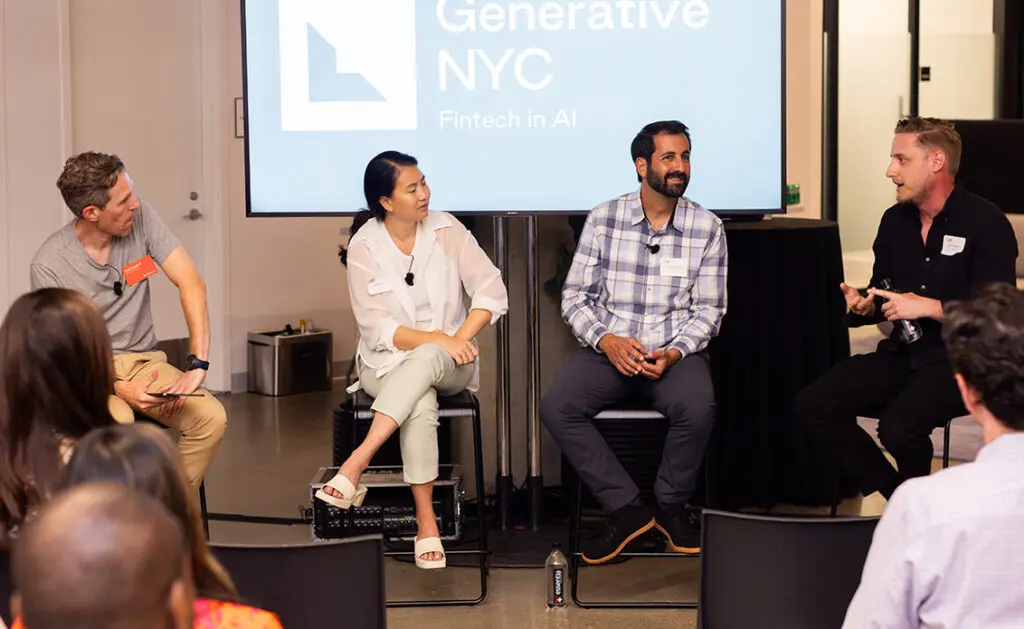
Fintech in AI: Five Lessons For Founders
Lightspeed recently hosted the latest in its Generative AI series, “Fintech in AI” at our New York City office. Lightspeed has been investing in AI for over a decade, and launched the meetups to bring together Founders, builders, and investors working in the generative AI space to trade ideas and learn from each other. The panel was moderated by Justin Overdorff, a partner who heads the firm’s fintech practice. On the panel were Grace Liu, Alloy’s Director of Product; Sasha Orloff, founder and CEO of Puzzle.io; and Leif Abraham, co-founder and co-CEO of Public.com. They brought hopes, worries and deep expertise to the topic.
Five clear lessons from the discussion (for founders and builders alike) emerged from the evening:
1. Generative AI will increase your productivity, saving you time, money, and tedium
Whether debugging code, assessing risk, or bookkeeping, tasks that would have taken weeks last year – or perhaps been impossible – can now be accomplished in seconds. For early-stage companies, hiring accountants, for example, can be prohibitively expensive. But Orloff pointed out that while it takes six years to become a CPA, with generative AI, “you don’t need to know accounting to do accounting.” Many entrepreneurs will be freed from boring, repetitive labor to focus on the dimensions of their business that they’re most passionate about. “AI can handle the busywork,” Abraham said, resulting in a “massive productivity boost, and people will be more fulfilled.”
2. You still need to hire professionals when it matters
Just because you can do accounting without an accountant or write a coherent blog post with a math degree, doesn’t mean you should. When the stakes are high, expertise is still needed, Orloff explained that at his company, Puzzle, they tag all work done by AI. “Then if you don’t care that much,” he said, “because accounting isn’t that big a deal at that moment, at this stage of your company, you can just take it and run with it for analysis and insights.” But sometimes the stakes are too high to depend on AI. “If you’re submitting it to the IRS or sharing with investors,” he elaborated, “you’re going to want to review it with a professional [accountant], just like if you’re going to publish something, you want to have a good copywriter review this output. You don’t want to just copy and paste it.”
3. The fraud risks are terrifying
Liu stressed that AI-enabled financial fraud is real and “happening right now.” For example, AI voice cloning, she emphasized, is “really real and really scary.” It may be fun when it allows the long-dead Frank Sinatra to perform a Dua Lipa cover, she observed, but how about when it permits fraudsters to accurately clone your voice, convincing your family and friends to drain their life savings to pay ransom to fake kidnappers in order to save you? Fake communications from banks, too, are becoming much more convincing. “A lot of consumers aren’t going to trust financial institutions anymore,” Liu warned. “It’s our job to innovate and protect our customers.”
4. Whatever the government does can help you
During a Q&A period following the panel discussion, when an attendee brought up policy, Orloff said that both regulation, and lack thereof, create opportunities, “so I think, as a Founder, they both create opportunities.” An unregulated market, he explained, gives Founders the freedom to “figure out and try and create the business you want.” But regulation can be good for Founders, too: “anytime there’s a big market shift, it means there’s an opportunity. Somebody’s going to lose and somebody’s going to win.” Those who can take advantage of the changing regulatory environment and “adapt faster,” he said, will be winners.
5. Move fast
Orloff sees our current moment as an inflection point for innovation in AI. “There’s a huge opportunity right now in literally every possible industry,” he explained, exhorting the crowd of Founders to make the most of it. “It’s hard when you have an existing revenue stream, and a three-year board-approved company plan, to change the course of the ship, right? It’s like moving the Titanic. So there’s probably a good three to five years that you guys have an opportunity to take advantage. And if you can’t build a powerful wedge in three to five years, then chances are you aren’t going to crush an incumbent, the incumbent is going to crush you.”
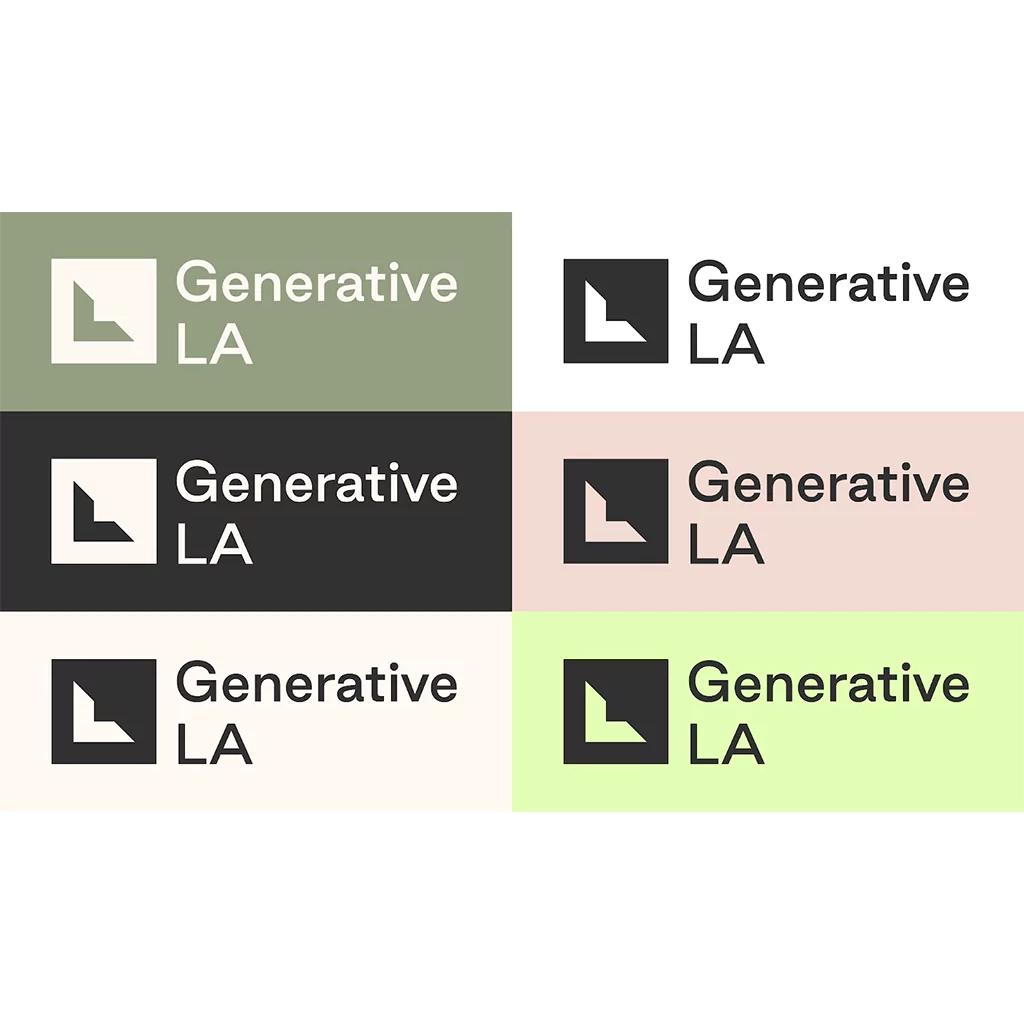
Generative LA—Lightspeed x Scopely x Activision
Session #2 of Lightspeed’s LA AI builder meetup will feature Ankur Bulsara of Scopely and Ken Wee of Activision.
Generative AI continues to make waves across the startup and broader technology landscape, and Los Angeles has emerged as a hub for AI-led innovation across sectors including entertainment, fintech, gaming, healthcare, and the creator economy.
In June, we were honored to host builders, founders, engineers, and leaders from the local LA AI community for an intimate fireside with Snap’s Head of Strategy Michael Greenberg, followed by demos from local SoCal startups PersonalAI, Mayk.it, and Moviebot.
Today we’re excited to announce the second edition of Generative LA on Wednesday August 30th at 6pm in Santa Monica. We’re honored to be joined by a pair of exceptional local leaders innovating at the intersection of Gaming & Artificial Intelligence: Ken Wee, Chief Strategy Officer of Activision Blizzard, and Ankur Bulsara, Chief Technology Officer & Co-Founder of Scopely.
Santa Monica-based Activision Blizzard is one of the most successful interactive entertainment companies globally, reaching hundreds of millions of players monthly across its franchises including Call of Duty, World of Warcraft, Diablo, Overwatch, and Candy Crush. Ken is an avid gamer and is the Chief Strategy Officer of ABK where he leads strategy and new initiatives, M&A, and external development. He was previously a Partner at McKinsey & Company where he led their Global Interactive Entertainment Practice and worked with clients in their Technology, Media, and Telecom group.
Culver City-based Scopely is the leading mobile-first interactive entertainment company (named Top App Publisher of 2022 and Best Mobile Games Publisher of 2023) that was recently acquired for nearly $5B, marking LA’s largest VC-backed exit of the past 5 years. Scopely has built an ecosystem of games on top of their proprietary technology platform Playgami, and Ankur is universally regarded as a pioneer of emerging and evolving technology, including the AI x Gaming space.
We look forward to learning from Ankur & Ken’s perspectives on how AI is impacting not only the gaming world but media creation at large, how startups can think about moats & business models in the rapidly-evolving AI landscape, and how some of the world’s leading entertainment companies are working rapidly to integrate AI as a core part of their development stack & end user experience.
In addition to the fireside chat with Ankur & Ken, we will feature another set of exciting demos from local startups building in the AI space, followed by casual networking over drinks & light bites. We’re just scratching the surface on the potential for AI in both consumer and B2B use cases, with so many great builders dedicated their time to leveraging this platform shift to build the next set of generation-defining companies. Our hope is that these Generative sessions serve not only as a learning experience for all those in attendance, but more broadly serve as a connector in bringing together the robust Los Angeles AI community at large.
We’d invite all local builders to apply here — we hope to see you there!
For more information, join our notification list for future events here.
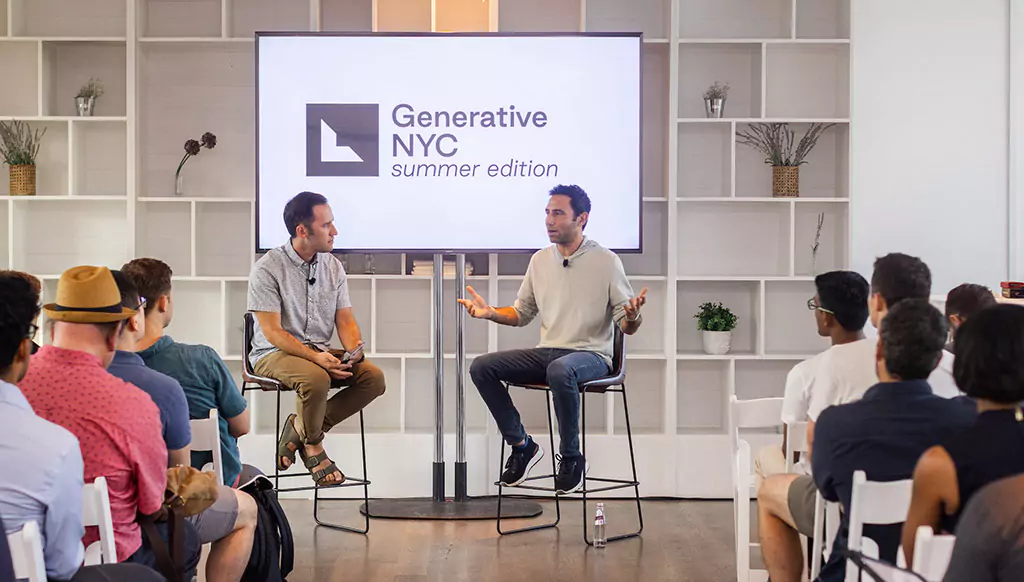
Scott Belsky on Creativity in Generative AI
Our Generative series of meetups brings together the AI community of Founders, builders, and investors to talk about the shape of the future. Recently, we held the summer edition of Generative NYC where Scott Belsky, Adobe’s Chief Strategy Officer and EVP of Design and Emerging Products sat down with Lightspeed Partner Michael Mignano to discuss the influence of generative AI on creativity, work, startups, and healthcare.
In the spirit of the subject matter, we ran the 6,400 word transcript through ChatGPT with instructions to remove filler words, correct grammar, and reorder sentences and thoughts for flow and coherence, while preserving anecdotes and speaking style. We got back 2,400 efficient words capturing nearly all of the nuance of the discussion. With some minor edits and re-additions from the original transcript, we’re publishing it here.
The next edition of Generative NYC will be back at our Union Square offices on August 15, focused on Fintech in AI. To apply to attend, sign up here.
Michael Mignano: About a decade or so ago in New York City, during the mobile computing revolution, we used to have these exciting meetups. People from the community gathered to connect, hear each other’s stories, hire talent, secure funding, and showcase their products. It was an incredible time of innovation and collaboration.
When AI exploded on the scene about a year ago, it felt like we were experiencing one of those transformative moments again. It was clear that we needed an event to bring people together just like the old days. And that’s precisely what Generative NYC is all about. Tonight, we have a very special guest who holds a prominent position not only in the tech industry but also in the AI community. His name is Scott Belsky. He serves as the Chief Strategy Officer and EVP of Design and Emerging Products at Adobe, a company that has been a pioneer in nurturing creativity and empowering creators and media generation for decades.
Scott is not only an influential figure at Adobe; he is also a prolific angel investor. Over the years, he has invested in game-changing companies like Uber, Pinterest, and Carta. Personally, I have had the privilege of knowing and working with Scott for a long time. Back when I was at Aviary, a company later acquired by Adobe, I admired Scott’s insights as a product visionary. When I joined Adobe and found out he would be my boss, I was thrilled to learn from him.
Although I left Adobe after nine months to start my own company, Scott’s support remained unwavering. When I asked him to invest in my venture, he didn’t hesitate to commit. I will forever be grateful for his trust and guidance, especially during high-pressure moments, such as when we were selling our company, Anchor, to Spotify.
Scott’s experience goes beyond his role at Adobe and his investment ventures. He co-founded Behance, which was also acquired by Adobe, so he knows firsthand what it’s like to be a Founder in the startup arena. Now, as we see numerous founders in this room building products that leverage AI, Scott undoubtedly has a front-row seat to everything happening in the world of generative AI.
Scott Belsky: Thanks for having me.
Michael Mignano: Let’s dive into generative AI. It feels like you’ve been at the forefront of this field. For me, the “aha” moment happened around nine or ten months ago when DALL-E 2 was launched. But what about you? When did you have that “aha” moment, both personally and for Adobe?
Scott Belsky: Well, one of the ideas that brought me back to Adobe, about five and a half years ago, as the Chief Product Officer, was the idea of “creativity for all.” I was passionate about envisioning what humans would be doing in a future where much of the work is achieved through computing. Creativity, in my opinion, needed to become the next form of productivity, enabling people to stand out at work and in school.
Returning to Adobe, I realized that the creative world faced significant friction. Many people lacked the necessary skills, and creative confidence seemed to peak during kindergarten, only to decline as we faced critics and challenges. I found it unfortunate that creativity tends to decrease over time rather than flourish. Additionally, I was intrigued by the future of digital experiences, exploring what’s next, such as 3D and immersive technologies.
The challenge was clear: creativity was a high-walled box. The entry barrier was daunting due to the skills required and the cost of tools. The ceiling represented the limits of what one could achieve within the constraints of time and ability. I aimed to make that box bigger, thus expanding Adobe’s total addressable market (TAM) while fostering creativity for everyone. We tried various approaches, from improving first-mile experiences to introducing new products and web tools, but none of them truly transformed the landscape.
Then, we stumbled upon DALL-E and other generative AI capabilities brewing in our lab. Suddenly, it all clicked. These innovations effectively lowered the floor of the creativity box. People could now prompt the AI with natural language and watch their ideas come to life. Animations, 3D designs, and immersive experiences that used to be the realm of skilled artists became accessible to all through prompts and algorithms. The ceiling soared as people’s creative potential expanded with AI assistance. That was the “aha” moment when we knew we had to be fully invested in generative AI.
Michael Mignano: So, did this realization lead to the birth of Firefly, or was that a separate journey?
Scott Belsky: The concept of Firefly came to my attention through a white paper in 2019, presented by someone on my team. While I found it intriguing, it seemed distant and not yet fully developed. However, as the industry progressed, with significant milestones and open-source contributions from companies like NVIDIA and OpenAI, the potential of generative AI and Firefly as a product became more evident. The tide was rising, elevating the potential for various companies, including Adobe.
Michael Mignano: And when did Firefly evolve from an idea to a full-fledged product?
Scott Belsky: Firefly’s journey began back in 2019, long before most people were actively considering these possibilities. It took time and development, but eventually, it evolved into a comprehensive product with a series of models and powerful capabilities.
Every company must make serious decisions about what to make internally and what to outsource. We faced this dilemma at Adobe when considering generative AI. Initially, I wasn’t sure if we could be market leaders in this area by doing it all internally. It seemed like we might need a partner. However, as we delved deeper, it became clear that certain aspects, like LLMs, were best outsourced due to their complexity and cost. On the other hand, for imaging, video, and 3D, we possessed the necessary expertise and patents to excel. Moreover, customers were concerned about how some generative AI models were trained, especially when they used copyrighted material without proper permission. This realization fueled our determination to approach generative AI differently and set the stage for Firefly.
Michael Mignano: For those unfamiliar, can you provide an overview of what Firefly is and what features it offers? Also, where do you see it heading in the future?
Scott Belsky: Firefly is a family of generative AI models that began with text-to-image and text-to-text style capabilities. This allowed users to create images with unique styles, for example, using palm trees or sake bottles to spell “hello.” As we progressed, we realized that customers wanted even more flexibility. They desired the ability to prompt on a layer-by-layer basis and use powerful tools like Photoshop for more in-depth creations. The launch of Generative Fill was especially remarkable, and integrating it into Photoshop by default proved to be a successful approach, facilitating product lead growth.
Michael Mignano: It’s incredible to see the impact of Firefly and what people can achieve with it. However, for startups, especially when established players like Adobe possess significant data and distribution advantages, how should they approach AI?
Scott Belsky: Startups need to approach AI with empathy and a data advantage. It’s crucial to understand the actual problems and frictions users face rather than being solely passionate about a solution. Empathy-driven solutions resonate better with customers. Additionally, startups should focus on building unique data sets that incumbents lack – building their moat. Competing based on interface innovation can be risky, but having a disruptive interface approach that challenges the status quo can be advantageous.
Michael Mignano: Big companies like Apple are also venturing into AI, potentially causing disruption. You’ve talked about the personalization wave and its intersection with AI. Can you elaborate on that?
Scott Belsky: Personalization will revolutionize digital experiences. In the future, generalized e-commerce and media experiences will seem outdated. Every website and media platform should be hyper-personalized for each user. The model needs to shift from a small group of people programming content for the masses to having the masses generate content personalized for each individual. The potential for hyper-personalization is enormous, and startups should explore this uncharted territory.
Michael Mignano: Let’s discuss the media side of things. Everything you said makes total sense, especially regarding commerce and experiences. When it comes to media, particularly content discovery and personalization, it seems like we’re heading towards content that’s not just programmed but created in real-time for each individual. While this offers exciting possibilities, there are concerns about how today’s incentives, such as maximizing ad revenue, could lead to a negative outcome. How do you see AI personalization avoiding a dystopian future?
Scott Belsky: I believe we secretly long for the way things were but with more scale and efficiency. We miss the personalized experiences we had in small towns where people knew us, and that was wonderful. AI could enable a similar personalized experience, but it has to be done in a way that respects privacy and comfort. Trust and authenticity will become crucial. Brands will matter more as people seek reliable sources and verification before trusting information. The Content Authenticity Initiative, focusing on content verification, is an open-source framework my team has been working on for years, especially relevant in the generative AI era.
Michael Mignano: It seems like we’re witnessing a transition in media. Established institutions may gain more trust again, given the rise of deep fakes and misinformation. People will look for verification before trusting content, and this shift could benefit long-standing brands and institutions.
Scott Belsky: Absolutely, trust and authenticity will become paramount. It’s a time where we can no longer believe our eyes without verification. Moving forward, we’ll have to verify content first and then trust it.
Michael Mignano: Let’s talk about AI’s impact on the creative process. Does generative AI enable people to be creators or creative directors? What’s the difference between the two?
Scott Belsky: Great creatives desire creative control, so we’ll move beyond the prompt era where generative AI offers limited control. In the creative professional world, people will still want to be creative directors of their work. Social media marketers will need to act in real-time, requiring creative director skills to execute using brand assets and AI capabilities. At the ceiling level, granular tools will still be valuable.
Michael Mignano: We’ve recently seen something akin to an “Napster moment” in AI: a deep fake South Park episode was released, almost identical to the show’s original style. What are the implications of such developments, and what’s the likely regulatory response?
Scott Belsky: We’re entering the era of unauthorized sequels and IP nightmares, where anyone can create content using actors’ likenesses and voices. The situation poses legal and ethical challenges. We may see a Napster-like response with more stringent regulation due to the potential economic detriment to original IP owners. I’m not a lawyer, but one of the things I’ve learned about IP law is it’s very focused on the economic detriment of whoever’s IP you’re violating. And so if I’m inspired by your style, and I put it in my mood board, and I make something sort of like it, that’s typically fine. But if I literally use your voice and likeness, and you’re an actor, or a voice actor, and then I put something out there that people use at the expense of buying your material or paying you to do your job, that’s traditionally not fine.
Michael Mignano: I can see how the latter example gets shut down. The former sounds complicated, right? So if you’re inspired by me, do I get to participate in the commercialization of that in any way? And how does that happen?
Scott Belsky: Yeah, part of me is inspired by your former company, Spotify. They built an attribution and compensation model that, at first, no artist was happy with, but it became better than the alternative. I wonder, why don’t we let Behance members, with amazing portfolios and unique styles, train a model and make it licensable by others through generative AI tools? They could monetize even when they’re sleeping.
Michael Mignano: It’s funny because decades ago, there was a royalties infrastructure built for music that allowed songwriters to get paid no matter how big or small their contribution. It’s a completely antiquated system, but it might serve as a model for what could come next with AI.
Scott Belsky: I think that’s interesting. It reminds me of the other product principle, especially in the enterprise: People are lazy, vain, and selfish. So if we make it easier to use great styles in a licensed fashion rather than relying on rogue general AI tools with potential liability issues, people may prefer it and pay for it, just like with music. This could create a marketplace opportunity.
Michael Mignano: Let’s talk about the enterprise, and the impact of large language models (LLMs) in the workplace. How do you think they will transform the way we work, from organizational design to streamlining meetings?
Scott Belsky: It’s going to change everything in some ways. LLMs are being integrated into various products, and they can answer questions, perform tasks, and even suggest improvements based on data analytics. There’s a huge opportunity to use LLMs to assist with management tasks, which is something most of us struggle with.
If you look at what an assistant within a product can do, I sort of see it as a pyramid. It starts with helping you answer your questions. And then a little bit higher up in the pyramid, it can actually do things for you. So in Photoshop, you can say, “remove the background,” in natural language. And then the top of the pyramid is that it can actually suggest things to you, like, “hey, designer, that color does not actually perform well, in that market,” or, “based on your analytics data, you should actually move that three inches to the left,” and you’re like, “What? Wow, OK.”
One of the things you mentioned is, there are some parts of every day that are like, really antiquated that LLMs can do that startups should make. One idea I’m passionate about, and hopefully one of you [in the audience] is building this, is management. I think most of us are bad managers. We don’t know what to talk about in our one-on-ones. If you could have cues for each of your direct reports – what they’re struggling with, whether they’re hiring people using Glassdoor or not, what their sentiment scores are, and so on. If you can have all this stuff analyzed by LLM and presented to you during your one-on-one, would we all become more capable managers? I think so. Things like that still need to be invented.
Michael Mignano: You’ve worked with several LLM companies. Do you think we’ll experience a long tail of models or a concentration of power among the big players?
Scott Belsky: Longtail human tuning is happening under the hood to make LLMs more capable and human-like. This is not just about technology, but the hard work behind it. While big players are integrating LLMs into their products, there’s also room for highly specialized LLMs for individual use cases. This specialization could create a diverse ecosystem.
Michael Mignano: I remember your advice about doing things that don’t scale. For instance, when we were building our company, Anchor, we hired dozens of college students to manually distribute podcasts to various platforms like Spotify and Apple Podcasts. It was highly unscalable but very impactful, and changed the trajectory of the company.
Scott Belsky: Exactly! Startups should focus on non-scalable tasks that big companies won’t bother with initially. It can give them a competitive edge.
Michael Mignano: As we wrap up, aside from Adobe’s work, what generative AI products would you like to see in the world?
Scott Belsky: Well we talked about the management idea. I think one debate in my head about where the future of that space lies is whether we should have one general AI assistant or many highly specialized ones. The latter seems more plausible to me. Specialized AI assistants, like those focused on health, could leverage personal data to provide unique insights and patterns about daily activities and health trends.
For example, one of the reasons why I started wearing my Whoop again is because while this data may only be partially helpful to me today, in five years, when I can sync all my data with a health-tuned LLM that knows other things about me as well, I could start getting insights about my daily activities and health that I never even imagined. So I think that we should all start collecting some of the data now, so that we can kind of leverage it when technology catches up.
Michael Mignano: Scott Belsky, thank you so much for being here with us!
To apply to attend Generative NYC: Fintech in AI, sign up here. To be notified about future Generative events in NYC, SF, LA, and London, fill out this form.

Announcing Generative NYC: Fintech in AI
Our new event in New York, and our thoughts on the opportunity for AI to transform Financial Services
At Lightspeed, we are default optimists when it comes to technology. We are excited about the innovation and endless possibilities that AI brings to fintech and financial services, and we are confident that generative AI will revolutionize the industry landscape.
By overcoming data limitations, improving risk management, enhancing fraud detection, enabling personalization, and refining investment strategies, financial institutions can leverage generative models to create additional data points that expand the size and diversity of their datasets. They will be empowered to train more accurate and robust machine learning models, ultimately improving the quality of predictions and decision-making processes.
This gathering will bring together visionary fintech founders and industry leaders who are pioneering the use of AI in financial services. Generative NYC: Fintech in AI will foster knowledge sharing, collaboration, and networking among like-minded individuals passionate about leveraging AI to drive financial sector innovation.
We invite all founders and product builders who are exploring or working on AI-based solutions in fintech to join us on August 15th. Together, let’s embrace the opportunities presented by AI, paving the way for a future where fintech and financial services unlock the possibilities of this exciting new technology.
If you’d like to register to attend, sign up here. Also, if you’re part of a local team that’s interested in demoing your fintech + AI product, please fill out this form.

Building Tomorrow’s Boardroom, Today — Part IV
As the sun set over the Hudson River on June 15, an exuberant crowd of top talent was expanding their professional networks on a rooftop garden in Tribeca next door to the Jackie Robinson Museum. The gathering, “Driving Change for Black Leaders in the Boardroom,” was co-hosted by Lightspeed and Black Women on Boards (BWOB).
Lightspeed has been organizing an ongoing series of conversations, “Building Tomorrow’s Boardroom Today,” to address the empowerment of under-represented groups in the boardroom. This event was the fourth in that series.
The timing was ideal, taking place the week that director Deborah Riley Draper’s film OnBoard, chronicling the rise of Black women on boards, launched at the Tribeca Festival.
Merline Saintil, an Executive Producer of the film, was present and gave some introductory remarks.
Saintil, who has taken six companies public, co-founded BWOB with Robin Washington in 2020. In the wake of nationwide protests over George Floyd’s killing, the two women found they were hearing increasingly from companies seeking black women for their boards — yet they knew many talented and experienced businesswomen weren’t being asked. (They tell the origin story in this one-minute video on the NYSE trading floor.)
In the last two years, Saintil told event attendees, BWOB has helped place 33 black women on boards. “So, the impact is real,” she emphasized.
The panelists represented a wide range of industries and expertise:
- Celia Edwards Karam, President of Retail Bank and an Executive Committee member of Capital One
- Anita Lynch, a board member at Nasdaq US Exchanges and other companies
- Baron Davis, founder, investor, board member, and NBA all-star
- Tammy K. Jones, CEO and founder of Basis, a commercial real estate investment platform and lender, and chair of the board of Veris Residential (formerly Mack-Cali Realty).
The discussion was moderated by Sydney Sykes, a Lightspeed partner and a co-founder of BLCK VC, a network of Black venture capitalists, and by Nicole North, Lightspeed’s partner for executive talent.
The discussion was generative, with some concrete takeaways.
Black women on boards can help companies make better decisions, and shouldn’t hesitate to do so. “You’re there to represent your perspective,” said one director at a company that recently considered layoffs. She asked about the impact on the company’s diversity, since many of the women and people of color were newer hires. Upon studying it, the research had revealed, she said, that “in some departments the layoffs would have eliminated all our diverse new hires,” so they reconsidered.
If you’re “the first or only” black woman on a board? Embrace your role as a trailblazer and find “the self-awareness to know what works for you in that setting,” one board member advised, saying that when she’s the only black woman, “I have to remind myself to speak early and speak first. If I don’t get my voice out there, I stay quiet.” She emphasized the importance of empathy and collegiality: “Yes, I may be the ‘only,’ but there’s probably someone else in this room who doesn’t feel like they belong, who’s not getting their airtime. Maybe they tried to say something, and someone talked over them. How can I create space for them? And in working to create space for them, I create space for me, too.”
Black women on boards should create board opportunities for other Black women. Lightspeed’s Nicole North quoted advice from Merline Saintil: “It’s okay to be the first. You just don’t want to be the last.”
Another panelist said she got onto her first board because her mentor, a white woman, had been asked first. “She told them, ‘You don’t want me, you want her.’” That same panelist had helped another black woman onto one of her current boards — in fact, that new member was elected this week. “I’m getting emotional now,” she said, “just remembering that it was done for me.”
Networking is essential. And always be networking outside of your own network. One board member said Thursday evening’s event was “a great example,” admitting, “I’m not good at it. I’m a diehard introvert, so these sessions are hard for me, but I know they’re important.”
“It’s all about relationships,” a fellow panelist agreed. “The reason we are not on boards [in greater numbers] is that we don’t have those relationships.” She continued, “It’s about finding pipelines. They’re out there, and there are folks looking for you.”
After the panel, many returned to the terrace to continue the conversation — and to build those networks and pipelines. Below are a few photos that captured some of our favorite moments from the event.
Lightspeed’s next event in the series, planned for the Fall, will focus on the Latinx community. If you’re interested in attending, please reach out to events@lsvp.com.
You can learn more about Black Women on Boards here, follow them on LinkedIn here, and find out about future screenings of the OnBoard documentary here.
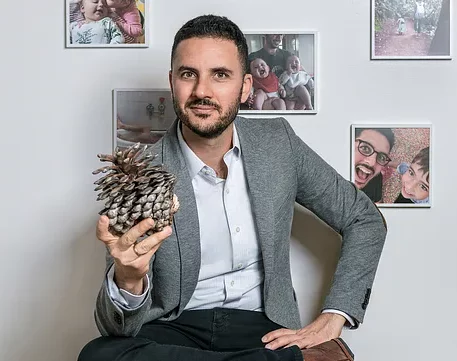
Generative NYC is back with Edo Liberty of Pinecone
The next edition of Lightspeed’s new AI-first meetup
Under Edo’s leadership, Pinecone has emerged as one of the most exciting companies in all of AI. Vector databases have quickly become a critical building block for anybody creating LLM-powered applications. Companies like Gong, Notion, Hubspot, Shopify, and Zapier are leveraging Pinecone to augment the performance of pre-trained large language models with their own, proprietary data. The company’s mission is to become the “long-term memory” for large language models.
Before founding Pinecone, Edo was director of research at AWS and head of Amazon AI Labs, as well as former head of Yahoo’s Research Lab in New York.
In addition to the fireside chat with Edo, this next Generative NYC will feature demos from three local AI startups to be announced, along with drinks, pizza, and stimulating conversation.
By bringing together generative AI founders, designers, engineers, and product leaders in real life and real time, we hope to accelerate understanding and unlock the possibilities of this exciting new technology.
We invite everyone building products that incorporate AI and have an interest in sharing their experiences with colleagues, to sign up. Note that space is extremely limited and reserved for people actively building in AI; if we’re unable to accommodate you, we hope to see you at a future event.
For more information, join our notification list for future events here.

Introducing Generative NYC
Today, Lightspeed is announcing a new meetup dedicated to bringing together everyone building the future of AI products in New York City
Right now, every startup founder, engineer, designer, and product manager is thinking about how they can leverage AI to take their product to new heights.
And while there are plenty of places online for people to gather, learn, debate and share new ideas, we believe there’s a need for an offline place — somewhere IRL — where AI builders can gather to bond as a local community, learn from leading experts, and showcase the products they are building. So today Lightspeed is launching Generative NYC.
During the mobile computing revolution, NYC became a thriving tech ecosystem. Not only did it become home to some of the most exciting companies of the era — such as Foursquare, Behance, and Tumblr — it also spawned a new — now classic — type of tech meetup.
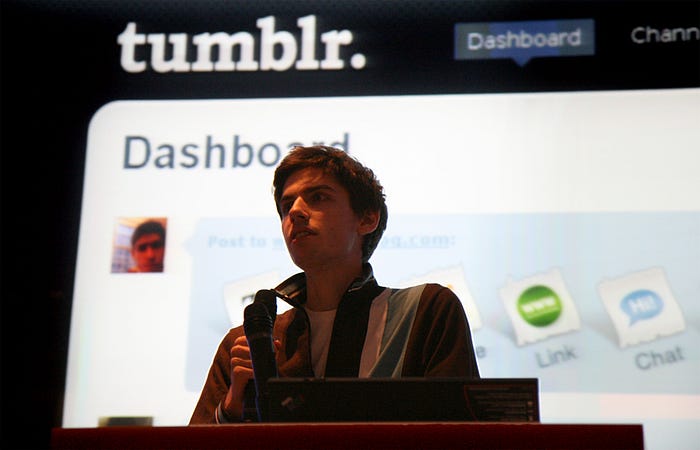
Events like the the NY Tech Meetup, Product Secrets, or Betaworks’ Thursday night demos became staples within the local community, giving builders a place to trade ideas with their peers and learn from people making their favorite products.
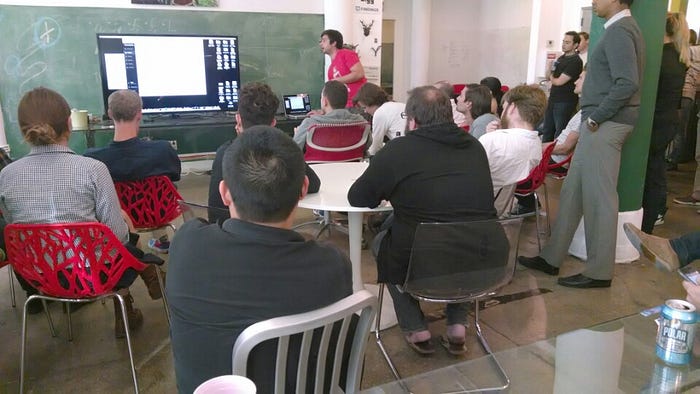
Demos of unpolished prototypes, on-the-spot hiring, and requests for beta testers were all hallmarks of these events (as was pizza and beer).
These meetups played a crucial role in fostering the growth and development of the NYC community during a time of unprecedented change within tech. And now, because of AI, tech in NYC is once again experiencing a surge of excitement, momentum, and change, similar to the one felt more than a decade ago. Which means it’s once again time to bring this electric surge of talent and excitement into a room, together.
Generative NYC is modeled after these classic NYC meetups. The event will be held monthly, and will be open to anyone building products (e.g. engineers, designers, PMs, and founders) that leverage AI. At each event, a featured speaker from the local AI community will share learnings from their work to help benefit the community, followed by a handful of demos from local teams. And just like the meetups of old, Generative NYC will also feature plenty of time for plain old networking over food and drink so builders can bond, brainstorm, and find ways to collaborate.
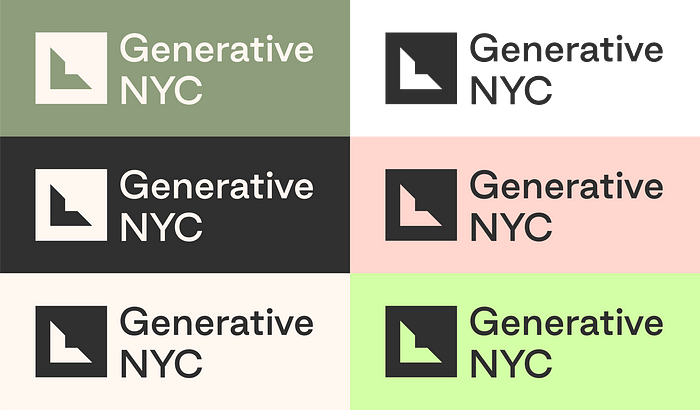
The very first Generative NYC meetup will take place on May 16th at Lightspeed NYC near Union Square at 6pm ET. Our first featured speaker will be Ziad Sultan, VP of Personalization (AI/ML) at Spotify and an AI pioneer. Ziad and his team are directly responsible for all-things AI for the world’s leading audio platform, such as the features that enable Spotify to perfectly program playlists and music discovery for each individual user, as well as the new AI DJ, which recently launched to much excitement. If you’d like to attend, head over to our event page here to sign up. Also, if you’re part of a local team that’s interested in demoing your product, please fill out this form.

As we embrace a new era of AI-driven innovation, Generative NYC aims to be a center of gravity for the local AI community. Through informative talks from local experts, product demos, and networking, we aspire to create a thriving environment where builders of AI products can collaborate and inspire one another.
Whether you’re building a product that’s already found product market fit or hacking away on your first prototype, please join us at the inaugural Generative NYC meetup on May 16th. Let’s build the future of AI together, right here in NYC.

Leading Lights Hits London: Founders of Iconic Startups Share Stories.
At Lightspeed, we know many of the best ideas and most innovative business models come from companies located outside of the US.
A few weeks ago, we hosted our annual marquee event, Leading Lights, in London. We’ve been holding this event for many years in the U.S., and this was the first time we held it overseas. The room was filled with 200+ entrepreneurs from the EU and the energy in the room was palpable.
Earlier that day, we announced our new office in London and new Partners in Paris and Berlin. The startup community in Europe is vibrant and growing — in fact, more than 1 million jobs have been created by venture backed companies in Europe since 2000. We believe many of the next generation of era-defining companies will be born outside the US, and our commitment to building a global firm came from this deeply rooted belief that innovation would be global.
As a result of our early commitment to be global, more than half of Lightspeed’s 70 investors are now located outside the US, across 12 offices in 6 countries. And 45% of our approximately 900 portfolio companies are international. That generates a whole lot of learning that we look to bring to founders we partner with.
The “Leading Lights” event series originated with our desire to celebrate Founders and offer a close up and personal look at the ups and downs of their company-building experience. It’s especially important to recognize innovative entrepreneurs in the context of the many challenges facing Founders today, from a global pandemic to economic downcycles.
We’re grateful to our amazing lineup of speakers for their time and especially for their candor. Read below for a few of the insights and learnings they shared with the Lightspeed Founder community:
We heard from two gaming visionaries about the status and future of gaming — Lior Shiff, CEO & Co-founder of Tripledot Studios — a London-based mobile games company which was recently valued at $1.4B — and Carolin Krenzer, CEO & Co-founder of Trailmix, the London-based makers of the hit game Love & Pies.
Euan Blair, CEO and Founder of Multiverse, took the stage with Mercedes Bent to discuss the future of work and education.
Henry Ward, CEO and Co-Founder of Carta sat down with Will Kohler to discuss the company’s past, present and future.
Arif Janmohamed chatted about the incredible story — including the highs and lows — of building TripActions, with its CEO and Co-Founder Ariel Cohen.
Grafana Labs’ CEO and Co-Founder Raj Dutt sat down with Gaurav Gupta to talk community, and share some advice for Founders/CEOs.
And Will Kohler and Alexi Robichaux, CEO and Co-founder of BetterUp, talked about what’s happening in the mental health and well-being space, as well as how to scale as both a leader and company.
Lightspeed’s commitment to building a global firm began 15+ years ago from a deeply rooted belief that innovation would be global, that insanely talented and ambitious founders would build everywhere, and that the pace of technology adoption would accelerate in all large markets — all things that we know to be true today.
A few photos from Leading Lights in London 2022 follow below. For info and an invite to future Lightspeed events, please reach out to events@lsvp.com.
About Lightspeed: Lightspeed Venture Partners is a multi-stage venture capital firm focused on accelerating disruptive innovations and trends in the Enterprise, Consumer, Health, and Fintech sectors. Over the past two decades, the Lightspeed team has backed hundreds of entrepreneurs and helped build more than 500 companies globally including Affirm, Carta, Cato Networks, Epic Games, Faire, Forty Seven, FTX, Guardant Health, Mulesoft, Netskope, Nutanix, Rubrik, Sharechat, Snap, TripActions, Udaan, Ultima Genomics and more. Lightspeed and its global team currently manage $18B across the Lightspeed platform, with investment professionals and advisors in the U.S., China, Europe, India, Israel, and Southeast Asia. www.lsvp.com

Building Tomorrow’s Boardroom, Today — Part III
Last week, Lightspeed and Rich Talent Group had the pleasure of hosting our third annual “Building Tomorrow’s Boardroom, Today” event, bringing together 130+ business leaders virtually, with a focus on the Latinx community.
The theme of this series is to promote Action, Access, and Learning, with a mission to drive greater diversity in the boardroom. While many top business leaders have made public commitments to be more inclusive, there is more work to be done, particularly in regard to the largest minority group in the US.
Despite accounting for 18% of the US population and 25% of national GDP, Latinx people occupy fewer than 3% of board seats in the Fortune 1000. Latinas account for less than 1%. Three-quarters of those companies had no Latinx directors at all in 2020.
What should organizations do to change this? How can members of the Latinx business community make their voices heard?
For our third event in this series, we convened a panel of distinguished Latinx business leaders to discuss what tomorrow’s boards need to look like, led by a brief keynote by US Senator, Alex Padilla. Our panel included:
- The Honorable Aida Alvarez, Business Leader, Public Servant and Philanthropist (Boards: Hewlett Packard, Inc., Oportun, Stride, Fastly)
- Elena Gomez, Chief Financial Officer, Toast (Boards: Smartsheet, PagerDuty)
- Andrea Perez, Global VP/GM Women’s, Jordan Brand, Nike (Boards: hims & hers)
- Raul Vazquez, Chief Executive Officer, Oportun (Boards: Oportun, Intuit, Latino Community Asset Builders)
Beyond gender and ethnicity
“The good news is that the conversation around the need for more diverse boards is trending in the right direction,” says Elena Gomez, CFO of Toast, a cloud platform for the food service industry. “It’s really heightened in the last 24 to 36 months. But we still have many years to go before we no longer need to have that conversation.”
However, the need for diversity on the board extends beyond gender and ethnicity, argues Gomez, who also serves on the boards of Smartsheet and PagerDuty. A successful board needs people with diverse backgrounds, experience, and skill sets.
As a result, companies are taking more time and looking in new places for board members, says Raul Vazquez, CEO of Oportun, which provides personal finance services for consumers with limited credit histories.
“Boards spend a lot more time on critical self-reflection than they used to,” adds Vazquez, who has a seat on the boards of Intuit and National Association for Latino Community Asset Builders (NALCAB).
“There’s more work towards filling in the gaps and looking at a broader set of skills, in order to achieve their business strategy,” he adds. “That’s led to a lot more opportunity for the people like us on this panel.”
Filling seats during the era of COVID
Seeking to fill board seats during a pandemic only added to the challenge, notes The Honorable Aida Alvarez, who ran the US Small Business Administration during the second Clinton administration and serves on the boards of Oportun, HP, Stride, and Fastly.
As chair of Oportun’s Nominating, Governance, and Social Responsibility Committee, Alvarez was tasked with finding candidates for four of the company’s board seats over the last year. The process, which was almost entirely virtual, took nearly eight months.
“We ended up with a really great group of people who were diverse in every respect in terms of race, gender, and different skill sets, but we did have to go the extra mile to come up with a slate that met all of those objectives,” she says. “You have to see a lot of people before you can say here’s a really great fit.”
Andrea Perez, who heads up the women’s business for Nike’s Brand Jordan, was added to the board of hims & hers last March, while the pandemic was still raging. Most of her interactions with the executive team and fellow board members have been virtual.
“The foundation of a great board is trust, and that’s a bit harder to establish in the virtual world,” she says. “When it comes to onboarding, I think it’s a good idea to meet with every member of the team and the board, and hear the strategic questions they need clarity on. It takes time, but it helps establish a basis of trust so you can have the hard conversations that are necessary.”
Lifting up others
Every Latinx who is asked to serve on a board has a personal responsibility to lift up others so they’re more visible, says Perez.
“Once you’re on one board, you become an attractive target for other boards,” she adds. “It’s an opportunity to have a conversation about other amazing business leaders. Who are the other leaders we’ve worked with that we think these people should know?”
It also helps to position yourself as a kind of product or a brand, adds Vazquez, who says he’s spent a lot of time poring over LinkedIn looking for potential board members.
“Be intentional,” he suggests. “Make it known in your profile that you are a Latinx and looking for a board position. “
Of course, being the first of anything (e.g., woman, person of color) to be on a board can be challenging. And while ideally the board focuses on creating a sense of belonging so that each board member feels confident and respected, the key to overcoming imposter syndrome is your own mindset.
As Vazquez puts in, “In life we get to choose the stories we tell ourselves. I strive to tell myself empowering stories. I choose to see being a Latino as my superpower. It gives me a unique opportunity to add value and be a fantastic board member.”
Tips & Advice
- Don’t appoint your friends. If you’re looking to fill board seats, look outside your inner circle. CEOs need people who are willing to speak truth to power, regardless of the consequences.
- Fill knowledge gaps. Look for members who can fill in where your company’s expertise might be lacking. Diversity is about more than gender or race; it’s also about finding people with varied skills, backgrounds, and perspectives.
- Be intentional. If you are looking to serve on a board, make your desires known, via personal contacts or things like your LinkedIn profile.
- Establish a buddy system. After you’ve been on-boarded, find a fellow board member who can answer your questions and give you the lowdown.
- Find your voice. Figure out where you can add the most value, and strive to fill that niche.
- Understand the issues top of mind for boards. Today’s boards are paying more attention to social and environmental issues (e.g., culture, Covid, climate), as well as digital transformation and cyber security. Bringing expertise in one or more of those areas could make you a more attractive board member.
For more tips, read about our previous “Building Tomorrow’s Boardroom” events here and here.
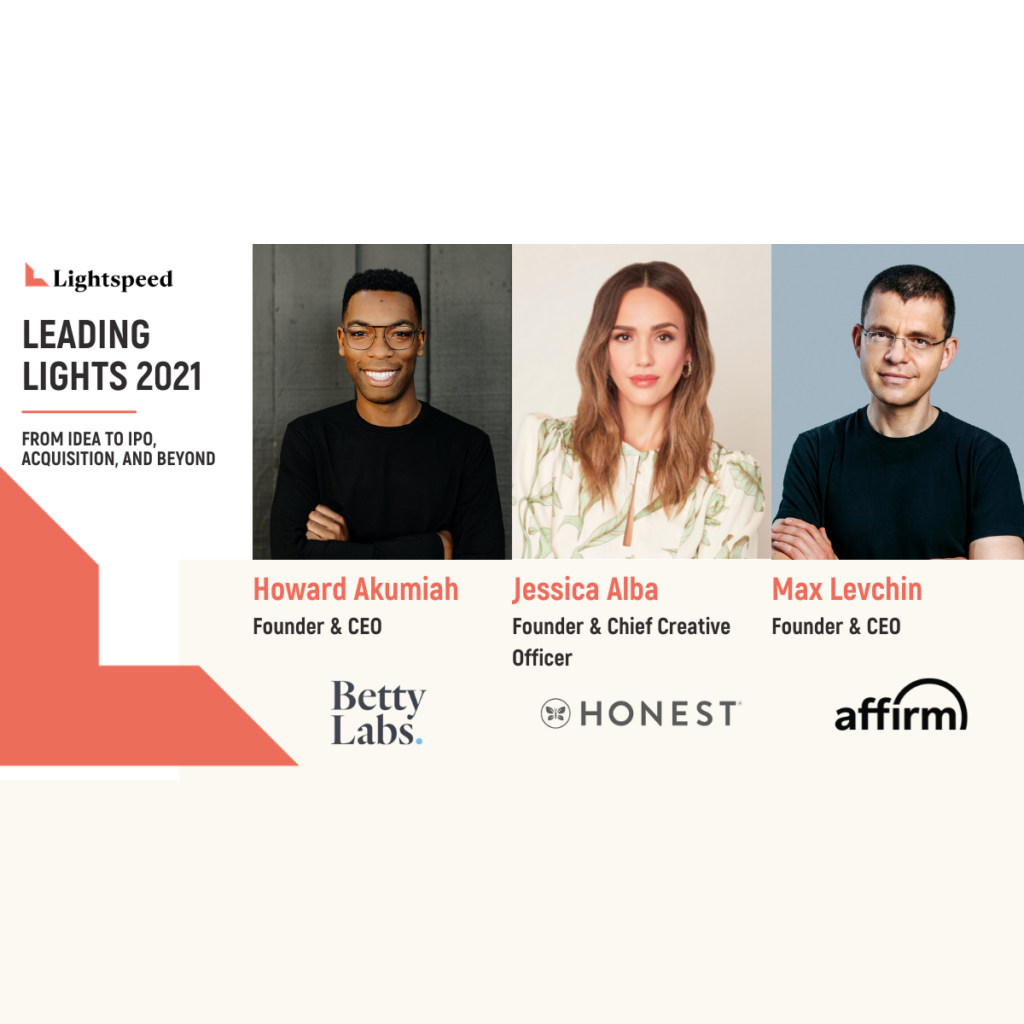
Jessica Alba, Howard Akumiah, & Max Levchin: Lessons Learned on their Journeys to Exit
Three seminal founders joined us to talk about how they went from idea to IPO and acquisition
The journey from startup to success rarely unfolds in exactly the same way. Every founder has their own story to tell, but some common themes unite them.
What do The Honest Company’s Jessica Alba, Betty Labs’ Howard Akumiah, and Affirm’s Max Levchin have in common? They all experienced a liquidity event this year. Two took their companies public, the third was acquired by Spotify. Each is a great example of the types of founders Lightspeed seeks to back since we began our Leading Lights series, celebrating leaders who have unique insights, not obvious ones.
In candid conversations with Lightspeed Partners, they break down some of the difficult decisions and circumstances they’ve faced along the way — including when to pivot, whether to accept an acquisition offer, being the only woman or person of color in the boardroom, and when it’s time to let someone go. (We’ll be publishing Q&As with each founder that go deeper on all of these issues — stay tuned.)
Perhaps the greatest thing that unites these three entrepreneurs is a strong sense of mission, which helps them overcome barriers they’ve faced when going against the mainstream on their path to success.
Difficult decisions in tough times
Howard Akumiah wanted to build an innovative product that helped sports fans engage with their favorite pastimes in more creative ways. But like a lot of founders, he realized he had to pivot sharply in order to achieve his mission.
After working at Google, Facebook, and Pinterest, Howard launched Betty Labs and developed Sideline, an app that allowed fans to participate in quizzes and win money during live sporting events. Growth was steady but unspectacular.
In January 2020, Howard made the difficult decision to pivot the company and build Locker Room, an audio platform for real-time sports conversations. Around that time he parted ways with his co-founder.
“That’s a very emotional and difficult maneuver to land,” Howard told Lightspeed’s Mercedes Bent. “That said, I think the decision to part ways with a co-founder or employee should always be arrived at through really rigorous logic. We felt it was difficult for us to execute on our ambitious vision because we had someone who did not believe in that vision.”
Less than two months later, all professional sports were brought to a halt by COVID-19. Suddenly there were no longer any games to run quizzes against. But without anything to watch, sports fans were eager to connect with each other — and Locker Room was where they chose to do it.
“Making the decision to shut your main product down and pivot to something else is a major gambit, but it was also exciting. The audience for Locker Room was doubling in size every three days, and the more people who were on the platform, the better the conversation got.”
Ultimately, however, he made another difficult decision — to sell the company to Spotify.
“I’m a very competitive person. I knew we’d built a great product, but we were always seen as being second to Clubhouse, and it began to grate on me. Partnering with Spotify gave us the best chance to become the number one company in audio.”
Diversity as a core value
Jessica Alba launched The Honest Company nine years ago after looking into the harsh ingredients that go into many baby, personal care, and household products. She thought, there have to be better options, both for her family and for the planet.
It was a cause before it became a company. Now The Honest Company is a publicly traded entity with a market cap of nearly $1.5 billion. Yet that strong sense of social purpose survives to this day.
As the only woman in the boardroom for many years, Jessica had to fight to represent her customers, who are overwhelmingly daughters, wives, and mothers.
“It took me a while to get comfortable with being the only voice of the customer,” she told Lightspeed’s Jeremy Liew. “When you’re representing half the population but it’s still one against nine in the room, you have to remind them who’s buying these products. I needed the board to understand that maybe I’m not the most seasoned entrepreneur and I haven’t launched 80,000 companies, but I’m coming at this from a genuine place.”
When Jessica first met with Jeremy in 2011 (read more about the early days here), we immediately grasped the market potential for socially and environmentally conscious products, as well as the value of having a diverse team making decisions. Now diversity is built into the DNA of the company.
Today, roughly 60 percent of The Honest Company employees and five of its nine board members are people of color. More than half of the people in leadership roles are women.
“Businesses that have more diversity get to solutions faster and are more successful,” Jessica noted. “But you can’t just say, ‘We’d love to hire more women and people of color.’ You have to put in the infrastructure around hiring practices and skill development. That’s why we started The Honest University, to help our people achieve their professional goals.”
Representation matters. It is hard to be what you can’t see. And that is why we celebrate the stories of women, Black, Latinx, and immigrant entrepreneurs, so the next generation of founders can see successful people who look like them.
Building the right team at the right time
Similarly, Affirm is driven by a strong sense of purpose: to deliver financial products that help improve people’s lives, without hidden fees, penalties, or excessive interest.
“Very early on at Affirm I was fixated on drafting a clear mission statement and being very crisp about our core values,” Max Levchin told Lightspeed’s Nicole Quinn. “Why are we doing what we’re doing, and how are we going to do it? What are we never going to do? Who’s the enemy? What sort of war are we signing up for?”
Yet despite a storied history of successful exits that includes Paypal and Slide, Max says he’s continuing to learn new things in his 10 years running Affirm, including when personnel changes are necessary for the good of the organization.
“The thing I’ve had to learn, some of it quite painful, is that the people who are amazing in the first two or three years of a company end up being absolutely not the right people for years five, six, and seven,” Max noted. “A lot of founders will think ‘Wait, this is my co-founder or close friend, someone I really trust.’ But some people scale, and some people don’t. And fundamentally, all of these companies are about people.”
He added that having a trusted core of thought partners is just as important as having the right team in place.
“I feel extraordinarily blessed to be married to a woman who’s been an equal partner in everything I’ve done. Not a single strategic decision happens without my having a multi-hour conversation with Nellie. I’m also lucky to be surrounded by long-time investors like Jeremy and Keith Rabois that I can call in the middle of the night. It’s not quite as intimate as fighting to the wee hours while wearing pajamas, but it’s close.”
You can learn more about the Affirm journey here.
What’s Next
We launched the Leading Lights event series in 2016 to highlight the success of founders and execs in tech with unique insights. We deeply believe representation matters and celebrate the stories of women, Black, Latinx, and immigrant entrepreneurs, so the next generation of founders can see successful people who look like them. It is hard to be what you can’t see.
In past years we’ve told the stories of people like the CEO of Task Rabbit, Stacy Brown-Philpot; the Chairman of Microsoft, John W. Thompson; the founder of Zola, Shan-Lyn Ma; and the founder of GIPHY, Alex Chung.
A heartfelt thanks to Jessica Alba, Howard Akumiah, and Max Levchin for joining the ranks of Leading Lights alumni and sharing their time, candor, and insights.
If you’d like an invite to Lightspeed’s next Leading Lights event, send an email to events@lsvp.com.
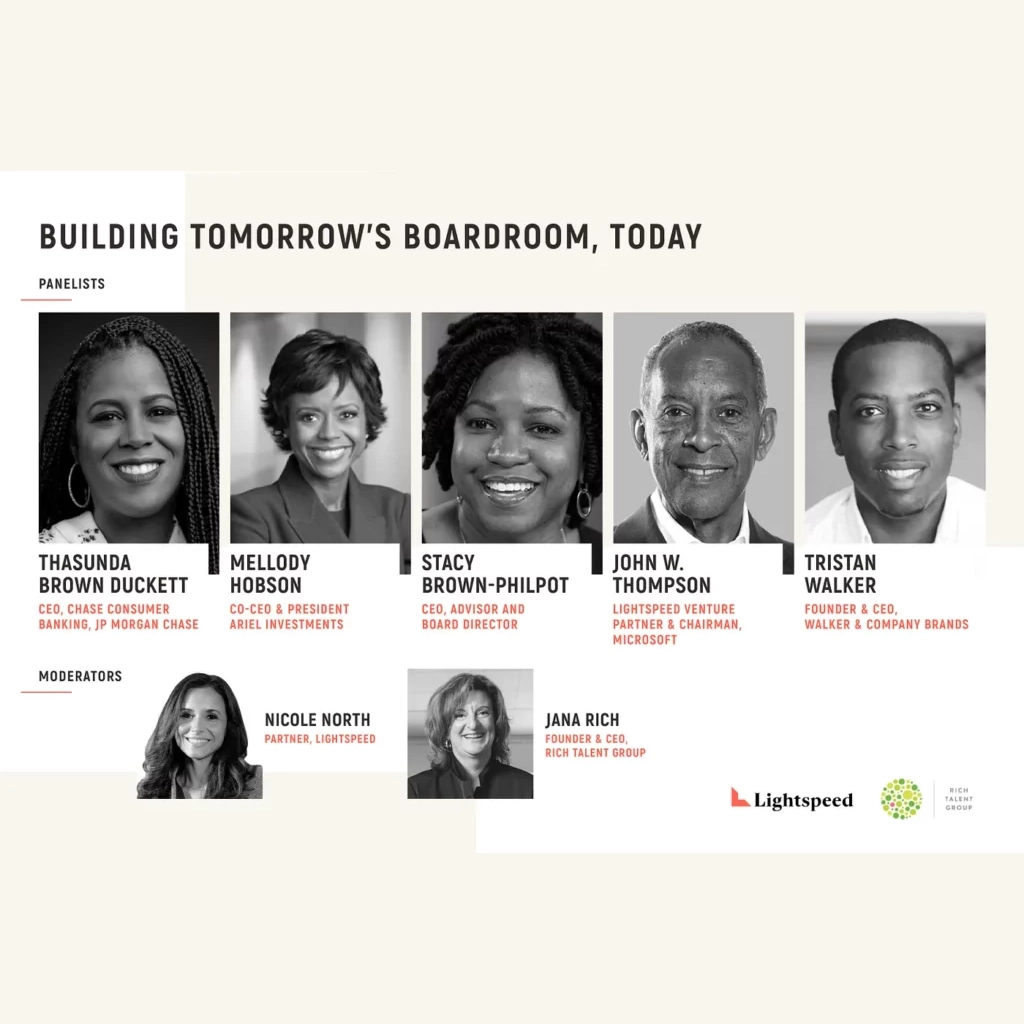
Building Tomorrow’s Boardroom, Today — Part II
Driving change for Black leaders in the boardroom
This week, Lightspeed and Rich Talent Group hosted our second annual Building Tomorrow’s Boardroom, Today event — focused on supporting and promoting more people of color to the boardroom, especially from the Black community.
We were thrilled to have more than 160 leaders — CEOs, investors, founders, board members, and aspiring board members — gather with us virtually to help drive meaningful and necessary change.
Black leaders are one of the most under-represented groups in the boardroom. In 2019, 10% of board seats in the country’s 3,000 largest public companies were held by non-white directors. And only 4% were held by Black leaders.
While for many, these statistics aren’t new news, the events of 2020 and the Black Lives Matter movement brought a newfound attention to this considerable imbalance. In the five months after the killing of George Floyd, 130 Black board members were appointed to the country’s largest public company boards — compared to just 38 in the 5 months prior. A 240% increase.
In addition to the progress ushered in by individual companies, systemic changes are starting to take hold as well. Last fall, a law was passed in California, AB-979, requiring that all public companies headquartered in the state have at least one director on their board who identifies as an underrepresented minority. Even Nasdaq recently proposed a similar measure for all companies on the exchange.
This is positive momentum, no doubt. Whether the timing of it is late, or intentions sometimes fuzzy, we want to build on it together.
We want to share a big thank you to our outstanding panelists, who were the heart of our event — sharing wisdom and experiences from their esteemed careers:
- Thasunda Duckett — CEO, Chase Consumer Banking, JPMorgan Chase; Boards: Nike
- Mellody Hobson — Co-CEO & President, Ariel Investments; Boards: Starbucks, JPMorgan Chase
- Stacy Brown-Philpot — former CEO TaskRabbit, Boards: HP Inc., Nordstrom, Black Girls Code, The Urban Institute
- John W. Thompson — Venture Partner, Lightspeed Venture Partners, Chairman of Microsoft; Boards: Microsoft, Reviver, Illumio, Rubrik, Illumina
- Tristan Walker — Founder & CEO, Walker & Company Brands, Boards: Foot Locker, Shake Shack
Here are some key takeaways from our conversation about what boards are looking for, the recruiting process, assessing fit, and how to show up at your best once you’ve landed the job:
What boards are looking for and the recruiting process:
1. Boards aren’t just about governance, they’re shaping the future.
With the current rate of disruption, boards aren’t just focused on the present. They’re thinking about where the company wants to be in five to ten years and what capabilities board members need to help achieve that. While a board may hope to diversify by adding a woman or person of color, they’re also evaluating the skills and future-focused orientation that those candidates bring.
2. A global outlook matters more than ever.
The pandemic has not only impacted how boards convene (with virtual meetings being a major shift from in-person), but also what expertise they value. Across multiple boards, global public policy is a growing area of demand as it becomes increasingly important to understand what’s happening around the world — especially for companies operating outside the U.S.
3. Get clear on your brand.
To position yourself as “board ready,” the first thing you should do is get clear on the perspective and expertise you bring. If you don’t know how to talk about the areas you major in or your track record of performance and outcomes, getting a board seat will be tough — no matter who you know.
4. Build your network.
In your board search process, it’s important to focus on building and nurturing relationships. Speak at an event; connect with recruiters; talk to current board members. And don’t just look to those you view as “power players” — you want to show up as your best self in every situation, because you never know who might end up providing a great reference or be reached out to informally for an “off-the-record” check.
Assessing whether a board role is right for you:
5. Follow your passion.
If you conjured up your dream list of boards, what would they be? Define what you care about (e.g., Retail? Tech? Social change?) and use that as a filter to assess opportunities. Ask yourself: Am I curious about this? Will I be intrigued to read hundreds of pages of briefing materials? Do I have expertise I can offer? What might I learn from serving on this board? Just because a great brand comes to you, doesn’t mean it’s the right fit.
6. Be choiceful.
A board role requires significant time and is a multi-year commitment. So in addition to gauging your passion, make sure you’re really up for it. Are you ok flying from one coast to the other for board meetings? What about spending Saturday reading that 300+ page briefing? What tradeoffs will it require of your personal time? If it’s not the right fit, you have to learn to say no.
7. Consider the people around the table.
You’re going to spend a lot of time with your fellow board members. They set the tone and culture of the board, so don’t forget to factor this into your decision-making process. Ask yourself: Who are they? Do they come to the table with a sense of humility? Do I want to learn from them? What about the CEO — is it a person of high integrity that I’d like to know better?
8. You’re in the room, make the most of it.
It can be challenging as a board candidate to feel like you’re being considered for a role because of your gender or your race. Are they just trying to “check a box?” To better understand a company’s intention ask questions like: What do you want me to bring to the room? If I exceeded expectations, what would that look like? At the end of the day, if you can get on a board, it’s a great opportunity to use your power for good, no matter how you got there.
Showing up as your best, as a board member:
9. Be the boss of your own onboarding.
Boards may or may not have a formal onboarding process; just make sure you’re not waiting for someone else to do it for you. You have a right to ask for information — exercise it. Who do you need to sit with to better understand the business? The board and the executive team are busy, yes, but it’s never a waste of time educating someone to be a better board member.
10. Never stop learning.
Serving on a board is a constant learning journey. The better you understand the company, its leadership team, and its strategy, the more impact and influence you’ll have. Consider sitting in on committee meetings that you’re not part of to see how decisions get made — it will no doubt deepen your ability to contribute.
11. Relationship building doesn’t stop just because you got the job.
Fostering relationships with your fellow board members is an ongoing process and key to building good chemistry. Don’t be hesitant to reach out, whether it’s a casual hello to build rapport or a request for feedback so you can improve. It’s also important to stay connected to the executive team. Every relationship/company will vary, but for some, this looks like a quarterly call with the CEO and/or another leadership team member to understand what’s happened in the business since the last board meeting and how the board can help. Remember, boards matter most when things are bad. In those moments, you want to be around people you trust — and that only comes from relationships.
12. Bring your full self. And pay it forward.
There will be a lot of new people of color on boards this year. Whether you’re the first, the newest, the youngest, don’t forget to bring your voice and your culture to the boardroom. There are employees and customers who need your insights. It’s easy to feel like you shouldn’t speak up when the rest of the room doesn’t look like you, or you want to avoid being typecast on certain issues. But you are there for a reason. If you leave part of yourself at the door, you’re not delivering what was expected when you took the role.
Written by Nicole North and Jana Rich
***
To learn more about last year’s event, read our recap here.
We plan to focus our next event on the LatinX community. If you have questions about how to be involved, please reach out to events@lsvp.com.
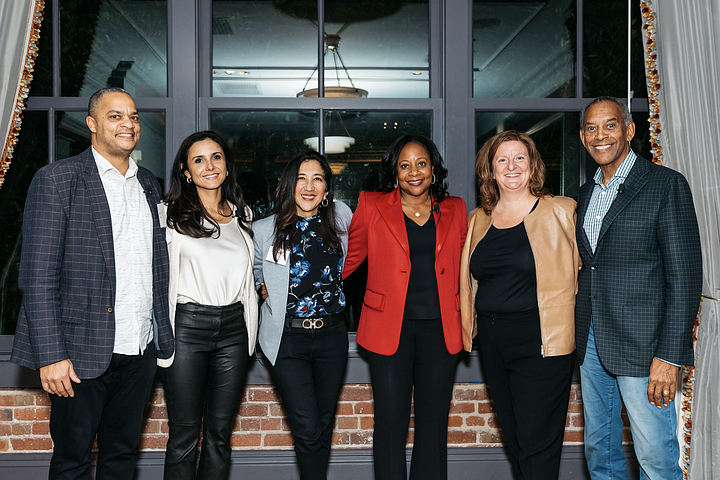
Building Tomorrow’s Boardroom, Today.
By Nicole North and Jana Rich
This week, Lightspeed and Rich Talent Group had the privilege of hosting our first “Building Tomorrow’s Boardroom, Today” event in San Francisco, centered around the actionable steps leaders can take to empower and promote people of color and women to the boardroom.
We’re proud at Lightspeed that over 33% of our consumer portfolio companies are female-founded, but we recognize that we still have a long way to go, and that diversity means so much more than gender. In fact, people of color are one of the most under-represented groups in the boardroom. Currently, women make up 26% of Directors in the S&P 500, while minority women make up just shy of 6%, and, 37% of the S&P 500 don’t have a black Director. That has to change and that’s what “Building Tomorrow’s Boardroom, Today” is all about — driving necessary and meaningful change.
It’s not all doom and gloom though — there’s evidence that the world is moving in the right direction. Take California’s 2018 Board Gender Diversity Bill, for example, as well as Goldman Sachs’ recent announcement that they will not take companies public unless the company has at least one diverse board member. That’s also what Rich Talent Group is working towards — building diverse, transformative teams. Since its inception, 75% of Rich Talent Group’s successful candidates in operating roles added diversity to the team they joined, and nearly 100% at the board level are a woman, person of color or LGBTQ.
It was tremendously inspiring to have so many change-makers in one room and hear directly from thought leaders about where we are today, and where we’re going. We’d like to offer a heartfelt thank you to our powerhouse panelists — John W. Thompson (Venture Partner at Lightspeed, Chairman of Microsoft and board member of Rubrik, Illumina and Seismic), Robin Washington (former CFO of Gilead Science and board member of Honeywell, Salesforce, and Alphabet), Mike Smith (President and COO of Stitch Fix, and board member of Ulta Beauty and Herman Miller), and Elena Gomez (CFO of Zendesk and board member of Smartsheet, PagerDuty and Berkeley’s Haas School of Business) — for sharing such candid, personal stories about their board journeys and covering important topics ranging from board selection, how to manage a board with a day job, onboarding and training new board members, and so many more examples of invaluable real-world experiences.
Here are a few key takeaways:
- Put yourself out there. Board recruitment can vary when it comes to timeline and process, but networking always pays off. Oftentimes, a candidate ends up on “the list” because they made it known they were interested in joining a board and someone advocated for them.
- Do your diligence before joining a board. Ask yourself: Is this a board where I can contribute my unique expertise and experience? Is this a board where I will learn something that’s of value in my life? In my operating role? Have clear criteria for opportunities that are right for you, because the time you’ll commit to a board is significant.
- Being a good board member is more than showing up at meetings. Knowing the business, industry, and competitive landscape are table stakes, but don’t forget to get to know the people, too. For example: Learn more about fellow board members by switching up who you sit with at dinner. Immerse yourself in the company by flying in a day early to meet with different teams.
- The board of the future is diverse. Period. It’s not about filling “the female seat,” or “the person of color seat.” It’s about always having a diverse slate of talented candidates in the pipeline and in your network.
Whether you’re a current board member, future board member, founder, or operator, the decisions made in the boardroom have a tremendous impact on your company, your community, and on the tech ecosystem at large. It’s critical we all do our part to get more under-represented groups a seat at the table.
If you’re interested in attending this event or other related events in the future, please reach out to events@lsvp.com.
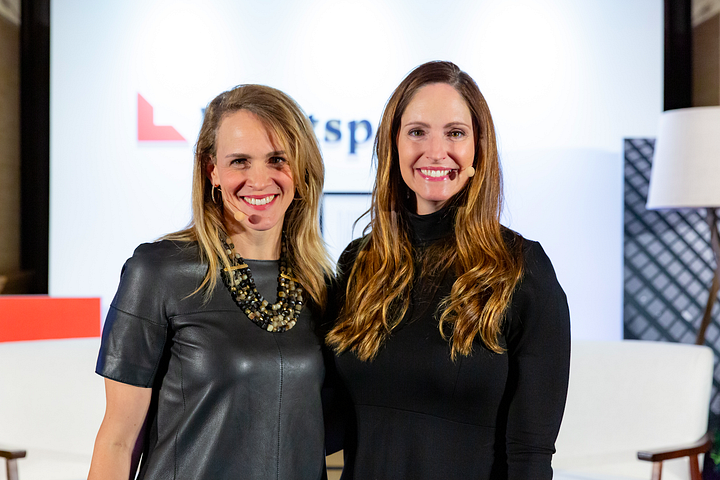
Lightspeed Enterprise Scale Summit: Q&A with Christa Quarles
At Lightspeed’s recent Enterprise Scale Summit, we had the opportunity to hear from some of the tech industry’s most visionary leaders on the topic of scale.
The questions they tackled were fundamental to every ambitious enterprise startup that hopes to one day become a MuleSoft or Nutanix. What do leaders need to do differently as their company gets bigger? When is the right time to plan for global expansion? How do you preserve culture as you grow from 4 employees to 4,000?
At the summit I had the great pleasure of interviewing Christa Quarles, former CEO of OpenTable, the online reservation service that seats 26 million diners per month. Today she’s on the board of Lightspeed portfolio company Affirm, as well as Kimberly Clark.
Among other things, we talked about what it’s like to take the reins at a company with huge US market penetration but no real strategy for how to scale into a global enterprise.
Here’s some of what Christa had to say. For the full interview, check out the latest episode of Lightspeed’s podcast, “Tomorrow, built today.” And be sure to visit Lightspeed’s blog for additional insight from featured Enterprise Scale Summit speakers including Chuck Robbins (CEO of Cisco), Henry Ward (Founder and CEO of Carta) and Jay Simons (President of Atlassian), coming soon.
Let’s start by talking about your experience building go-to-market teams for Open Table. What was it like when you arrived? How did it evolve?
OpenTable was largely a sales-driven culture, so the sales team just kept going at it and going at it. But the world around us was changing, so the product and the strategy needed to change. To get to the scale we needed we had to redefine what these people were doing every day.
I think the most important thing I did when I first got there was to meet with 120 restaurateurs and build deep empathy for them.
Turns out there’s a huge spectrum of restaurants. There’s the base layer that are like, ‘Just get some butts in seats’. We were effectively driving their marketing automation, even if we didn’t really behave like a marketing partner. That was a signal we needed to evolve our product around that layer.
The next layer was, ‘OK, now we need operational help. We need the software that helps us figure out how to put more butts in seats.’ Internally we called that Tetris — moving tables around to increase throughput.
But there are also large-scale enterprise restaurants with very different needs. They need different kinds of reporting and controls over who can see what. They need help creating magical, beautiful experiences.
A big decision for us was, should we go after the enterprise? If so, how do we do it when our team doesn’t act, speak, or understand enterprise? So that became almost a startup inside Open Table.
When you joined OpenTable, it had high market penetration but low growth. How did you turn that around?
This is a challenge you see in a lot of companies where the original product served a very specific total addressable market. And when they hit a roadblock they go sideways. That’s when you need to figure out which assets you have that no one else has. For example, nobody has better data than Google at the discovery layer. But we know which butts sat in which seats at which times.
We started listing restaurants we did not have a commercial relationship with. That allowed our sales teams to go into those restaurants and say ‘Did you know that 2000 people came into your restaurant last month, but 500 booked somewhere else? Don’t you want those people in your place?’ It’s not simply using data to make the sale; data is the foundational level of who and what we are.
How did you expand Open Table internationally?
When I joined, our international business was not super healthy. There was a different app in every market; if you lived in New York and searched for restaurants in London, you 404’d. Our sales teams tried to take an approach that had worked in the US and replicate it internationally, but it wasn’t working. There’s a lot more competition overseas, the markets are different, it’s not the same rule book.
We learned that what got us to scale here wasn’t going be effective there. I would always push my teams to come up with the crazy, unscalable thing we needed to do in order to get to scale. That kind of thinking requires people with an entrepreneurial mindset, which we did not have a lot of at the time. So we had to find them.
What causes you to re-evaluate how a company is structured?
There’s something I call the ‘exponential scale of breakage,’ where at 50, or 150, or 500, or 2000, or 10,000 people, the organization breaks. It’s actually a great thing you’re breaking because it means you’re still growing. So how do you use these moments of breakage as organizational leverage? Breakage is a sign that something isn’t working the way that it needs to, so it’s an opportunity to lean into it, feel the pain, understand it, and then benefit from it.
What was the culture like at OpenTable, and how did it change?
When I came to OpenTable it was a culture based on fear. It was like ‘Oh my God, what if I do something and it doesn’t work?’ The fear of being super innovative was embedded in the culture. As CEO, I could choose what to reward and what to not reward. I decided to make it unsafe not to take risks. People who were always trying new things had the spotlight on them. But if you were just standing still, that was not a safe place to be.
Today’s summit is all about scale. What’s the number one thing entrepreneurs, founders, and CEOs can do to scale their companies?
Really pay attention to the anatomy of the team. A+ talent not functioning well with the rest of the team will drag the whole team structure down. When I was in the gaming industry, people on the same team could tell each other to piss off, go have a beer, and get back to work in eight minutes. They were the best teams because they could speak honestly to each other. If you have high functioning teams with high functioning leaders you can go anywhere.

Unforgettable Stories and One World Trade Views: Highlights from our “Leading Lights” Series Featuring Shan-Lyn Ma and Alex Chung.
Last night we hosted our Annual “Leading Lights” Series at Mic’s beautiful office on the 84th floor of One World Trade (to say the views were breathtaking would be an understatement), where my partner Alex and I sat down with Shan-Lyn Ma, Co-founder of Zola and Alex Chung, Co-founder of GIPHY, and discussed the good, the bad, and the ugly of building an enduring company.
The name of this event, “Leading Lights,” originated with our desire to celebrate leaders who have unique insights, not obvious ones. Shan and Alex embody this to a tee. From Australia and Seattle to the Big Apple, Shan and Alex spoke of their journeys to disrupting the Wedding and Search industries, whether or not you should work with friends (spoiler: you should), and what the future looks like for both Zola and GIPHY. Check out this video or text below for some highlights of our conversations.
Thank you to the over 200 entrepreneurs, founders, investors and friends who showed up last night and helped drive forward meaningful discussions and connections. If you are as passionate about entrepreneurship as we are and would like to attend our next “Leading Lights” event, send us a note with your LinkedIn profile to events@lsvp.com.
Q&A with Shan-Lyn Ma:
Q: Tell me about growing up, and how your experiences and upbringing led you to become a founder?
A: I grew up in Australia. For those of you who are familiar, know it’s in the middle of nowhere on the other side of the world. Isolated both metaphorically and literally. Felt like all the action was anywhere but there. Read about the tech revolution in the US and I wanted to be a part of it. Unlike most people who I had a poster of Kylie Minogue, I had a poster of Jerry Yang, co-founder of Yahoo in my room. That brought me to Silicon Valley.
Q: What was your first job in tech?
A: At Yahoo of course, my dream company!
Q: What attracted you to NYC vs. Silicon Valley?
A: Moved to NYC to be the first produce person at Gilt. Best decision I’ve ever made. They were completely redefining shopping online at the time. It was my dream job. I thought to myself “if I’m personally shopping on this site every day, how fun would it be to work there and think about the site every day.” I’d have moved anywhere for it. But it was amazing to have a front row seat at the beginning of NYC’s tech scene. Just have to say. It used to be hard to find product people in NYC. Now there’s so much happening! NYC tech has completely changed and exploded here.
Q: NYC is also where you met Nobu, your co-founder. Tell us about that. What’s your co-founder story?
A: First have to say, I have the best co-founder in the entire world (Nobu). We got to learn a lot of lessons together at Gilt. We created a lot of products that customers love and talked over that time about how we’d love to start something together. We went to separate startups and didn’t feel ready to start something immediately after Gilt. Met up for lunch. We realized we were both ready and the next day we quit our jobs, gave plenty of notice, and started thinking about what we’d then create together.
Q: Did you always want to work in wedding? People have been wanting to disrupt the wedding space for 20+ years. Why did you start with registry?
A: In 2013, when we were thinking about what we wanted to start together, it was also the year that all my friends were getting married. As I was going through that registry experience, I was like this is the worst e-commerce experience ever. Nobu was getting married and it was just as bad from his perspective. The more we dug into it, the more we realized that there was a fundamental shift in how couples are getting married today. Couples today want products, experiences, cash, full control. No one was giving it to them. Registry was stuck in the 20s, when it was invented. It was a clear opportunity to create a better experience for couples and their guests. Best thing about starting with the registry was how it allowed us to innovate on the business model. Business model is one of the things we’re most proud of. How do we capture the best of e-commerce and marketplace businesses but leave behind the burden and pitfalls (avoid inventory, avoid returns, avoid unpredictability). Industry was ready to support it.
Q: Now you’re 5 years into it. Much bigger than registry. Talk about what Zola is now.
A: In a generation where experiences are important, the wedding is the ultimate experience. Hard to go to a wedding without everyone taking pictures and sharing the experience etc. That generational shift. How the wedding looks and feels for your guests has never been so high. Allowing couples to plan more and more of their wedding on the Zola platform in a way that we know makes it much easier for couples today. Our vision is how can we serve couples from the day they get engaged to their first year of marriage. Now we’re printing paper products — save the dates, invitations — etc. One of the most requested things from customers.
Q: How is the retail ecosystem responding? You announced a big partnership with Crate & Barrel that launched today…aren’t you competitive with Crate & Barrel? How does that work?
A: Today the Crate & Barrel boutique on Zola went live! We will now be selling 3,500 Crate & Barrel gifts in the Zola store. It’s a dynamic partnership that brings together a retail pioneer and a retail disruptor. It’s something that would have been hard to imagine 5 years ago. Today it’s the only place you can buy C&B stuff from somewhere other than C&B.
- Zola perspective — This partnership was born out of real demand by our couples. Crate & Barrel is the #1 externally added brand onto Zola registries (via our add to Zola button). Now couples will be able to register directly for Crate & Barrel dinnerware, furniture, home decor and more, plus the 50,000+ gifts we already sell and cash funds. This is the 4th retailer, and most notable, to choose Zola as an exclusive registry partner (ABC Home, Backcountry, Michael C. Fina).
- Crate & Barrel perspective — They want to reach new engaged customers where they already are, on Zola. They are focused on growing their registry business.
Q: The company has grown a lot. Zola headcount has more than doubled in the past year — how are you growing the company in a thoughtful way that is sustainable in the long run? And hasn’t F’d up the culture?
A: We’re now at about 140 employees. Still very small in terms of team size relative to the size of the skin of the business. Very thoughtful about every head / new role we open up at the company. As a leadership team, for every job that might be new, ask ourselves if we *really* need it and if it’s *really* going to positively impact the business. From our Gilt experience, 40 people to 1,000 people in 4 years. Very hard to manage from a business and org perspective. Taking a very thoughtful approach at Zola. It’s worked out well for us. Large reason we’ve been able to show capital efficiency.
Q: How do you recharge or take a break from work? How do you maintain balance?
A: I play HQ Trivia. Use my jumprope app. Angel invest in companies.
Q: Any specific words of wisdom for the young entrepreneurs in the room? Words of wisdom you heard from your mentors or maybe mentees?
A: Kevin Ryan, one of my mentors for many years, something that I try and keep in mind always: How can this idea be bigger? Even bigger than what we’re imaging today? Asking that question helps remove any artificial constraints. Helps remind us all that usually it’s the same amount of work to go after small or big so why not go big.
Q&A with Alex Chung:
Q: Let’s start from the beginning…where are you from and how did you end up in NYC vs. Silicon Valley vs. LA?
A: I grew up in Seattle, on the best coast. A few minutes away from the University of Washington, Microsoft, I saw all of that happen as a kid. Moved to SF in 1997–2004. Went through the dotcom boom and bust. Once I was done with engineering, what brought me to NYC, went to Parsons for Fashion. Bad idea. Then I became a graphic designer. Couldn’t afford my rent. Went back and forth, now I’m here. Been here for about 13 years. I think I’m a legit New Yorker now?
Q: What have been some of your biggest learnings along the way?
A: Learning #1. Never live in SF. That vibe of NYC, being able to meet up with anyone and hang out with anyone, it’s special. This used to be what it was like in ’97, went to the first pool party at Google, they had DJs and it was fun and then everyone got married and older and got fancy things and it became more gated. NYC still a local, small place. NYC or LA are the only places to start companies.
Q: First time I met Alex was in 2015. GIPHY had rented this awesome mansion in LA. So they could get the creative juices going all summer. GIPHY pool towels, floaties, etc. That’s how I like to envision your life. But what does a typical day for Alex Chung look like now?
A: Back in the day, we were working out of Airbnbs, couldn’t commit to office space or afford it. When half the company was going to LA to meet with studios, we were like why are we doing this. The amount of rent we’re paying for Airbnb ends up being the equivalent to a mansion in LA. Decided to rent a house. Life was so much better. Saving so much money on rent. Sushi. Everything is better. Ending up making it a tradition. Bonding moment. 30 days lived together and work together every day. Typical day? Last night I was up until 3 or 4am. Anyone who is a founder of a company knows, I get about 1,000 emails a day. Half get filtered out. I still have to respond to 500. So I spend half my day doing email.
Q: What’s something surprising that nobody knows about you?
A: I’m pretty open. Maybe I was here last week for an underground cage fighting karate combat tournament on the top of the World Trade Center. I’m a black belt, MMA 30 years. UFC fighters come through. One of our friends puts on these crazy karate tournaments. Everyone was in suits. It was like a post-apocalyptic scene.
Q: What is your leadership style and/or some of the core principles that guide GIPHY?
A: We have a bunch of values and core principals. The number one thing that we do. Hierarchical style — everyone is a collaborator, shareholder, co-founder. Everyone has an equal voice. If you get 100 people working together in a room, getting that community to work, and produce content, hard. Equal say matters. Treating people as people matter. End up getting the best ideas and most loyal people who are attached to work you’re doing. One of the reasons I only work with friends. We are a community, let’s figure it out. Our pillars:
- People before process
- Community before company
- Relationships before process
Q: What was your lowest/hardest time as a founder and how did you get through it?
A: Like this morning? I’ve been doing this for about 20 years. This is my 12th startup that was funded. Definitely failed more startups that you’ve started. I probably just suck as a startup founder. One of the things I’ve learned, co-founders love and hate each other. Your best friends are the ones you stick with. The reason you have co-founders, you have 3/4xs more probability of being successful. Co-founder pulls you through when you’re down. You pull your co-founder through when they’re down. If you were friends before, you’ll make it through.
Q: How did you find product-market fit? How did you find early customers?
A: In the beginning we didn’t have any competitors. There was no GIF search engine. “How do you even find these things?!” Registered GIFSearchEngine.com. Registered like a hundred of them (relevant domains). One of my product philosophies is, I only build things for myself. If I can’t convince myself it’s cool, then I definitely won’t be able to convince anyone else it’s cool. Once I started sharing, and other people started sharing, then I knew I was on to something. I guess that’s when I reached product-market fit.
Q: How do you monetize? How do you include ads in a meaningful way / balance it with a good user experience?
A: I don’t think most people know what we do. Most people think we’re a site with cat GIFs. The pitch deck has been the same for the last five rounds of funding. It’s always been about a new type of search engine. YouTube was the only other place could compete. There has to be a search engine to find the short form content. The internet went mobile. Mobile went to messaging. Only about 5 or 6 companies. We’re the largest search engine for messaging. Allow people to find content to bring into their messages. Now we do about 20% of the search engine of Google. People watch more GIFs every day than they watch YouTube videos. Probably the largest media company in the world from an impressions standpoint that no one talks about. So, how do we monetize? Doing $30 CPMs that I think we can talk about. Only ad platform successful at monetizing messaging at this scale.
Q: So, what’s next for GIPHY? What does an exit look like?
A: If we scale our revenue in the next 9 months, we have a potential of multi-billions in revenue per year. If we can’t do that, we could fail. We’re a potential acquisition for so many companies. If that doesn’t work, then we shut down and we all get new jobs. Tech industry is still good, despite what you hear. I mean we’re on the top of the freakin’ World Trade Center right now.
###
If you’re in NYC, I’ll be speaking at the Primary NYC Summit today at 11:30am on What’s Next for NextGen Commerce. Come say hello!
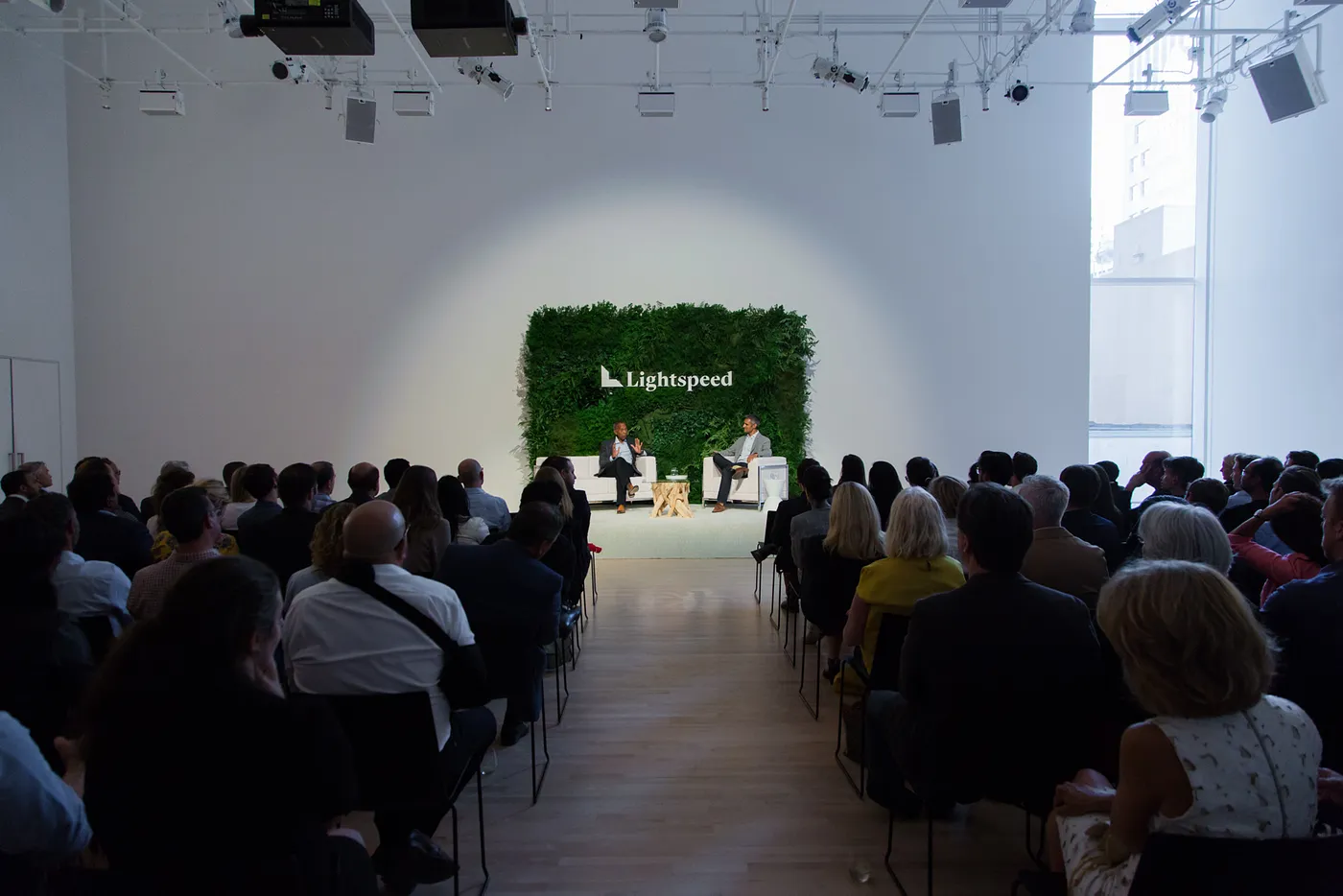
On Setting Crazy Goals and Running Toward Them.
Highlights from our Annual “Leading Lights” Series, featuring John W. Thompson and Bipul Sinha.
Yesterday was a pretty special day for the Lightspeed family.
In the morning, we announced the closing on $1.8B of committed capital for our new funds, Fund XII and Select III. And in the evening, we hosted our Annual “Leading Lights” Series at the beautiful SFMOMA, where my partner Ravi and I sat down with John W. Thompson, Chairman of Microsoft, and Bipul Sinha, Co-Founder and CEO of Rubrik, and discussed the good, the bad, and the ugly of building an enduring company.
The name of this event, “Leading Lights,” originated with our desire to celebrate leaders who have unique insights, not obvious ones. John and Bipul are the perfect embodiment of this. From West Palm Beach and Calcutta to Silicon Valley, John and Bipul spoke of their journeys to becoming CEOs, the importance of radical transparency, and why everyone should set crazy goals and run toward them.
Thank you to the over 200 entrepreneurs, founders, investors and friends of the firm who showed up last night and helped drive meaningful conversations and connections. It was one of those gatherings that will be easy to remember and tough to forget.
Below are some highlights from our conversations. If you are as passionate about entrepreneurship as we are and would like to attend our next “Leading Lights” event, send us a note with your LinkedIn profile to events@lsvp.com.
Q&A with John:
Tell me about growing up, and how your experiences and upbringing prepared you for a leadership role, whether CEO or Chairman?
- I grew up in West Palm Beach, Florida. My mom was a school teacher and my dad was a postal worker. They gave me the foundational pieces that structured my career. I learned from my dad the importance of focus and dedication. And my mom has a simple philosophy about life — it’s about life-long learning. That’s part of the reason I wanted to join Lightspeed as Venture Partner.
You spent 28 years at IBM. Let’s start there. Tell us about that?
- It was actually 27 years, 9 months, and 13 days…
What attracted you to the Valley?
- I thought software would change the world and wanted to be a CEO of a mid-size company. My wife and I had been married 6 months. I was about to be 50 and I thought if I really want to be a CEO, I might as well get on with it. I knew I wouldn’t be a CEO at IBM. I ran the software / biggest most profitable part of IBM. I wanted to make sure my dad knew about it before anything ran in the local paper. I told my dad I got a CEO job and he asked what is a CEO and what about your pension…
Symantec? What led to your success and tenure that led to 10X growth over a 10 year period?
- In the first three years, we went from 60/70% consumer to 60/70% enterprise and focused on how to scale from there. Veritas acquisition didn’t work well because I misjudged the cultural mismatch between the two companies. You should never dismiss cultural symmetry when evaluating a M&A opportunity.
So you went from CEO of a $6B company to a $6M company. What was that like? Learnings there?
- I never expected to take on the CEO role at VI. I asked another board member and he couldn’t do it because his wife was having health issues. I thought I might do it for a few years until we found someone else. After my first quarter there, we had our best quarter ever. So my view was, there’s no better time to go raise capital than right now. Lightspeed was the firm that said yes. That became the glue that caused me to stay. I would never walk away after raising money.
- As for learnings, when you go from something so big to so small, you can over-manage. You have to dial back your own point of view when you’re running a small company. Particularly when you’ve been around as long as I’ve been around.
That brings us to Microsoft…what major shifts did you witness?
- First step was cloud. True acknowledgement that the cloud was real. Second step. Focus on things other than Windows. If the company was going to sustain itself, it had to find another path.
Why Satya?
- We looked at a ton of external candidates and couldn’t find any that we really loved or that wanted the job. So we looked internally and Satya was the best candidate. What I didn’t know was just how emotionally connected Satya was to the culture of the company. He’d been there for 20 years and knew what worked and what didn’t work. He knew more than I did about the culture.
Why did you join Lightspeed? What excites you? Are you happy?
- I wouldn’t be here if it were not for you, Arif. And your relationship with Chris and Ravi. And everyone’s belief that my background and experience in the industry could be helpful to Lightspeed and your portfolio companies. I’m hopeful that I can find a couple deals and that will be validation of Chapter 4 of my career. (Chapter 1, IBM. Chapter 2, Symantec. Chapter 3, VI. Chapter 4, Lightspeed.)
Are you writing a book?
- I will never write a book!
Why not?
- Too focused on me. Sounds terrible. I guess my ego just isn’t big enough?
How should young entrepreneurs think about their roles in today’s world?
- Back in the day, people had more of a sense of loyalty to the company they joined. Turnover was minuscule compared to today. People in tech today have a stronger loyalty to their craft or their team within the company. There’s this notion today of creating a cohort of people that I know and love and like and respect and we all move from place to place together. Far more common today than it was 40 years ago when I started.
You serve on four boards. Two public and two private. Why?
- The answer on Microsoft is, I felt like it was in the same predicament as IBM circa 1990. I thought I could help Steve.
- At Illumina, it’s a business that I know nothing about. It surfaced right around the time that my sister who is two years older than me passed away from Alzheimers. This is a chance for me to learn about something totally different. In the spirit of life-long learning. I also coached the CEO throughout his career and couldn’t say no.
- In the case of private boards, it’s simple. I have capital invested. Any place that I put money, I’m more than willing to be an advisor but only in select cases will I consider being a board member. My dream with VI was to take it public. I hope to be with Rubrik when Bipul takes it public.
Q&A with Bipul:
How has being a VC influenced your approach to being a CEO?
- 90% of VCs don’t know what they’re doing. It’s critical to find a partner who understands the space and can help you think big.
Let’s take a step back. Can you tell us more about Rubrik’s work and mission?
- Rubrik delivers instant application availability to hybrid cloud enterprises for backup, recovery, search, cloud, & development. Our mission is to simplify how businesses around the world keep and use their data. Our goal is to build the next 20–30–40 year public company. We’re growing fast and thoughtfully. We’ve built the right leadership team and are focused on the people aspect of the business, which has served us well.
How did you find a product-market fit? How did you find early customers?
- When you start a company you need to have a thesis with a unique perspective about the market. But the source of truth is with the customer. You need to understand the customer’s pain and you need to understand how they perceive your product. Before we actually hired our first sales team, I had made 60 unique customer calls. You have to sell to believers in the early days.
How do you differentiate from your competitors?
- We’ve helped create a new market, bringing a fresh approach to a $50B market that hadn’t seen innovation in 10 years. When a new market is created, it attracts competition and big dollars. We’re proud to be the leading player in the space.
The arc for Rubrik is unlike anything we’ve ever seen in enterprise. You have a growth mindset. How do you think about growth?
- Many companies that I observed when I was a VC all had one key problem holding them back: nobody was actually making decisions. People were too terrified of a negative outcome. That creates a lack of an accountability within an organization and slows everyone down. While many startups boast that they can move fast, there are few that actually do. And in order to move fast, you need to be informed. That’s where transparency comes in.
Rubrik has made headlines for its “radically transparent” culture. Is it true that you invite the entire company (1200+ people) to your board meetings?
- Everyone — from junior level employees to senior leadership — is invited to attend the meeting via phone or in person. We welcome any employee to ask clarifying questions about where the business is going or ask a board member a question. In our view, encouraging management to show vulnerability and tackle uncomfortable questions makes for a better culture and better managers. The tone of these meetings isn’t “how do we make board members happy,” but rather, “how do we build a long-lasting company?”
What’s the thinking behind that? Has it ever backfired?
- Companies — large and small — suffer from poor information flow and lack of trust. Most employees tend to be in the dark and don’t know what’s really going on behind the scenes. This creates distrust and a culture of secrecy and exclusion. Employees want to work at companies that provide visibility. They want to work with executives that will bring them into higher-level conversations beyond the projects they are working on. The benefits of this approach are clear: If achievements and challenges are out in the open, everyone can align on long-term strategy and think at the business level.
Will that continue if/when you go public? How will you maintain a radically transparent culture at scale?
- Transparency will remain a key value at Rubrik. To build a long-term company you need to build trust. And trust comes from transparency. We believe our culture has greatly contributed to our hyper growth. We would not be here today had we adopted the typical approach of selective information sharing.
You’ve made some big hires recently — Jeff Vijungco from Adobe as Chief People Officer and Pete McGoff from Box as Chief Legal Officer. Hiring is a common pain point in this industry, maybe every industry. What’s your approach to attracting top talent?
- Yes. We’re thrilled to have Jeff and Pete on the team. They are here tonight. Please say “hi.” As I’ve said, Rubrik’s culture is our secret sauce. Jeff will be responsible for all aspects of employee success at Rubrik. He comes to Rubrik from Adobe. He helped scale the company culture as it grew from 3,000 to 18,000+ employees. So he knows a thing or two about growth. Pete joins Rubrik from Box where he served as its Chief Legal Officer and contributed to its successful IPO. At Box, Pete created a compliance framework to support customers from a broad array of verticals, including regulated industries. I think this was a significant differentiator for the company and can be for Rubrik. When it comes to attracting talent, many people come to Rubrik because they want to quickly make an impact. The tendency is, the bigger the company the harder it is to make your imprint on the product, the culture, the business.
So, what’s next for Rubrik? Are you going to IPO soon?
- I am focused on scaling Rubrik and building the next phase of growth for the company. We’re approaching a $300 million bookings run rate and have grown to 1200 employees across the world. Last FY we grew our customer base 4x YoY. My dream is for Rubrik to become an iconic 30+ public company.
Arif Janmohamed is a Partner at Lightspeed Venture Partners. He focuses on investments in enterprise IT and infrastructure and sits on the boards of a number of rapidly scaling companies, including Netskope, Qubole, Mist, Split, TripActions, and OverOps. In his free time, Arif plays ice hockey with his wife, who yells at him for never passing the puck to her.
Lightspeed is an early stage VC firm focused on accelerating disruptive innovations and trends in the enterprise and consumer sectors. Lightspeed has backed 300+ companies globally in the past two decades including Nutanix, AppDynamics, MuleSoft, Snap and Nest.
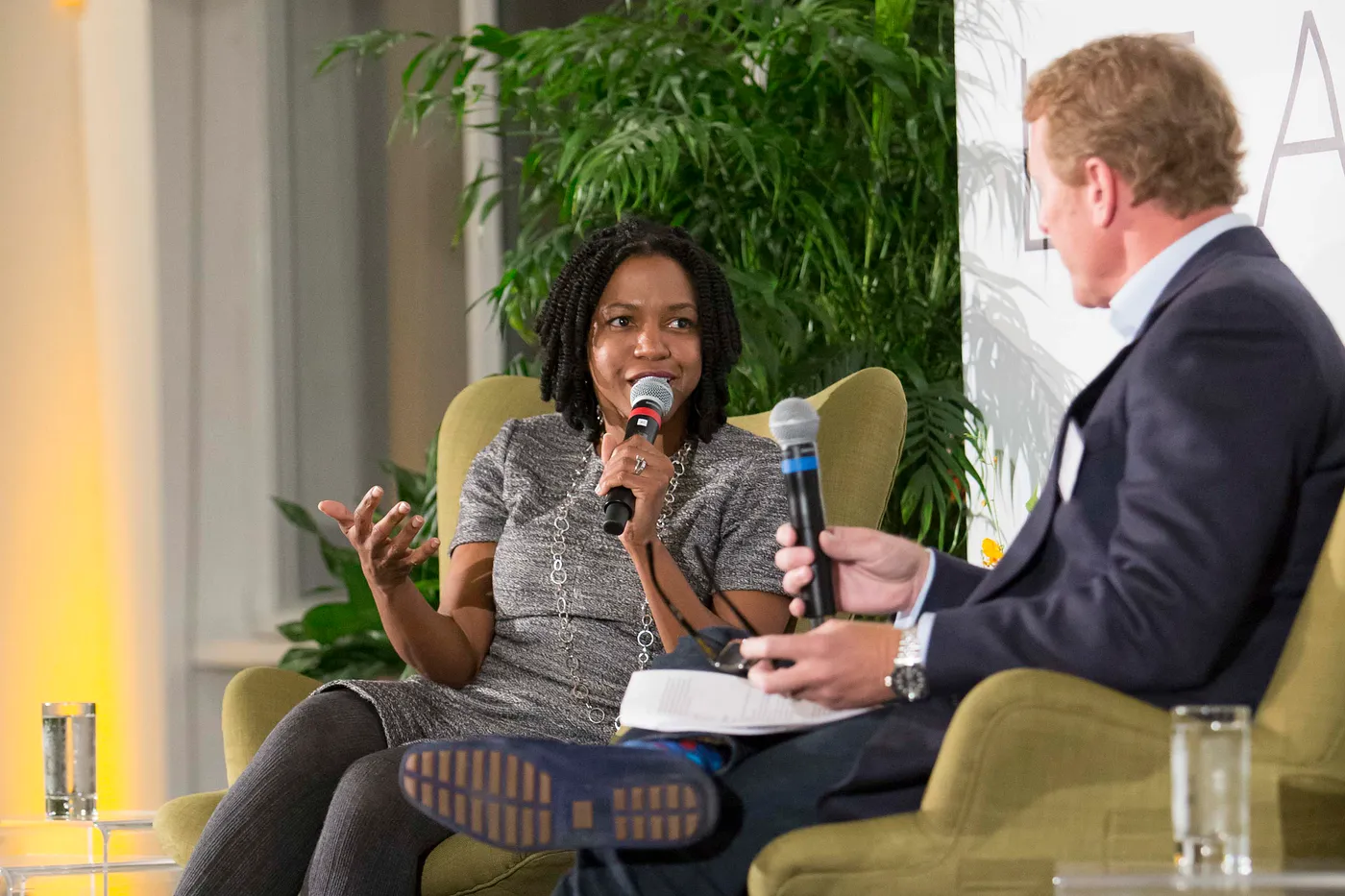
TaskRabbit Cracked the Code on the Gig Economy
I was fortunate to have the opportunity to work with the leadership team at TaskRabbit over the last couple years.
What I saw is a company that is maniacal about proving out the viability of their business model. Behind the pioneering vision of Leah Busque, the leadership and operational excellence of Stacy Brown-Philpot, and a team intensely committed to their purpose, TaskRabbit’s operating metrics improved month after month after month…. and they eventually reached that elusive combination of high growth and profitability.
The ironic part of the story is that while many of their gig economy peers sprinted like a hare to burn vast amounts of cash in order to fuel growth, TaskRabbit took a more measured and disciplined approach to reach the proverbial finish line.
There’s no doubt in my mind that TaskRabbit will flourish under the IKEA platform. I look forward to continuing my relationship with TaskRabbit as a happy customer. Congratulations to the TaskRabbit team!
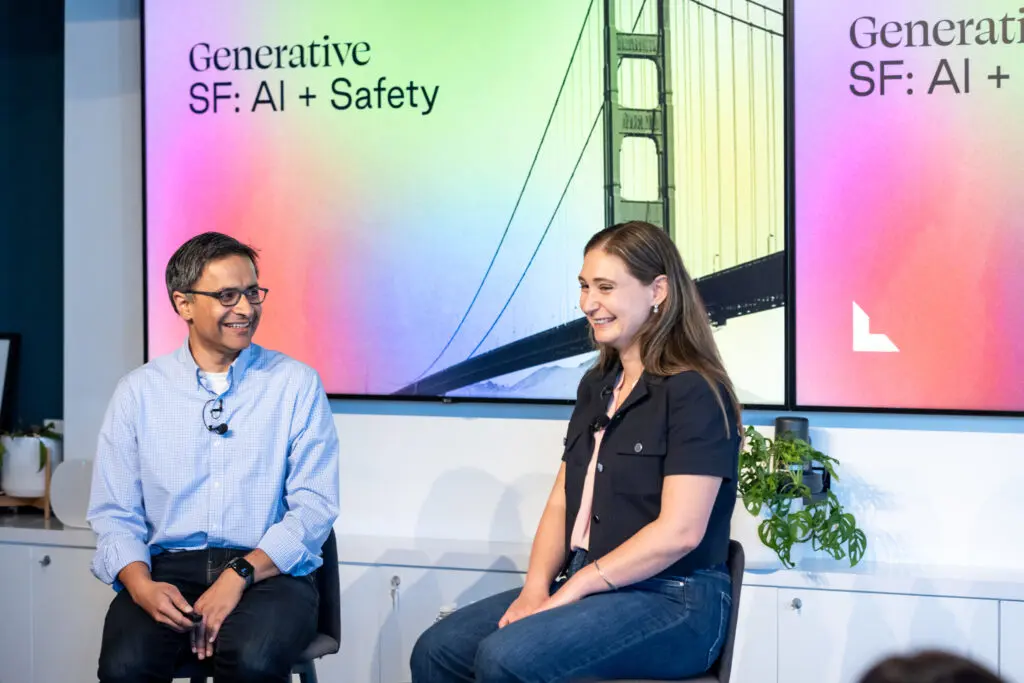
How Anthropic is building better, safer AI models
At our most recent #GenSF event, Anthropic co-founder Daniela Amodei reveals the secrets of her company’s wild success.
The path to AGI
These AI models have become incredibly powerful. How far along are we on the path to artificial general intelligence?
People used to imagine a future where tools are better than humans at everything and ask, ‘What would it be like to live in such a world?’ Well, in many ways, we already do.
Claude is a better coder than me, a better writer, way more empathetic and patient than basically anyone. And while all LLMs hallucinate, Claude’s body of knowledge far surpasses that of any human. So when we think about AGI, we like to ask, what are the practical implications of this? What will that mean for businesses, the economy, and individuals?
Our hopeful vision for the future is that these models will continue to advance, with guardrails in place to make sure no very bad things happen. Assuming we get that right, we continue to create a world where everyone can thrive and where people can do their most creative work without having to do all the boring stuff Claude is much better at.
Interested in attending a Generative Live event? Sign up here to receive notifications about future meetups, and be sure to listen to the Generative Now podcast, where AI builders talk about how they’re creating the future.
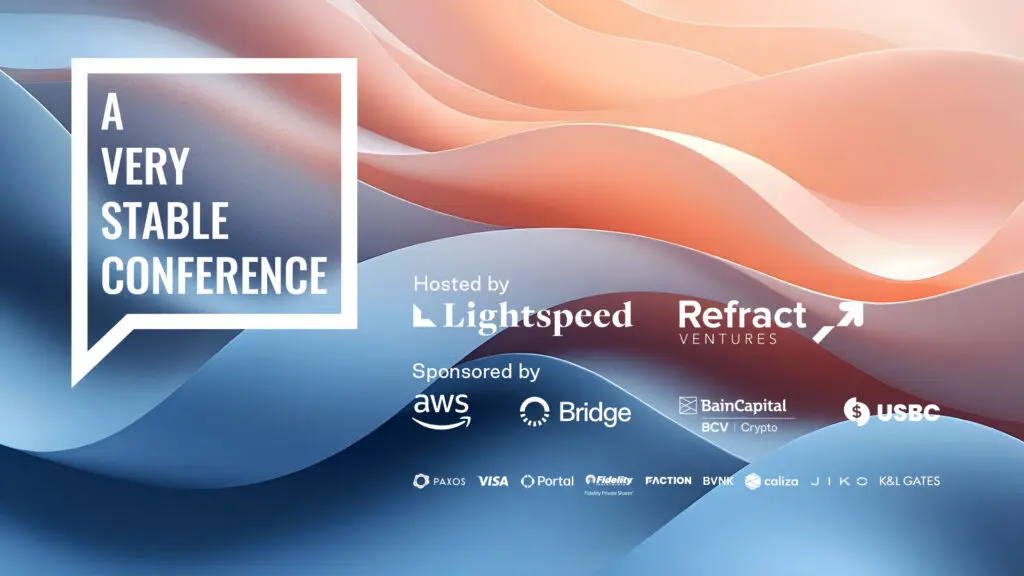
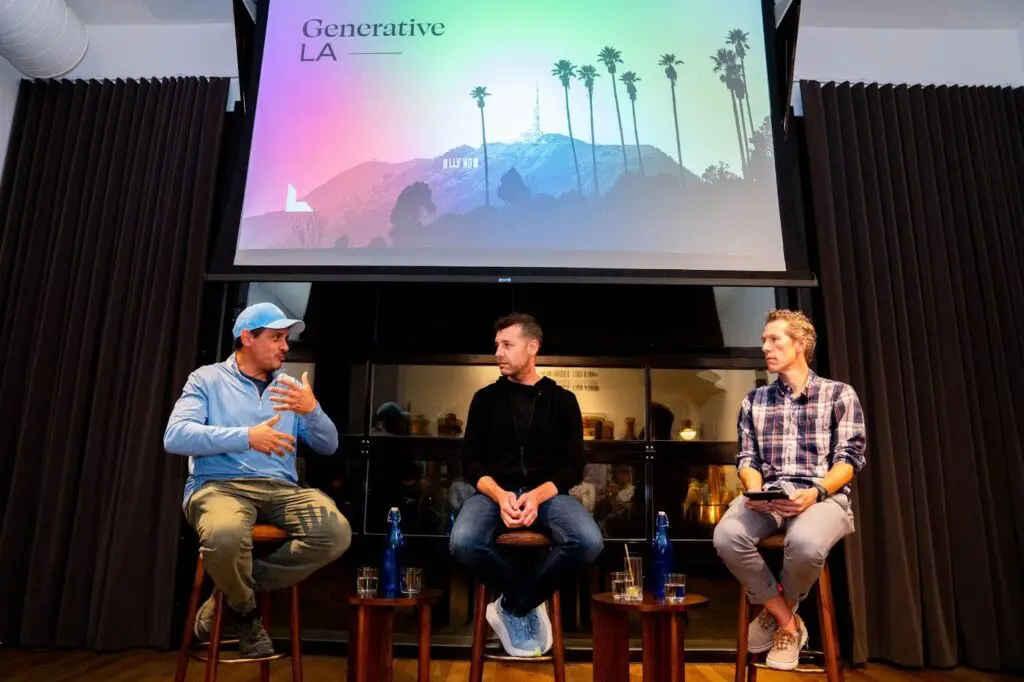
Talking Generative AI with PayPal and Brex
Key takeaways from #GenLA featuring Drew Tennenbaum, Vice President of Consumer Experiences at PayPal, and Cosmin Nicolaescu, former Chief Technology Officer of Brex.
This fall, Lightspeed hosted the latest in its Generative AI meetup series in Los Angeles, featuring a fireside chat with Drew Tennenbaum, Vice President of Consumer Experiences at PayPal, and Cosmin Nicolaescu, former Chief Technology Officer of Brex. The discussion was moderated by Justin Overdorff, Partner at Lightspeed, and centered around key areas where AI presents unique challenges and opportunities in fintech.
Below are highlights of the conversation, edited for clarity and brevity.
What is AI’s current place in Fintech?
During the past two years, there have been a lot of exciting discussions about AI disrupting industries overnight — discussions that were perhaps a bit exuberant and have caused some subdued conversations of an AI bubble. The panel, for its part, was still feeling bullish while admitting that AI isn’t quite there yet, especially in Fintech. They saw positive developments, however, in the abilities of LLMs to do math. Nicolaescu noted that models’ error rates are “much smaller” than previously. What still concerns him, though, is that the remaining errors are much harder to spot and don’t always align between different models.
But once these problems are fixed, incredible efficiencies will emerge. For instance, models will ostensibly be able to extract large amounts of data from contracts and then help finance teams analyze it to figure out better procurement procedures or how best to model revenue recognition. These tasks require such incredible computational power, however, that they fail drastically if there are any errors with their inputs. The models are almost there… but not quite.
Does AI in Fintech currently offer better opportunities for startups or incumbents?
It depends. According to Tennenbaum, PayPal’s consumer and merchant network sides are strengths that most startups will have a hard time competing against. However, “startups move so much faster than companies like PayPal do,” he said, caveating this with the observation that a company’s ability to move fast also depends on its leadership. Recent leadership changes at PayPal have created a new sense of urgency that helps give the company the ability to be a “first mover” like a startup.
Nicolaescu, for his part, thought that startups have an edge, “Because they can build something from scratch with the DNA of AI and try things they have never done before.” He admitted there were exceptions, though. “On the B2B side, I think large companies have the advantage because there’s so much more about the ecosystem, the workflows, and so the power of distribution is so much more powerful there.”
How has AI changed the hiring process and how you evaluate teams?
Even if AI hasn’t changed things much yet, it will. Tennenbaum observed that the number of job candidates using ChatGPT and other LLMs in the hiring process is becoming much greater. “So, I think the right thing to do is figure out how to adjust the hiring process to deal with that,” he said.
According to Nicolaescu, companies should start reevaluating skills that will increasingly be done by AI, such as certain engineering tasks that will probably be done automatically in the future. However, the devaluation of some skills will probably be offset by other skills becoming more valuable. “Eighty percent of my skills are pretty much going to zero,” he remembered hearing one engineer say, “But the other twenty percent are actually growing exponentially.”
What are the biggest opportunities in Fintech right now?
The panel was excited about opportunities with large amounts of unstructured text and AI’s potential to help humans make sense of it and perform time-consuming tasks much faster. For Tennenbaum, however, the richest opportunities aren’t necessarily in the Fintech space. They’re in HR-type tasks and optimizing workflows–areas where a lot of time is wasted. Nicolaescu agreed, urging people to examine business areas where companies are generally hesitant to invest such as procurement, IT, and HR. Instead of investing in a team, many companies will probably be willing to simply invest in a piece of software if it can perform the job well enough.
Nicolaescu had a warning, though. If your company does something well, “The market will come with more companies that just copy you, and they will move faster because they have the advantage of copying what you’ve done,” he said. “They don’t have to innovate as much, and so you constantly have to be ahead of them.”
Interested in attending a Generative event sign up here to receive notifications about future meetups, and be sure to listen to the Generative Now podcast, where AI builders talk about how they’re creating the future.
The content here should not be viewed as investment advice, nor does it constitute an offer to sell, or a solicitation of an offer to buy, any securities. Certain statements herein are the opinions and beliefs of Lightspeed; other market participants could take different views.
